#which I LOVED because it developed upon that initial dialogue of his where he reveals how alone he really is!
Explore tagged Tumblr posts
Text
it’s completely bananas to me that halsin's sex scene features a moment where he somehow loses control of his druidic powers and wildshapes into a bear, because he’s apparently that horny. like...gale had to be infected with a mindflayer tadpole for him to make mistakes in his spellcasting, even though he already carried a small nuclear bomb of evil, weave-consuming magic in his chest. what THE fuck is halsin’s excuse? like, as funny as it is for an archdruid to be so overcome with lust upon seeing a tdick that he loses his grip on his abilities, it makes absolutely no sense! what do you mean that this guy has enough power to open a portal to the shadowfell, and rescue a little fey boy from it, but he can't control his wildshaping because "bear horny?" HUH?
#bg3#thoughts about media#the more I think about halsin and SH. the more I grow resentful of their writer in specific.#genuinely. what the hell was this guy thinking.#like how is this scene meant to be sexy?#as a monsterfucker- I GET the appeal of a man fighting his “inner beast” to be with his partner.#but it doesn't come across that way in the halsin scene. it feels...silly? nonsensical?#he's an extremely powerful druid....losing control of his wildshape because he's aroused makes him look...immature.#is the appeal of halsin not that he is an experienced but lonely older man?#when confessing to your player character- he expresses his appreciation for the care with which the PC has treated him.#which I LOVED because it developed upon that initial dialogue of his where he reveals how alone he really is!#his family is all gone...so he only had the grove.#but the people at the grove held him in such high regard...it was like he wasn't a person anymore. just a “leader.”#it makes perfect sense to me that he would fall for someone who treats his feelings as important...who treats him like a person!#but the sex scene devolves so rapidly into...god...something out of a badly written fanfic?#honestly- forget the wildshaping. your PC should have had the opportunity to top halsin.#it would have made MUCH more sense given why he's even attracted to your PC in the first place.
6 notes
·
View notes
Text
Romance in Samurai Champloo: The Mirror Reflection of Jin and Shino and Mugen and Fuu
Upon re-watching Episode 11, I was utterly shocked by how many parallels exist between Mugen and Jin as characters, in regards to their relationship with the most important women of their journey. The interactions and concepts are near identical. These specific themes and interactions were only exhibited with two specific women, and no other characters in the series.
In episode 11, Jin falls in love with Shino: a courtesan who was forced into prostitution due to her lousy, abusive husband's gambling debt. Jin later saves Shino from this brothel, and helps her escape to a divorce temple.
Canonically, it was stated in the Samurai Champloo Roman Album by Shino’s character designer that Jin does indeed "fall for" her, so it was not simply chivalry that led him to help her. This echoes his actual dialogue in episode 11:
Fuu: I understand why you pity her but-
Jin: It’s not pity.
It is not pity, because it is love.
So, here is the INSANE number of ways Jin's confirmed romantic dynamic with Shino is an uncanny mirror to Mugen's subtle romantic dynamic with Fuu.
Warning: There is a LOT of comparisons. I was honestly so surprised and have a whole new level of respect for this anime now, and specifically Episode 11.
Enjoy the read!
The First Meeting: Saving the Girl and Reading Her Mind
Both Mugen and Jin save a woman’s life at their first encounter. Both also know the girl is in trouble without ever being told.
Both Fuu and Shino reject the notion that they need help. But it is revealed later that they do.
Jin meets Shino on a bridge and saves her life. She confesses much later, that she had been contemplating suicide, but because he stopped to talk with her, she did not go through with it.


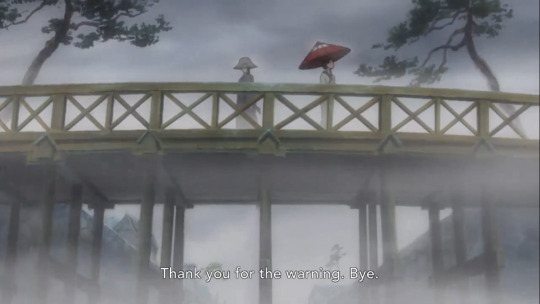
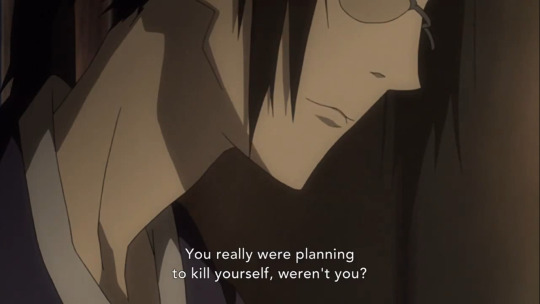
Never did Shino ever show any indication she wanted to drown herself, other than looking at the canal. Jin just knew the moment he walked by.
Mugen meets Fuu in the tea house and saves her life. The magistrate's son was going to have her mutilated and killed. But because Mugen talked with her, she was able to strike a deal of killing them for 100 dumplings.
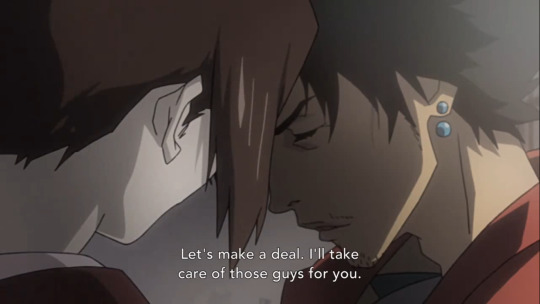
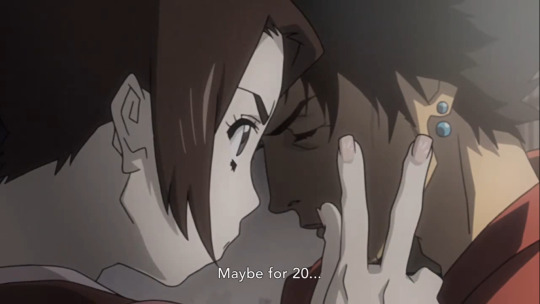
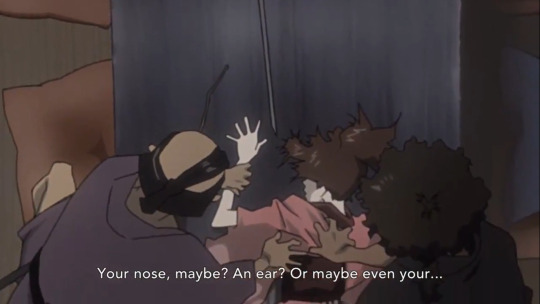

Never did Fuu tell Mugen that the guys were giving her trouble. Mugen just knew the moment he walked in.
In addition to this first meeting, Jin also stops Shino’s husband from beating her. Mugen also stops Umanousuke from beating Fuu in Episode 25.
Thinking in the Rain: Love Interest Trapped in a Brothel
Previously, in Episodes 3+4, Fuu was thrown into a brothel, just like Shino's predicament in episode 11.
After Mugen skips town and ditches the Yakuza, the thought of Fuu stuck in the brothel invades his mind, and compels him to turn back.
Note: Jin never thinks about Fuu stuck in the brothel.
After being unable to afford Shino, Jin is beaten by bouncers and trudges away, thinking about how Shino is sleeping with another man.
Both of these incidences occur during heavy rain.
Both think about their love interests trapped in the brothel which leads them to return to save them.




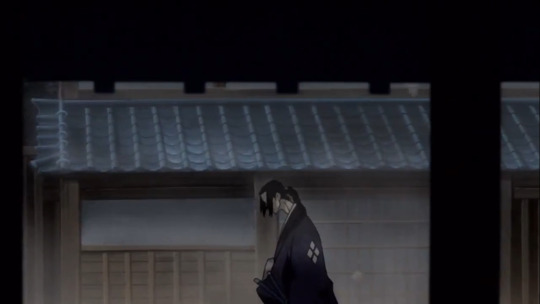
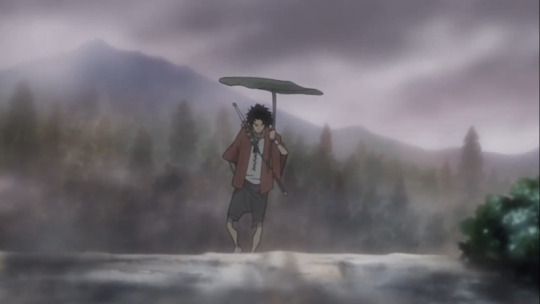
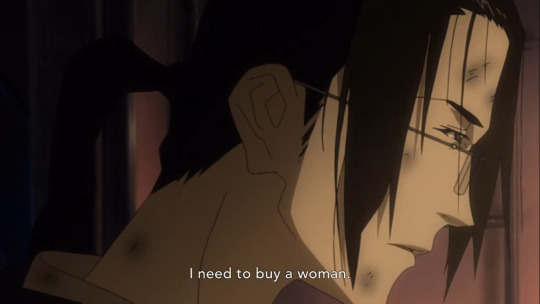

The Brothel Escape.
Both Mugen and Jin attempt to break their love interests out of a brothel.
On the second night they spend together, Jin concocts a plan to sneak Shino out of the brothel.
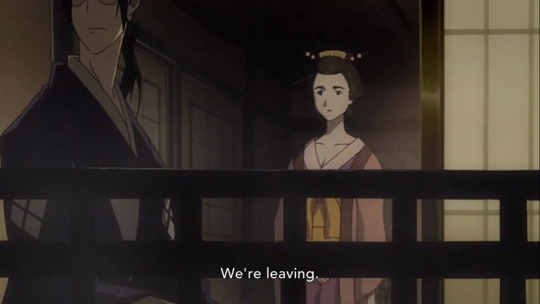

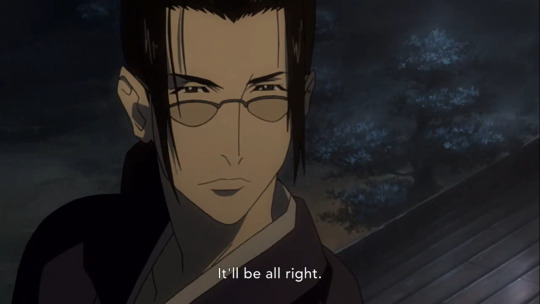

Never one to be discrete, Mugen’s plan to save Fuu involves breaking into the brothel, kicking open the cage doors, and pulling her out. However, to keep the MugenxFuu romance subtle and to have shippers rip their hair out Fuu escapes alone, and she never finds out about Mugen’s wild attempt to get her back. So, we never get the obviously romantic scene of him grabbing her arm and whisking her away. We just know that poor Mugen tried.


There is evident blood on his sword. He killed a person or multiple people to get back to her.
Mugen could have taken and freed any of these lovely ladies. But no.

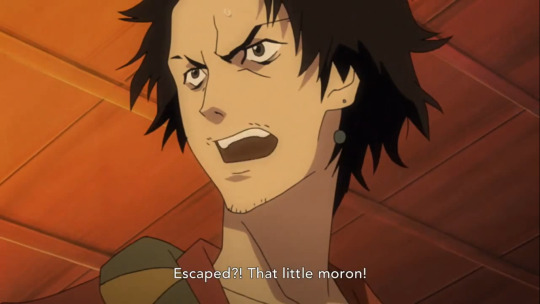
Note: Jin is seen putting no effort into saving Fuu at all. When Jin initially sneaks into the brothel of Episode 3+4 disguised as a woman, he had no idea Fuu was there at the time. He was just helping the boy Sousuke save Osuzu. Later, even when he sees Fuu there, Jin never is shown putting in any effort to rescue her, nor thinking about it. If we assume he intended to, with his roundabout way of being involved with the Kawara gang, (who he was already helping anyway), Fuu would have already been bought by a client, because she was. (luckily the client did not have sex with her).
If this isn't enough of a mirror, Fuu and Shino escape the brothel in the exact same way: tying a series of clothes to the porch and sliding out the window.
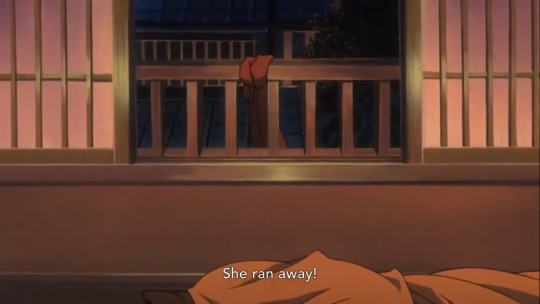
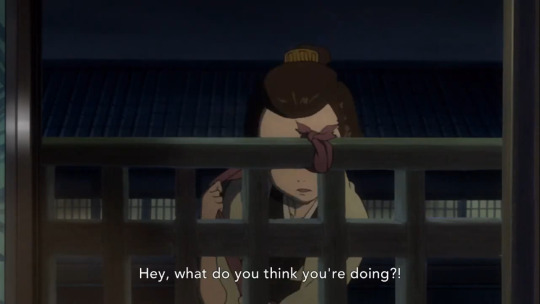
Giving Up One’s Sword For a Woman
Shown in both episodes 6 and 8, Jin is extremely protective of his katana, saying that his swords are the equivalent of his soul as a samurai.
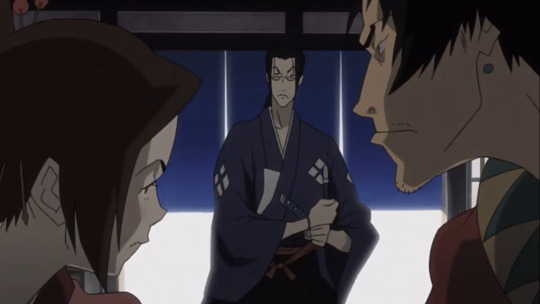
He adamantly refuses to part with them for any reason. He is also shown in episodes 14, 16 and 20 diligently polishing them.
On a different note, Mugen is not shown taking care of his swords as meticulously as Jin, nor as protectively. He is willing to pawn them off if it means being able to eat: shown in episode 6 and episode 8.
But his sword is no less important to Mugen, as he is shown carrying the same sai handled tsurugi in his flashbacks in the Ryukyuan Islands, implying he had carried it for a long time. For Mugen, the sword has nothing to do with some code of bushido, or philosophy. It serves the fundamental purpose of keeping him alive, which is something Mugen constantly struggles with.
In a brothel, swords are not allowed, as it is unsafe for the courtesans if there happened to be a violent client.
In Episode 25, Umanousuke is about to kill Fuu when Mugen arrives.
To spend time with Shino and free her, Jin willingly gives up his swords.


To save Fuu’s life and free her, Mugen gives up his sword in Episode 25.
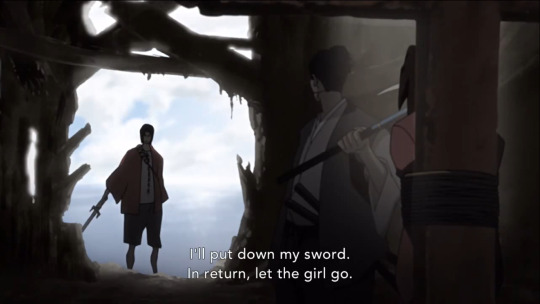

Note: The only other example we have of Jin “giving up his swords” is comedy when Mugen and Fuu confiscates his swords against his will, so they can enter an eating contest in Episode 6.
Interestingly, the two men gave up their swords under reversed circumstances, yet with the same intentions.
Jin, who has always cherished his katana, ends up giving them up in a moment that he logically "shouldn't". He does what could be considered a frivolous activity of spending time with a prostitute, which completely goes against his personal code as a samurai.
Mugen, who had always been willing to give up his sword for the sake of survival, finally needs to keep his sword, or he will be brutally tortured and killed by Umanousuke. But instead, he gives it up anyway in this extremely critical moment, to save Fuu's life.
In the end, both men resorted to giving up their swords for one simple reason: love.
Red and Pink Color Composition
This one was very surprising for me, and the reason I ended up writing this entire post. The other examples until now are more obvious. But this? Mugen and Fuu's main colors are obviously red and pink. But...Jin and Shino?
Shino’s kimono color is light green, with a dark green collar. Jin’s color is dark blue.
However, when Shino is put in the brothel and takes on the name “Kohana”, she is seen throughout the majority of the episode wearing pink, with a burgundy collar. This is exactly Fuu’s kimono colors, and no other character in the series wears these colors that I can recall.
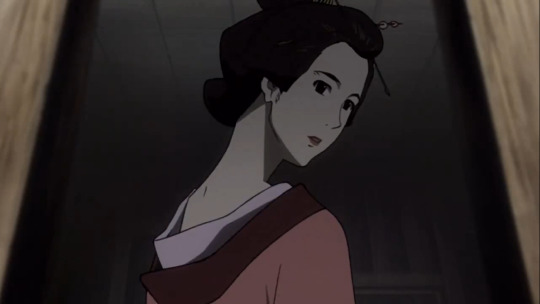
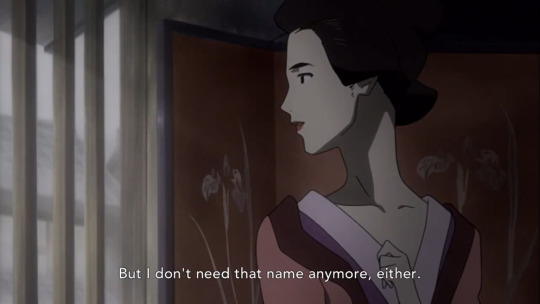
More interesting, is Shino’s brothel name becomes “Kohana”.
Kohana means “Flower Child”.
Fuu is the child of the “Sunflower Samurai”.
For the first time, I was suddenly faced with a serious question of "Was this name choice and kimono color put as a symbolism of Jin choosing to buy a woman that resembled Fuu?" And in turn, would this be one solid way to disprove so much that I've always thought and written about Jin being the father figure to Fuu?
But, then I noticed something else.
Shino only wears this pink and burgundy kimono in the brothel. It is not her true outfit.
And it is not only her who gets a "change" in appearance. Jin does too, in a sense. He gets an addition to his ensemble, only for this particular episode.
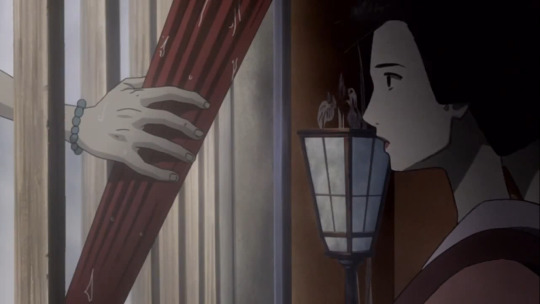

Every time Jin visits Shino in pink, he carries a bright red umbrella. Whenever she is in green, he does not have the umbrella. He visits her on four separate occasions when she’s a courtesan, always with the umbrella in tow.
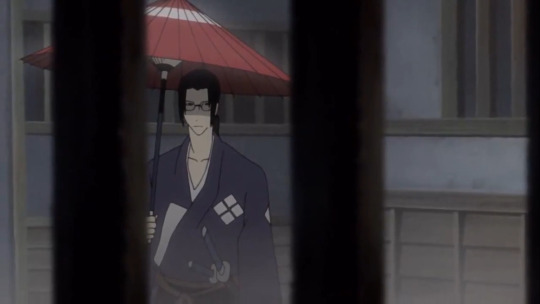
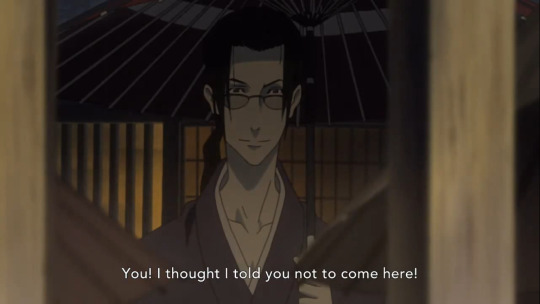

The red umbrella is visually striking, as the atmosphere of this episode is particularly drab due to the rainfall.
The red umbrella becomes the connection between Jin and Shino during her stay in the brothel. It is significant, because it was initially hers, and was a gift to him since she had no use for it in the brothel anymore.
One can argue, “It’s raining and he just needed an umbrella.” But during his depressing walk, he carries it, but doesn't even use it, and we don’t even get to see it or its striking red color. (Which I will explain my interpretation as to why shortly).

We only know he’s holding it, because he continues to have it afterwards.
It is far more a symbol of his connection to her, than for practical use. Watching the episode, everyone else has drab brown and gray umbrellas. Even in Episode 4, Jin donned a drab brown umbrella.
In Japanese culture, red is famously the color that represents the “main character”. This is extremely common in many anime and video games, and particularly shown in the Super Sentai genre, in which every season since 1975 to present, the main character always dons red.
In the case of Samurai Champloo as well, Mugen is confirmed to be the “main character”, first developed by Shinichiro Watanabe, with Jin created later as his foil so the story did not become “one dimensional”, as he said. This is why most episodes focus on Mugen.
Episode 11 is the very first episode that focuses on Jin. Up until this point, Jin was never a rescuer. (He doesn’t even rescue Fuu until Episode 26).
With Shino, he finally fulfills the "noble hero saving the maiden" role.
More interesting, is the scene where the brothel bouncers attack Jin, who intentionally decides not to fight back. Jin loses his grip on the umbrella. This is my personal interpretation, but I think this could be a representation that Jin could not protect Shino, as she is forced to have sex moments later.
If it were Mugen being attacked, he would kill the men, repercussions or not, just as he did to the Yakuza in Episode 4. Mugen will always embody the “passionate red” that he wears.
But it does not suit Jin. He has chosen the lawful path, unlike Mugen’s chaotic nature of killing whoever stands in his way. Jin does not kill these men, since he has no reasonable cause, and does not risk the repercussions. It is his own fault, not theirs, that he can’t purchase or protect Shino.
In this scene, he not only drops the red umbrella, but Shino also drops her pink robes when she is undressed. They are not red and pink: they are not Mugen and Fuu. They are back to the cruel reality of being a different, more tragic tale of love in which he can’t protect her.
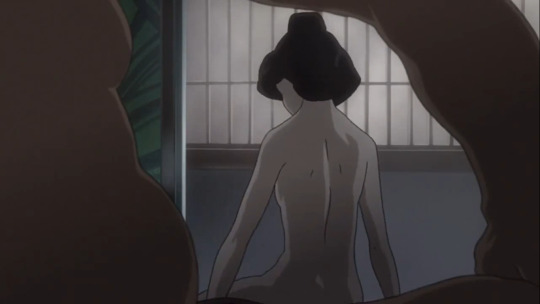

One of the attackers even picks up the umbrella, and throws it at him, as if to add more injury to insult in his failure.
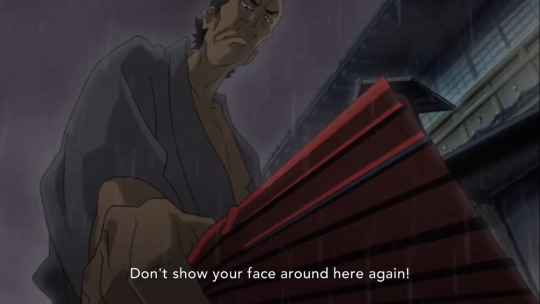
In the ending of the episode, Shino no longer wears pink and burgundy, and is back in her original green kimono. Interestingly, Jin stops using this red umbrella at the exact same point she is back in green.
Since Shino is no longer a “maiden in distress in pink”, Jin no longer needs to be the “hero in red”. They no longer have to play this role. Their episode is at its close. The anime will return to Mugen and Fuu carrying out the dynamic of “hero and maiden”.
Jin will once again, play the role as the cool and collected “rival in blue” that foils the main protagonist.
One could still argue these color choices of red and pink were random and thoughtless. They very well could be. But, this is a Watanabe work, and colors often hold surprising symbolism in the anime he directs.
As a more solid example of color symbolism: here is a link to a fascinating video that reveals just how intentional the color palette is in Samurai Champloo's Episode 14. The choice of Mukuro's yellow versus Mugen's red and the episode ending on Koza in gray was all deliberate and was repeatedly shown in the episode's composition through various means, to subtly convey the story.
Flashing the Coin and “Buying”a Woman
Jin is shown to be the character who makes/finds money for the group the most. Even in this episode, he was working for the eel stand. Mugen meanwhile, makes money and spends it selfishly. But in this episode, it is Mugen making the money and Jin demanding it for a selfish purpose, reversing their roles once again. Jin is the main character now, and Mugen the foil.
Mugen flaunts the coin he made to impress Fuu, demanding her validation by tapping her head.

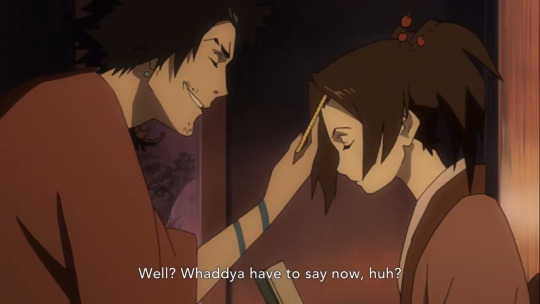
Jin flaunts the same exact coin (Mugen gave it to him), in a very similar way, to show he’s buying Shino.


Both men, in essence, are "buying time with a woman".
While Jin is, in a literal sense, using the money to purchase a prostitute, Mugen's is more figurative.
Mugen gives the money to Jin, causing him to go away, and leaving him and Fuu alone. Once Jin is back, they will once again be a trio, and the “pairing dynamic” between them will be shattered. But for that brief night, Mugen got time with Fuu.
Mugen, despite acting like he detests Fuu's company, does some very strange and completely uncharacteristic things in this episode. For one...he is the one to bring Fuu to the beetle wrestling match. Her dialogue implies she didn't want to go and Mugen dragged her along.

Then, despite being all stingy about the money with Fuu, he willingly gives the money to Jin to send him away to go to a brothel. For a man Mugen claims to despise, this is a remarkably thoughtful act. Especially when he said he was going to use the money to buy seeds to make more in beetle wrestling. Strangest of all, Mugen doesn't use the money himself for a prostitute. He chooses to stay at an inn, alone with Fuu, rather than the prospect of going to the brothel in town, even when he’s repeatedly shown being a womanizer.
I think this act shows both his selfish desire to spend time with Fuu alone, but also his selfless care for Jin as a friend. He killed two birds with one stone. In both cases, these are things Mugen would never admit to his companions.
With the exchange of that on koban coin between them, both Mugen and Jin have "bought time" with their respective love interests.
Helping to Save Each Other's Love Interest.
In every episode Fuu gets into trouble, Mugen is the one who saves Fuu, if she isn’t saving herself. Jin does not. But there is one exception to this: Episode 26. Jin saves Fuu for the first time, in the one moment Mugen can't, while also simultaneously avenging his father figure Mariya Enshirou.
In episode 11, Jin does not have his swords on him. But Mugen and Fuu arrive. Mugen cuts down many men to help them escape. And in addition, he knocks down a man right in front of Shino that Jin failed to incapacitate, before telling Jin “You’re pathetic!”
The Windowsill and the Mirror in the Same Room
This one is a very, VERY minor comparison, so don’t take this one seriously. I just thought the imagery was similar.
In Episode 18, where Mugen attempts to win Fuu in a tagging contest (yes, that was actually the plot: Here's a Post About It), Mugen and Fuu spend a small moment in the inn room alone.
In this inn room, Fuu is looking at herself in the mirror, when Mugen appears behind her.

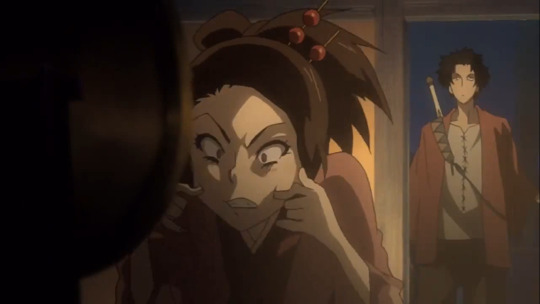
Their faces are wonderful.
In the brothel room, Shino also looks in the mirror, when Jin is shown behind her.
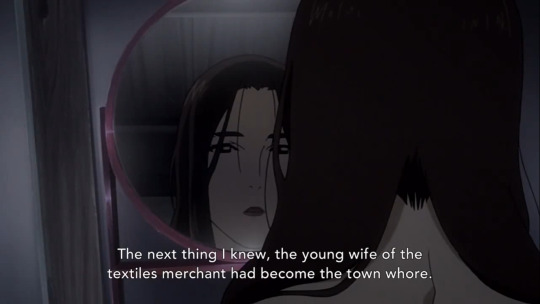
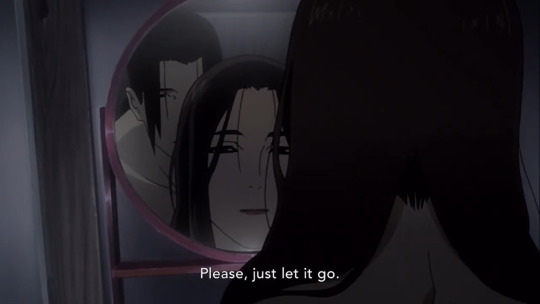
Alone with their love interests, they sit on windowsills.

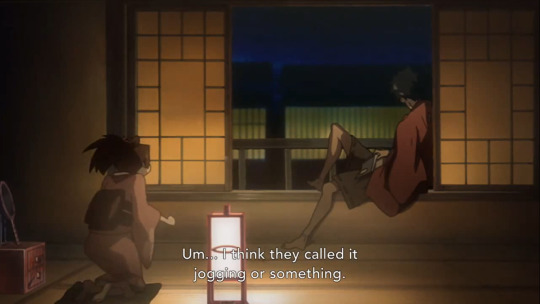
Again, very, very minor and I highly doubt it was intentional. But there is no other moment of window sill sitting that I can recall.
There is one other gazing into a mirror though: the end credits of Fuu and her mother. This relates her mother to Shino, aside from the fact that they have the same exact hair and wear green kimonos, and who are in love with a poor samurai who ends up wearing gray.
Parting Ways
In the defining moment of Jin and Shino parting, there is a distance of water separating them. But Jin must let her go to the temple to be free of the marriage: her final goal.
In the defining moment of Mugen and Fuu parting, a distance of the Church with Umanousuke is in the way, separating them. But Mugen tells her to go see her Sunflower Samurai: her final goal.
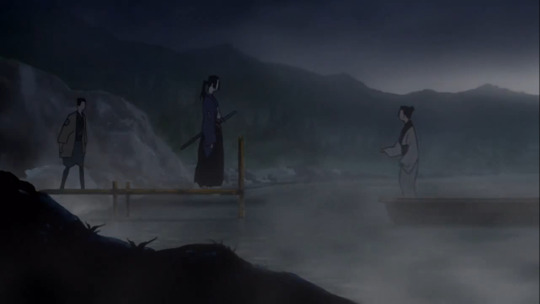

Neither Jin and Shino or Mugen and Fuu are allowed to touch or to embrace before this forced goodbye.
Jin is the one to push the boat away, even when Shino tries to reach out to him.
Mugen is the one who urges Fuu to run, even when Fuu hesitates and wants to stay.
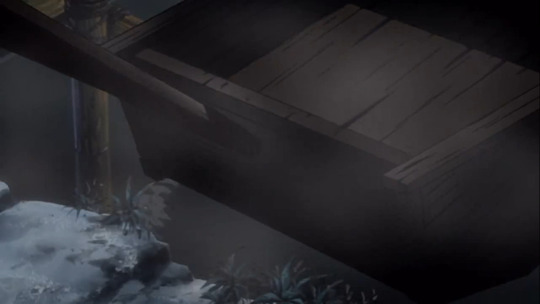

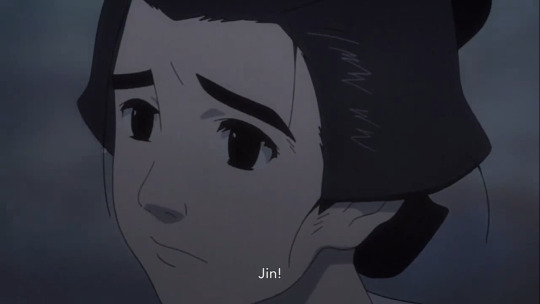

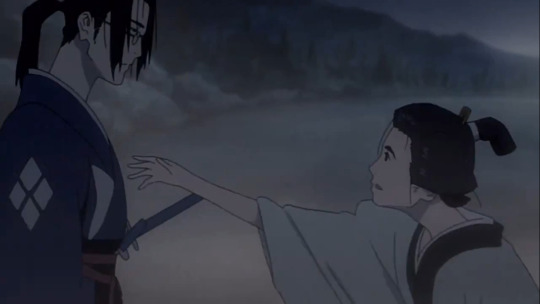

Both Shino and Fuu are reluctant to leave Jin and Mugen behind.
Mugen and Jin remain stoic, even when their emotions must be running wild.
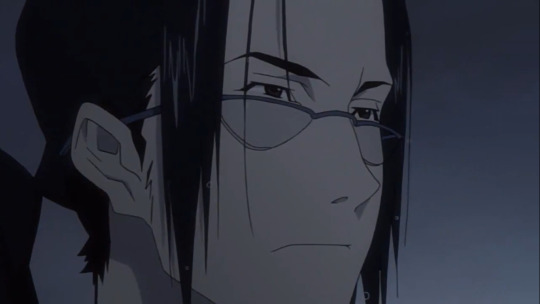

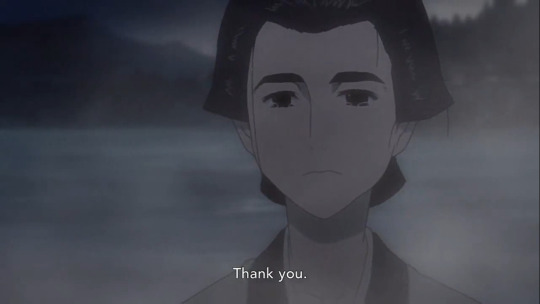
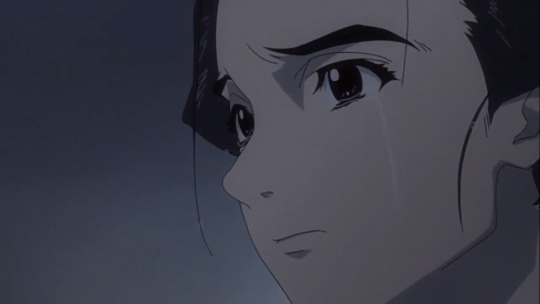
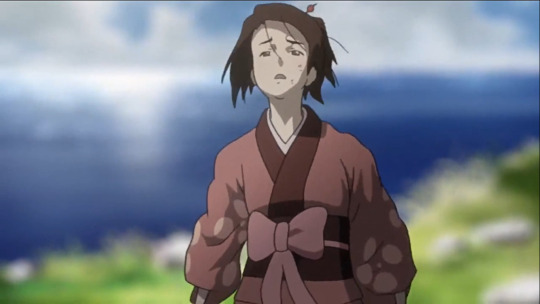

Fuu and Shino’s eyes well up, until they are unable to hold in the tears.
“The Love Triangle” Dilemma: A Lousy Gambler, A Noble Samurai and a Pure Maiden
Now, I am not saying that Mugen, Fuu and Jin is an actual love triangle. I firmly believe it isn't, as I have shown the evidence of the two romances above.
But I believe in Mugen's mind, there is a love triangle, and he’s the odd one out.
Yes, there is a sense that Fuu has insecurity about Jin's abandonment and is jealous of his attention to Shino. Personally though, I think this is in more relation to her father's abandonment, as Jin and Shino strikingly resemble Fuu's father and mother. Jin even gets Fuu’s father’s kimono in Episode 26, and likely his katana too, as his were broken.
But that aside, the relationship dynamics going on in Episode 11 are painfully satirical.
Shino, her husband, and Jin are an ugly representation of Fuu, Mugen, and Jin.
Jin is interfering with both of these "couples".
Shino's husband is an avid gambler, who fell into debt, causing her to be thrown into prostitution. It is no coincidence that Mugen is avidly gambling throughout this episode, and being chastised by Fuu.
Fuu’s words to Mugen are Shino’s words to her husband.
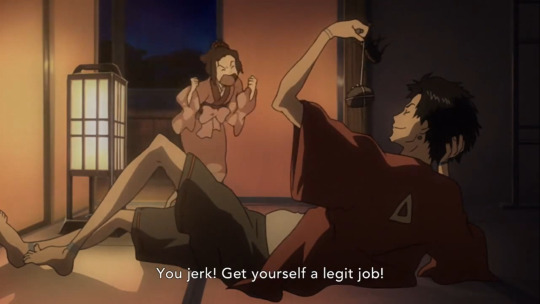

Mugen is being portrayed as the "lesser man", lacking in morals, while Jin takes on the mantle of the “gallant knight”. This again relates to the earlier concept that Jin has for the first time assumed the position as the “main character”.
This is likely why they chose “Gamblers and Gallantry” as the English title for Episode 11. Note that Gamblers is plural. (Also, the original Japanese title is Fallen Angel).
Fuu’s “jealousy” in this episode is used in the narrative to make Mugen believe she loves Jin, and not him. We see this again, in Episode 20. The one and only time Fuu cries for Jin is comical, compared to her over five emotional times for Mugen, still causes Mugen to stomp off with jealousy and annoyance.
Our first indicator of Mugen harboring jealousy of Jin stems from Episode 11 and piles up more as the show goes on.
There is three separate implied occasions in this specific episode 11.
1. Mugen states that Fuu is jealous that Jin is seeing Shino. But when he says this, it is him to roll over away from her. It is almost a blatant indicator that he is sulking. Then, he feigns sleeping and snoring.
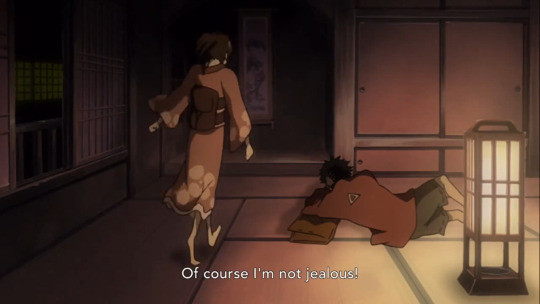
We know his sleeping is fake because upon closer inspection....
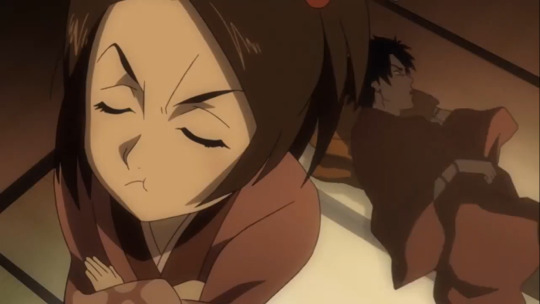
His eyes are open and his eyebrows are furled angrily. This “faking sleep” is a trick he repeats three times total in the anime, always concerning Jin and Fuu.
2. When Fuu gets upset at Jin about leaving the group for good, Mugen pretends to sleep yet again, but was listening to the whole thing.
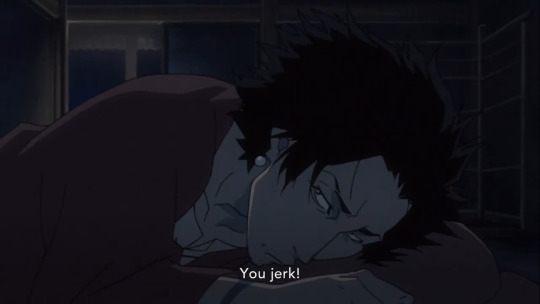
His facial expression is almost sad looking here. Very uncharacteristic indeed.
Note: The very last time Mugen pretends to sleep, is Episode 24, when Fuu hugs Jin on the riverbank. It appears here, that Mugen didn't hear or understand what they were talking quietly about. The dialogue is hard to interpret but it seems Fuu rejected Jin’s dutiful offer to stay with her after the journey close. She seems to confide her feelings for Mugen to Jin in this extremely subtle scene, by mentioning him out of the blue, crying, and then apologizing to Jin for it. Rather than embrace Fuu romantically, Jin comforts her with a hand upon her shoulder, in an understanding that is, by my interpretation, very fatherly.

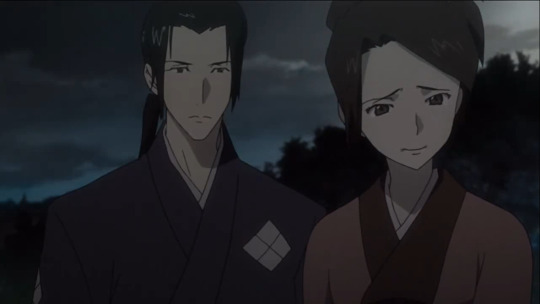
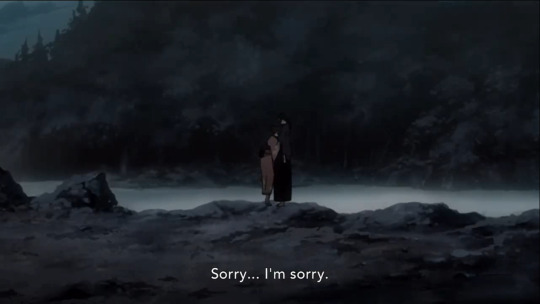



3. Back to Episode 11, when Fuu decides to help Jin, despite being angry at him for abandoning them, Mugen says some telling dialogue. This scene, Mugen and Fuu are running through town together, just as Jin and Shino are.
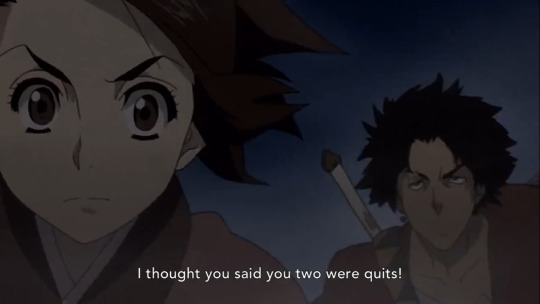
If Mugen only stuck around solely to kill Jin, then this exchange makes one question why is he still hanging around Fuu. We also know Mugen was listening the whole time when Jin states "If I don’t return, I want you two to continue your journey without me." It is as if he's trying to convince Fuu to be "over" with Jin.
But this isn't the only time Mugen is fine with taking Fuu to find the sunflower samurai alone. Mugen also agrees to travel with Fuu in ep 21 alone, when they think Jin is leaving for good with Sara, and makes no indication of leaving her to do battle with Jin.
Despite all the jealousy of Jin, and all the intentional comparison that Mugen bears with Shino's husband, we know Mugen is not actually like Shino's husband at all.
On the surface, perhaps, he seemed like an irresponsible, lawless lecher who frivolously wastes money. But in actuality, he is honorable and deeply cares about Fuu, saving her and worrying about her in every single episode something bad befalls her.. Mugen does more noble deeds for Fuu than Jin ever does.
While “Gamblers” apply to Mugen and Shino’s husband, the “Gallantry” applies to Mugen and Jin just as much.
That is why, unlike Shino’s husband, Mugen wins in gambling. And that is why, despite making money gambling, he generously gave it all to Jin.
The secretly gallant character of this episode was Mugen. Had he not given/borrowed this money to Jin, Jin would have never been able to save Shino at all.
How the Relationships Differ
While these comparisons highlight that Jin and Shino is equivalent to Mugen and Fuu, there are some directly opposite characteristics as well. Just as Mugen and Jin are opposite.
Jin and Shino are calm and quiet. Mugen and Fuu are passionate and loud.
Jin and Shino wear cold colors of green and blue, while Mugen and Fuu don warm colors of red and pink.
Shino is older than Jin. Fuu is younger than Mugen.
While Shino is forced to give herself to men and Jin can’t save her, Fuu is saved from this fate many times by Mugen.
Mugen and Fuu spend an entire, long journey together. Jin and Shino’s time together is fleeting. Mugen and Fuu appear together every episode. Jin and Shino only get one.
Ironically, Jin and Shino consummate their love in this short time, while Mugen and Fuu do not.
The relationships are remarkably the same story but from opposite ends of a spectrum.
Conclusion
Mugen and Jin may be opposites, but they are also like Yin and Yang. Both characters are a duality of one another, possessing opposite traits in their appearances and attitudes, and yet bearing similar beliefs and morals. In the love department, it turns out that they are also two sides of the very same coin.
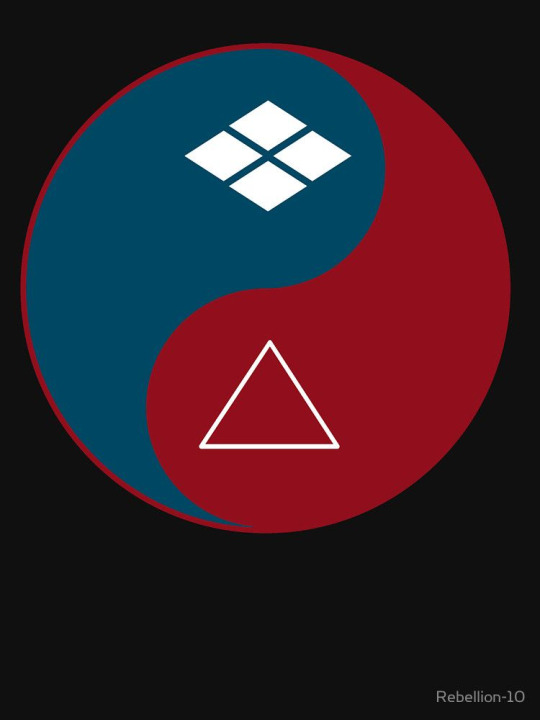
After discovering the parallels between these two romances, I was utterly blown away. This concept of duality is the entire point of Mugen and Jin’s dynamic in every other sense.
The love they bore for Fuu and Shino highlighted this concept in another new, astonishing way.
Mugen and Jin both bear something else in common. Even though Jin and Shino is far more an obvious romance due to the sexual consummation of the coupling, Jin and Mugen still relate in one way: they never directly express their love for Shino or Fuu words.
Jin comes off as “old fashioned” with his “I hope that the rain will never stop so I can stay here forever.”, Mugen comes off as “unromantic” by never saying kind and romantic words to Fuu. Their love was wholly expressed through action. Words are unneeded.
Finally, even though Jin and Shino part ways, and even though Mugen and Fuu (and Jin) part in the finale, hope still exists that they will meet again someday.
Both tales of love do not have tragic endings, but neither does either obtain closure. Their hopeful future is left up to you, the viewer, to determine.
Perhaps, their reunions with their loved one, will be a mirror too.

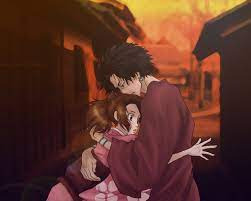
336 notes
·
View notes
Text
I finished World’s End Club
The hardest thing about completing a Kodaka or Uchikoshi game is always that bereft feeling; the knowledge in my heart that there’s nothing out there that will fulfill me as much as these guys’ stories do, and now I’m fresh out of their stuff once more. Y’know? It’s like “Well shit, now I have to settle for something lesser.”
Anyway. I finished World’s End Club. The whole thing took about 16 hours (according to the in-game clock on my save file), and I’m currently redoing a couple of stages for stickers that I missed. I doubt that’ll last me more than another hour, though, so I should be 100% finished at 17 hours. Granted, that’s with me bypassing the first hour because I’d already completed it in the demo... so that makes it around 18 hours long in total. Much shorter than the average Uchikoshi or Kodaka work, clearly!
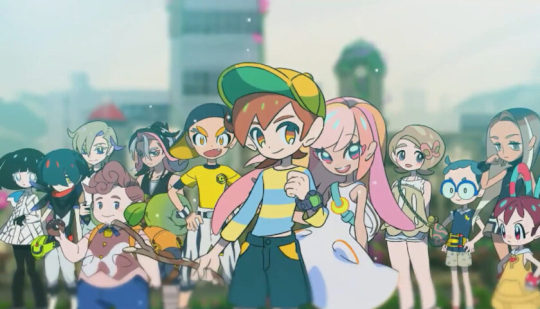
And man, they sure do pack a lot of twists and turns into those 18-or-so hours. Admittedly, there is time to slow down and talk to the characters to learn more about their backstories or what they’re thinking (typically during “Camp” scenes). But the other two types of scenes — “Story” and “Act” scenes — are chock-full of new reveals or weird plot developments up until like, hour 15. It’s all of the usual twistiness of an Uchikoshi story compacted into a shorter timeframe.
In addition to this being shorter than Uchikoshi’s or Kodaka’s most notable prior games, it’s also much lighter. Despite somewhat dark themes cropping up at a few points, this is a far kinder and more uplifting game than Zero Escape or Danganronpa ever were. I mean, hey, it’s about a group of 12-year-olds, so it almost necessitates that lighter tone.
I’ve mentioned this before, but I love the core cast of kids. Sure, there are a few of them who remained thin enough that I never got very attached to them, but I mean, it’s a pretty big cast. Most of the storytelling time is spent on the central plot, so I understand the shorthand of using some stereotypes in there. Some of them do get mined for depth. If there’s one problem with them, it’s that they’re too young for me to feel comfortable shipping any of them. :P They’re BABIES!

The bottom line here is that I loved the latest Uchikoshi-penned ride. I will remain in the tank for his works for a long time to come. But now, In order to actually list and go off on some of my (relatively few) gripes with the game, I have to get into Spoiler Mode.
MAJOR SPOILERS BELOW THE CUT!
SPOILER MODE ACTIVATED
Look; I didn’t love all of the twists thrown at us. I can come up with workarounds for some of the ones that bugged me, but let me go off on which twists most irritated me and why, okay?

First off, the reveal that all of the strange monsters and creatures were just “illusions” doesn’t make any sense. If they were just illusions, there’d be no physicality to them. So there’d be no way that a giant pillbug could abduct Pai, or that some Yetis could run off with Pochi or Yuki. So they’re very obviously NOT just illusions. Hell, while we’re at it, maybe we should inquire as to how we got “Game Over”’d by a bunch of things that weren’t there. Some of the available deaths are even specific to the exact form of the monsters we see, like if Reycho gets snapped up and chewed up by one of the large flytraps in Kagoshima. You’re telling me an illusion did that?! Maybe they’re some of MAIK’s robots that are projecting illusions around themselves or something? That seems like the best way to accept this. It keeps the basic spirit of what MAIK said to be true while also justifying how it could operate. And yet..... the game even goes so far as to claim that Pielope’s transformations are just illusions. For some, that makes sense, but we clearly physically interact with at least one of those transformations — the kids actually grab onto the Train Pielope and hold onto numerous individual parts of his transformation while riding the train. So again: That CAN’T be an illusion if you can grab onto all the parts of it. So... what gives? If Pielope never physically transforms, then how’d they grab all the pieces of her transformation like that?
The twist with Reycho doesn’t quite work logically, either. For starters, if you go back and read his “inner monologue” dialogue from the game, there are numerous instances where the dialogue doesn’t seem to fit with it being the thoughts of the “Otherworlder” OR Pochi, the two parties supposedly controlling him. The thoughts in question only work if Recyho was somehow thinking for himself already, so I guess we have to fanwank it and just assume that his “self-awareness” was starting to come through early? (I didn’t care for the reveal that Pochi was controlling Reycho either, because it has this whole tone of “You were controlling someone who never mattered because they were just being controlled by somebody else who wasn’t even the player character, ha-ha!” But the later twist that the “Otherworlder” was actually controlling Reycho made it better for me, so I’ll let it slide.)
The other thing that didn’t work for me is the reveal that Pochi is a robot. Even events that come AFTER this reveal are made more problematic as a result of it. First off, it makes it confusing as to how/why certain “X-Type” robots exist. I guess MAIK created the X-Type robots? Because he somehow reached the ability to communicate with another world? If so, where are the other X-Types? We know there have to be some others if Niyan and his gang are already familiar with the whole concept. What was their purpose? Did MAIK also program his own robots to have emotions? Because Pochi is clearly very emotional. Even though MAIK hates emotions... ? Perhaps this game isn’t meant to answer everything, and they’re setting up for some kind of sequel. I find that pretty unlikely, but I can’t say it’s impossible. However, the big reason I don’t like the Pochi Robot reveal isn’t really the logic problems with it. It’s that they knew we’d like Pochi because he’s an introverted gamer, but then the reveal of his true nature takes all that away. He was never a gamer at all. He wasn’t even all that shy. He was just keeping to himself to hide his true nature... and his “gaming” was just him controlling Reycho. So the things that your players were most likely to dig about him are utterly erased. So in the end, who is Pochi? He’s a compassionate, heroic, self-sacrificing protagonist. Which makes him a lot more generic.
A closing thought: If, by some miracle, this game ever gets a follow-up sequel or spinoff, I see a lot of potential in how they could mix and match the various characters’ abilities. I understand that the platforming isn’t really the point of the game, and that’s why it feels undercooked... but that also makes it the area that could most easily be improved upon. I was initially excited for the chance to be able to swap between characters so that I could have Mowchan turn into iron, then Reycho would throw him onto a ledge. Or maybe Pai could block an attacking enemy while Tattsun shoots it! Alas, this is a simpler game than that. And while I am ok with that, if they ever take another shot at it, it doesn’t have to be this straightforward and simple. They can have more fun with the platforming side. Let’s go ahead and mix and match our powers!
30 notes
·
View notes
Text
RWBY Review - Start to Finish -
RWBY VOL 1; CHAPTER 2 -
We ended on the line ‘Better shows were canceled for far less unforgivable sins on our last episode.’
There is a second part to this, which goes;
‘But a show has at least one season before something (that) drastic happens.’
I should have qualified that last statement because;

I know, I should have qualified my statement.
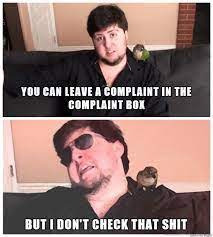
Moving on.
Chapter 2: The Shining Beacon -
Picking up from the airship ride upon which Chapter 1 ended, Chapter 2 begins with Ruby Rose taking her first steps onto Beacon Academy and fangirling about the weapons borne by the other students accompanying Ruby to Beacon Academy.
After being abandoned by her sister, Yang, whom we met on the airship. Ruby then meets three characters; Weiss, Blake, and Jaune Arc.
Bonding with Jaune Arc, Ruby makes her way into Beacon proper where the first thing we see of the school is an auditorium. Ozpin gives a speech, and Glynda tells everyone to spend the night in the Great Hall and prepare for Initiation.
During the ‘Slumber Party’ Ruby catches up with Blake, where Ruby then reveals that she loves books. Just like the mysterious, raven-haired beauty Ruby and Yang are attempting to befriend. Despite committing the cardinal sin of interrupting someone while they are reading, Blake seems to appreciate Ruby’s attempts at friendship but decides to call it a night when Weiss appears.
Building upon Chapter 1 -
In the vein of being creative, reviews from this point on will always build upon the last review of the previous chapter. A narrative is not cogent on individual scenes but on how individual scenes build upon each other, and therefore any review of RWBY should be taken in the context of what previous episodes show.
This is especially true since RWBY isn’t a ‘Monster-of-week’ story but a continuous story about Ruby Rose and her adventures.
Chapter 2 chooses to expand on the Huntsman storyline by focusing on Ruby’s entrance into Beacon after she was given a chance to be at Beacon by Ozpin. We learn more about Ozpin and his place at Beacon, we get a clearer picture of what Dust is capable of, and the Faunus issue takes a backseat to Ruby’s character development and relationship building with her schoolmates at Beacon.
However, Ruby Rose’s development is rather inconsistent. Ruby portrays multiple, contradictory character traits which cause Ruby to feel like a blank slate. Adapting herself to reflect the traits of better-developed characters instead of being a character herself.
The dialogue and exposition throughout the episode also make it feel like I’m being reintroduced to plot elements discussed in the first episode, making the narrative so far feel tedious.
In fact, it may be better if Chapter 1 was a prologue or a trailer, while Chapter 2 becomes Chapter 1. This is because most of the plot elements introduced in Chapter 1 were better introduced with a more cohesive narrative in Chapter 2.
What I (genuinely) liked -
Dust -
The scene where Ruby Rose knocks over Weiss’s Dust Cases was my favorite introduction to Dust. The scene was simple and established what we needed to know about Dust for now; It’s volatile, powerful, and produces elemental effects when it explodes.
The introduction also serves multiple goals; establishing Ruby’s clumsiness, Weiss’s schtick as having more than make-up powder in her suitcases, and the relationship between Ruby and Weiss. Ruby’s impetuous energy, and Weiss’s cautious uptightness in regards to her personal items and space.
It is also interesting to see a weapon being introduced in a way that does not involve fighting.
Jaune Arc -
At this stage in the story, Jaune is my favorite character. His simple design is elegant, his weaponry is a breath of fresh air compared to Ruby’s over-designed Crescent Rose, and Jaune feels like the kind of guy you could go out for a beer with. Which is something that writers tend to overlook when it comes to character design. Would your character be someone the reader would go out for a drink with?
Ozpin’s Speech -
Ozpin’s speech raises a question that sets up one of RWBY’s … themes. In the opening narration, Ozpin brings up ‘a Simple Soul’ as the key to victory. Though we don’t really know what is a ‘simple soul,’ it can be assumed that the story of Ruby Rose will tell us as it unfolds. So that’s fair.
In this episode’s speech, Ozpin brings up the question of ‘purpose’. The Huntsmen are at Beacon to get knowledge, but they fail to ask themselves ‘why’ they want this knowledge. Why do you want to be a Huntsman? Implying a question that requires a good answer if one wants to succeed at being a Huntsman.
The purpose is something that most modern stories tend not to explore. Why does a character want to do something? Protagonists and Heroes tend not to have this well established. The Hero fights the Villain because that’s what Heroes do, but why does a Hero want to specifically fight this Villain? How would fighting the Villain help the Hero achieve his goals? Villains tend to have this better explained, which may be why audiences identify with the Villains more.
But in RWBY’s case, this question is not answered yet. But it is a question that the show intends to address, and I think it is a pertinent question.
Another pertinent question is how I’m going to piss off RWBY fans this time.
Problems with the Chapter 2 -
Like Harry Potter, to an extent, RWBY’s main problem is Ruby. A special girl is marked out for a special destiny, and we have to know how special she is at the expense of more interesting characters like Jaune.
One example of this is when Ruby meets Blake and they have a discussion about books.
The conversation is skewed to explore more of Ruby instead of Blake by taking something that is uniquely Blake’s, her love of books, and having Ruby explain Blake’s hobby to her face. We learn about Ruby’s preferred genres, we learn what books mean to Ruby, and how they motivate her to be a Huntress. Forgetting that earlier on, Ruby’s thing was weapons.
Ruby’s thing for weapons was established at the beginning of the episode with a sequence explaining how weapons are an extension of the Huntsman and are thus cool. This in and of itself contradicts Ruby’s first interview in Chapter 1 where she states that being a Huntsman is cool because they are romantic and cool. At the same time referring to weapons a grand total of zero times.
One could argue that this love of weapons and romantic stories about heroes are linked to Ruby’s love of Huntsmen in general. Ruby does state that;
“As a girl, I wanted to be just like those heroes in the books... Someone who fought for what was right, and protected people who couldn't protect themselves …”
Which could work, and I like that. So what do weapons have to do with stories? It is a jarring personality thing that takes away from the unique trait of other characters and serves to make Ruby a fence-sitter. A character tries to be like every other character, and in the process loses her character.
Funnily enough, this is why Jaune is a more interesting character than Ruby. He is his own character. A boy trying to live up to his family legacy by becoming a Huntsman, because that is how he would make his mark in a bloodline containing warriors and heroes.
We don’t have Ruby Rose telling Jaune how SHE is part of a family line of ancient warriors, and thus showing how special she is. Jaune is allowed to keep what makes him unique, and he thus maintains the quality that makes him an interesting character at this point of the narrative.
Conclusion -
I like Chapter 2. It interestingly introduces several interesting concepts and is a good start to the narrative of RWBY.
However, Ruby Rose takes too much screen time, and the Chapter would have been better suited to being ‘Chapter 1’ instead.
#rwby#rwby review#rwby fandom#rwby v1#writing#reviews#rwde#anti rwby#pro james ironwood#pro ironwood
3 notes
·
View notes
Note
who are your fave characters and why?

my favoritisms of characters tbh depend on how funny they are because i like comic characters and i like to laugh
dandelion - funny, bright, witty, arrogant, geralt’s best friend. not too stupid to be boring, but stupid enough to make stupid decisions which lead to comic dialogue and situations. scenes which demonstrate his arrogance, such as when he bursts into the spear blade in eternal flame and demands the landlord pays him honor and serves him beer even though he has a running, unpaid tab from the night before are great.
i feel that he’s really essential to accompany geralt’s pov which is often pessimistic and lonely. because the reader reads mostly from geralt’s pov, it’s easy to really feel what his life is like for me when i read the books. when he’s alone and ruminating on the despair of life, i get depressed and lonely. but in the scenes where he’s with people he loves and trusts, i feel like i’m sharing the friendship and intimacy. and literally 80% of why i don’t enjoy tw3 base game as much as i used to when i entered the fandom is because i learned about dandelion and how close he and geralt are in canon, and suddenly when i played tw3, i longed to have a companion bantering and joking with me, strumming a lute, riding on the back of a fat little bay gelding. i appreciate the perspective dandelion always brings because he is so devoted to earthly pleasures and geralt has basically sworn off any pleasure in his life so he really helps keep the mood up.
and he’s not overly comic or arrogant, in my opinion he’s serious and committed when he needs to be, such as in a little sacrifice when he and geralt argue in bed, or in time of contempt when he speaks to ciri or approaches brokilon. he has this inner bravery and loyalty that shines when the time is right.
regis - eccentic, weird funny, critical, #deep, goodwilled. i love how ... weird and random regis can be. they just, find this guy hiding in a cemetery. and he’s smiling with pursed lips at them, he engages them in a conversation, and suddenly they’re all chilling back at his cottage boozin’ it up. so many things about regis are just bizarrely funny to me, i’m not sure how much of his character was intended to be comic, but i find him funny anyways. i think it’s better to have a funny vampire than the dramatic or sexy vampires that you so often see in movies & other media. i love how he hides his identity early on and it’s suuuuper obvious that he’s a vampire (i mean, a cemetery? the chapter prelude of chapter 4 with passages about vampires? the peasants looking for a vampire, in the cemetery they found regis, who didn’t fear the place at all? “did you ever see a vampire, even a little one?” “... no. :)”) i also love his know-it-all-ness, one because i find it relatable, and two because it’s funny to see everyone else in the company get aggravated by it. i love how dandelion notes that the company did not have any issues with regis related to his vampiric nature, but rather that of his intellectual nature. i love how regis is prone to overthinking, analysis, philosophy, and contrasts to milva, who is action, strength, grabbing the bull by the horns.
and i love how regis reveals himself to the company just because he wanted to save the innocent girl’s life. of course i love the goodwilledness, the humanity of regis. i love how he’s a surgeon and i love how he heals people. i like his philosophizing, his monologues, they’re interesting and comforting... especially when peter kenny reads them lol.
i love how regis is a total bitch to geralt after he’s revealed. “guess what, i’m your problem, and i’m not leaving. deal with it.” because he knows that geralt cannot fight him, so his anger towards him is extremely useless. i love how regis exists outside geralt’s authority during a lot of times, and although he may answer to him as a member of the company, he certainly does what he wants. if he does something that geralt has asked him to do, it’s because he agrees with it or geralt convinced him. i like how regis’ arrogance balances itself and never shows up as arrogance towards all of humanity, but rather just the sense that he is right in advice, arguments, and little petty things like that. he’s very modest and humble when it comes to his outward self and strangers, but will give you unwarranted advice and explanations.
also i did a whole post abt why i love regis here that goes more in-depth
angouleme - funny, tragic, scrappy, one of the characters which didn’t get as much development as she should have. i suppose it is kind of generic and tropelike, but i enjoy how she is introduced as this feisty, argumentative, and troublemaking sort, and then it’s revealed through her backstory that she really has suffered and you reflect back upon the scene with fulko artevelde and think about why she acts the way she does. maybe it was refreshing for me after reading about the rats, who killed and pillaged just for fun and trinkets, to have angouleme introduced, who kills and pillages for plain survival. i like how angouleme is a parallel to ciri and it’s immediately apparent to the audience and geralt, but just how much she is like ciri is something for the reader to decide.
i love how angouleme arrives to the company just when they are about to tear each other apart. she helps them remember what they all are travelling together and fighting for - to save a girl. i like how she antagonizes and annoys everyone when she initially meets them, i feel that her presence adds something to the scenes and helps it feel more lively, less calm and subdued.
i like how she is also a good character to fixate on if you like the “reluctant at first parent” trope, moreso than with geralt, yennefer, and ciri, because ciri is pretty darn lovable and even though she and her parents don’t get along immediately, they pretty much are bonded by familial love in a few days or less, i feel like it was a few hours in geralt’s regard (yennefer has trauma related to being a little girl so her initial uneasiness is understandable). angouleme is very difficult for the members of the hansa to love i feel, since love and being a family is different than being a company. you know, she has a very strong personality and isn’t too bothered about societal convention and morality, and also is used to relying upon herself only, she never has had people she can truly trust except maybe the other orphans from her hansa, and they all have died now.
sometimes i’m upset that sapkowski didn’t develop her character more, but a lot of the time, i’m thankful that he didn’t, because it allows her as a character to have a lot of potential and for me as a fan to have fun headcanoning and such. i have to draw connections between her and the others, for example, she struggles with addiction - aha! regis struggled with addiction heavily in his youth - she’s starved and went without food - aha! milva knows how to hunt and shot geralt a deer in the beginning of baptism of fire. i have become attached to the idea of regis and milva mentoring her, and also of her becoming siblings with cahir. i feel that she and cahir are really opposites in a lot of different ways, so that they can influence each other and pull each other in different directions (ie. angouleme getting cahir into trouble, lol).
12 notes
·
View notes
Text
Back to the Future Not Being Planned as a Trilogy Is What Makes It Great
https://ift.tt/34hAAGt
In the last decade, it’s become a common refrain among fans and industry players alike: the filmmakers should’ve “planned it better.” This trilogy could’ve been mapped out; those five sequels needed to be outlined first. Perhaps this is inevitable in an era where “shared universe” is part of the everyday vernacular, yet I cannot help but be amused when folks grow wistful over sequels with allegedly concrete roadmaps: franchises like Star Wars, Godfather… and the Back to the Future trilogy.
Whenever social media discussions about sequels or franchises that most smoothly told their sagas rear, Robert Zemeckis and Bob Gale’s little trio of time traveling adventures always spring to the forefront. With their economy of storytelling and strong fixation on characters, particularly lovable Marty McFly (Michael J. Fox) and eccentric Doc Brown (Christopher Lloyd), the three movies’ narrative is as stainless as the steel doors on the DeLorean. Even innocuous, seemingly throwaway details in the first movie turn out to have unexpectedly delightful payoffs in the sequels, such as the Doc’s interest in discovering who will win the next 25 years’ worth of World Series games.
Of course the irony in this is that Back to the Future was not planned as a trilogy; this was a “universe” structured around only one story, with its sequels acting as mere expansions on those initial foundations. Even the “cliffhanger” ending of the first movie, with Marty, Doc, and the original Jennifer Parker (Claudia Wells) piling into a now flying DeLorean to “do something about your kids,” was never meant to be more than a gag.
“We never designed the first Back to the Future to have a sequel,” director Zemeckis confirmed on the 2002 DVD release of Back to the Future Part II. “The flying car at the end was a joke, and it worked as a great joke and a great payoff. Everyone assumed we had this grand design like George Lucas did about Star Wars and had all these sequels. My only hope for Back to the Future ever was that it would make its money back.”
He goes on to say that if he had planned on doing a sequel, he would’ve never put Jennifer in the final scene—hence why in the sequel, the character (recast with Elisabeth Shue) spends most of the film asleep on a front porch.
Said Zemeckis, “I would’ve had only the Doc and Marty be in the car, and then I could’ve put them on any adventure. But what happens when you make a movie this successful is it becomes a piece of real estate, it becomes a franchise. And the reality comes at you very quickly, which is ‘we’re making a sequel. You can either help us or not, but the sequel is going to be made.’”
Fortunately, that sequel was made with most of the key players who turned the 1985 film into an enduring classic still in place, including Zemeckis and his co-writer/producer, Bob Gale, at the top of that list. Indeed, it’s even fair to look at the success of the trilogy and conclude that world-building is overrated. What makes Back to the Future shine all these decades later, both as a singular film and an appealing trilogy, is it was always about developing an intriguing story, as opposed to an open-ended milieu of content.
The first movie was originally conceived of by Gale based on a simple epiphany. While going through his father’s old high school yearbook, he came across a photograph of the old man that revealed he’d been elected class president.
“I had no idea,” Gale told Den of Geek last year. “And I’m looking at this picture of my dad, and he’s very proper and straight. And I’m thinking about the president of my graduating class who was just somebody I would have nothing to do with. We were just in completely different circles.”
This raised a million-dollar question: Would he have been friends with his dad in high school?
The dawning realization every young person must come upon, when they realize their parents and authority figures really were young folks like themselves once upon a time, had never been captured on screen before, much less in a mainstream movie through the prism of science fiction. But that’s what the original Back to the Future script did with its yarn about an ‘80s teenager inadvertently traveling 30 years into the past to spend the week with his mother and father in high school.
Granted, it’s more than the premise that makes Back to the Future so winsome. While the movie unquestionably benefits from the striking social distance between 1950s teenagers and their ‘80s counterparts—with the sexual revolution, Vietnam, civil rights, and second wave feminism between the two eras—it still plays to kids another 30-plus years later because of its intelligence and timeless universality. Taking the concept of “Chekhov’s gun” to its breaking point, there is not a single element, character, or detail set up in the first act in 1985 that isn’t paid off once Marty travels back to 1955, and then paid off again when he returns home in the denouement.
Marty’s mom, Lorraine (Lea Thompson), attempting to micromanage her children’s love lives with apparent 1950s social values? Well, in the actual ‘50s, she was smoking, drinking, and had no problem “parking” in cars with boys. Mayor Goldie Wilson running for reelection in 1985? He’s a young ambitious man on the make in ’55 (and with a keen eye for a good campaign slogan). The clock tower that hasn’t worked since it was struck by lightning 30 years ago? It becomes the gosh darn centerpiece of Back to the Future’s climax.
Everything flowed together with the precision of an actual, working clock tower, and it worked in service to the self-awareness which springs from young people seeing their parents in a different light. Plus, Alan Silvestri’s musical score just made everything Marty and Doc did seem to have the import of charging across the frontlines.
Read more
Movies
Back to the Future: Why You’ll Never See More Eric Stoltz Marty McFly Footage
By Chris Cummins
Movies
Why Fan Response to the Back to the Future Sequels Changed
By Chris Cummins
So this proverbial little ‘80s teen comedy overperformed at the box office after ending on a teasing note that left viewers hanging. Zemeckis and Gale did not write Back to the Future to lead anywhere but the line “where we’re going, we don’t need roads,” but audiences (and the studio) wanted to see what was at the end of that skyway.
Thus Back to the Future Part II and Part III came into existence—but with the ambition of its creators to make them every bit as narratively complex as the first film they were borne out from. While the sequels were very much designed on the conventional wisdom that audiences want to see their favorite characters get up to the same shenanigans, Back to the Future Part II particularly subverts this. The sequences of the film set in the future of 2015 plays into “the same but different” by bringing nearly every actor from the first film back to play their same character at a more advanced age—or younger in the unnerving case of Fox being asked to play all of Marty and Jennifer’s children—but that sequence is then quickly jettisoned for something closer to It’s a Wonderful Life than Back to the Future.
Even when Gale first began conceiving of the sequels, he imagined Marty and Doc winding up in 1967 to “correct” the future. There Marty would again see his parents, George and Lorraine McFly, in shocking ways: George would be a college professor while Lorraine would’ve become a flower child, joining the hippie movement.
However, it was Zemeckis’ input that had the story fold into itself. Instead of just playing with different time periods and doing the same setup again, the director suggested using the third act of the sequel to enter the first movie from a different vantage point. He actually did what mainstream audiences supposedly want—basically remakes of the same story—but with a much more skewed sensibility with two Martys and two Docs running around, and all of them converging on a plot that involves further cliffhangers and switchbacks on the first movie, like an ending where the sequel’s Marty surprises 1955’s Doc Brown moments after Doc had sent Marty home. Now the Marty we’ve followed for the whole second film runs up behind the Doc to say, “I’m back from the future.”
Also in a quaint departure from how sequels are conceived today, the absence of Crispin Glover as George McFly in Part II and Part III stemmed from Universal Pictures and Amblin Entertainment failing to lock actors into sequel clauses. Back then, it was assumed movies were a one-off experience, and when Glover decided he didn’t want to appear in a sequel… well, there’s a reason George McFly had to die in the alternative 1985 ruled over by a Trumpian Biff Tannen (Thomas F. Wilson).
All of these concessions and choices made on the fly were not preordained or sketched out, but the talent involved was so keen on connecting their limitations to previous successes that they made a satisfying three-part whole out of a one-off, and without getting bogged down by fan service or further world-building. Nearly every choice made in the Back to the Future sequels—with exception to the inexplicable development of Marty being unable to withstand the insult of “chicken”—organically built off character traits or story concepts in the first one, flowing into a self-perpetuating circle.
Sure, there are inconsistencies. Consider the way the third movie is seeded into the second; it betrays a looseness to the world-building when Buford “Mad Dog” Tannen’s photo in Part II looks nothing like the character design in Part III. But it doesn’t ultimately matter. The elements that really determine the films’ quality, such as character, structure, and dialogue, are airtight across all three pictures.
Strangely though, this connective tissue was hidden at the time of release. As Gale told Den of Geek last year, there was a resistance at Universal to let general audiences know a third movie was on the way until after they’d seen the second one. There was even a fight to exclude the trailer of scenes from the third film at the end of Part II (at Gale’s suggestion).
“The biggest fight that I had with the president of Universal when we were planning the release of Part II is that I was adamant that I wanted to advertise this as part two of the three-part Back to the Future series, part two of the trilogy, and he didn’t want to do that,” Gale said. “He just wanted to say, ‘This is part two. Let them find out about part three later.’”
Gale is convinced that lack of understanding that Part II was setting up Part III led to both films being somewhat underappreciated during their releases. Now their legacy is as tightly woven with the first film, as well, those early Star Wars movies are. To the point where Back to the Future is often singled out as this rare thing—a near perfect film trilogy. That might be true, but it wasn’t set up that way. There’s a lesson in that.
cnx.cmd.push(function() { cnx({ playerId: "106e33c0-3911-473c-b599-b1426db57530", }).render("0270c398a82f44f49c23c16122516796"); });
The post Back to the Future Not Being Planned as a Trilogy Is What Makes It Great appeared first on Den of Geek.
from Den of Geek https://ift.tt/3vDXwKK
2 notes
·
View notes
Text
Star Wars: The Clone Wars (Seasons 1--6), Final Analysis

Well, I made it through.
Let’s be absolutely clear: The Clone Wars (TCW) is not good television. For the most part, it’s not even watchable television. The show suffers from serious fundamental issues in nearly every aspect of storytelling. Characters are underdeveloped and inconsistent; the dialogue is expository and contradictory; the tone is disjoint and jarring; and most episodes serve no greater purpose than to be a twenty-minute vessel to house lightsaber fights.
So I want to put this part of the show to rest before I move on to Star Wars: Rebels (and before returning to watch season 7).
With two exceptions, the show poorly handles twists and reveals. In the earlier seasons, reveals were spoiled mostly due to telegraphing: Captain Sleaze in Cloak of Darkness, Senator Clovis in Senate Spy, and Yolo (?) in Senate Murders come to mind, but there were others. In later seasons, telegraphing was supplanted by “small universe syndrome” as the primary cause of spoiled reveals. In The Academy, a cloaked figure was seen doing shady, back-alley deals, but his identity could only have been the Prime Minister. During the “Ahsoka framed” series, Barriss was obviously the traitor, simply because her character suddenly reappeared after four seasons and there were no other candidates.
Probably the most successfully executed reveal was that of Krell, as his assholeness was at least initially masked as military rigidity. But even so, it was so over-the-top that when the reveal finally came to light, it felt more like an overdue disclosure than a dramatic twist. It didn’t help that, by that point in the show, the format of “asshole = upcoming reveal” had been firmly entrenched into the show’s DNA.
I would argue that the most effective plot twist of the entire show was when the dancer/singer girl shot and killed Ziro the Hutt in Hunt for Ziro. Although irrelevant to the greater story, it was an actual twist because it was strongly implied the opposite would happen (i.e., Ziro would betray the girl). If there is to be a second place, that award would go to Ahsoka’s decision to leave the Jedi Order at the conclusion of The Wrong Jedi. But this leads me into my next point...
Who was the main character of The Clone Wars? If we go by the logic that whoever had the most screen time was the main character, then Anakin probably wins over Ahsoka. But if we go by the logic that the most developed character was the “main character,” then this is a show about Ahsoka. Ahsoka---more than any other character---grows in a noticeable way (from impatient, violent child to impatient, slightly less violent teenager). In contrast, Anakin in Rising Malevolence is the same character as Anakin in Voices (only a little more violent and angry for some reason).
It’s unfortunate that her major character moments were never capitalized on. Intentionally sacrificing herself for the greater good in Weapons Factory apparently led to no lasting repercussions on her character. Her impatience and disobedience led to the deaths of thousands in Storm over Ryloth, but was similarly forgotten immediately afterwards. Even Ahsoka’s major character moment at the end of The Wrong Jedi resulted in her walking away from the show, never to address the implications of that decisions (although I suppose that’s the subject of Season 7).
On a different note, the show was riddled by a shameful amount of “references” and fan service, for reasons exclusively external to the story. These “nods” ranged from the obvious “Obi-wan Kenobi, you’re my only hope” (or whatever Senator Jimmy Smits says in Cat and Mouse) to the innocuous design of a droid or background device.
These “references” are objectively problematic for at least a few reasons. (1) They contribute to the sense that the universe is a really, really small place. Is the Mos Eisley cantina really the only place in the Outer Rim where shady deals go down? Is carbon freezing really the only way to store a person in stasis for transport? How long do Rodians live for anyways? Greedo’s gotta be what, like 80 when Han shoots him in A New Hope? It’s ironic that ultimately, this incomprehensibly large, diverse galaxy actually feels much smaller after watching this series because we keep going to the same twelve places...
(2) “Fan service” is tricky to get right because different people have different memories and impressions of the source material. In result, copying material will oftentimes comes across as a blatant misunderstanding of the original content. For example, to me, Vader put Solo into carbon freeze because it’s what Lando had lying around. It’s not a galactically established method of transporting people. Obi-Wan trained Luke with those laser balls aboard the Falcon because Han had them lying around and Obi-Wan needed to improvise a training exercise to kill time.
(3) "References” and “nods” usually are just a band-aid for a lack of creativity. Some of the better episodes in the initial seasons were just direct rehashes of famous movies. Seven Samurai, Godzilla, Stray Dog, The Most Dangerous Game, King Kong... I mean, it’d be pretty impressive to mess-up stories like these, but it’s concerning that there were just so many episodes made from other people’s stories.
These “references” even seep into the most innocuous of scenes. When Prequel!Wan lands on Mandalore to attempt a rescue of Satine from Darth Maul, one of the Mandalorians takes aim at him, only to have their blaster pushed down by their companion who’s shaking their head. This is a direct reference o the Tusken Raiders on Tatooine when Luke went after R2 in the desert. Even if this scene served an important plot purpose (it didn’t), there’s undoubtedly a multitude of ways to communicate the same thing. Instead, a small reference to the OT is interjected into the show, deimmersing the audience from the events shown. Unfortunately, this is just one (very small) example of hundreds over the whole show.
Let me say something positive. The episodes that worked best (especially early in the show's run) were ones that focused on mortal people, usually the clones. Innocents of Ryloth was one of the first watchable episodes, simply because we didn't have to sit through twenty minutes of unlikable, unrelatable “Jedi” and instead followed around a pair of troopers helping a little girl using their limited abilities. Likewise, Pursuit of Peace was way more enjoyable than it probably should have been, simply because the story was understandable, the consequences clear, and the drama real. Plan of Dissent (when the clones actively rebel against Krell) was also noteworthy for similar reasons: clones we liked must subdue a “Jedi” we’ve learned to hate.
This isn’t to say that episodes focused on the major characters were inherently unenjoyable, it’s just that none of these characters had any room to grow (with the exception of Ahsoka). Dooku, Grievous, Anakin, Prequel!Wan... They were the same characters as portrayed in Episode II and III. As presented, there was nowhere for these characters to go. Dooku was literally identical at the beginning of the series as he was at the end, and the same can be said about the others.
But these are false constraints the writers imposed upon themselves. Grievous was not in Episode II and was introduced in Episode III. TCW could have started him however they wanted and then illustrated his change into the character he later becomes. Who was he? What was his motivation? Why did he hate Jedi so much? The show was handed a completely clean slate to deliver a character from scratch, but instead we were immediately shown “Episode III General Grievous” with zero introduction because fans were expected to already know who he was.
This is partly why the backstory episode to Grievous was so compelling, at least in premise: viewing his home was personal to his story and it represented a chance to learn a bit more about the character and where he came from. Of course, it was mostly mishandled by a reliance on meaningless action, but the high ratings of that particular episode suggest there was room for quality television here, it just was never capitalized on.
Instead, we have completely static caricatures, especially for minor characters from the movies. Admiral Tarkin, Admiral Ackbar, Greedo (among others) were written out of cardboard and their roles in the plot could have just as easily been played by anyone else (there was nothing unique about their roles that required them to be these characters).
This is a shame because a lot could have been done with the established premise to really focus on Anakin, his motivations, and his relationship to his Padawan. I would have been okay with a lot of backtracking if it meant I could begin to grasp his “fall” to the Dark Side. Instead, I’m honestly more confused than ever about his motivation.
One argument is that Anakin joins the Dark Side because he like, “loves” Padme (or whatever). However, what we’re shown in this show---consistently, clearly---is that Padme and Anakin have a toxic, dysfunctional relationship. He is uncomfortably jealous and rarely trusts her. They argue nearly every time they’re together. Their “love” (or whatever) must remain secret, equating their relationship to something “wrong” or even “illegal” that must be kept secret, even on the verge of death. In a later episode, Anakin orders Padme to listen to him because he’s the “man” and, as his wife, she doesn’t have a say in the matter. This is clearly a broken relationship and the best result is the one that actually happens: They stop seeing each other. Anakin wants to save this woman from a vision? Why?
This brings up a second point, which is that Anakin can’t stand the pain of losing someone. His desire to protect those close to him may be Anakin’s only redeeming trait. He has a single selfless scene (in the entire show) during the opening of Jedi Crash where he sacrifices himself to delay an explosion and save his companions. I want to stress that any other scene where Anakin saves or helps someone isn’t done because he’s a good person, it’s done because he’s a broken person. It’s done because he, personally, would struggle with the emotional toll of knowing he allowed someone close to him to be hurt or die. In other words, he’s doing nice things for selfish reasons.
As far as I’m concerned, Anakin has always been Darth Vader. He is given choices between being a Jedi and allowing a lot of people to die, and he enjoys choosing the second. In��Ghosts of Mortis, we’re shown that the threshold between “Anakin” and “Darth Vader” is disconcertingly low, requiring only a few choice words and less than a minute to convert him. In short, what I’ve learned from TCW regarding Anakin Skywalker is that he was an unlikable dick, and his “turn” to the Dark Side was just a long-overdue reveal.
While the later seasons worked towards the events in Episode III in a way that at least made a bit of sense, earlier seasons were focused on adult-themed wacky hijinks. In a way, the show almost would have worked better as a kid’s show, but this was clearly meant for adults: politics, war, slavery, and lots and lots of horrific violence. In comparison, the silly adventures of Star Wars: Resistance worked well because the show didn’t take itself too seriously. It was very clearly, from the start, a lighthearted show about kids going on fun adventures. In contrast, TCW suffered because its themes were adult in nature, but was portrayed as a Saturday morning cartoon show. The humor was misplaced, the tone disjointed from actual events, and the violence excessive.
Let me say a few words on the “Jedi.” Initially I labeled them as overpowered (OP), because in earlier episodes they seemed invincible and dissolved tension in every scene. Later, we see a slew of them get cut down as plot fodder, even against widely different situations. We see Luminara and others push through hoards of droids only to see “Jedi” Master Yoda-like dude get taken down by a dog. We watch as Fisto *heh* powers through entire battalions and the cone-head guy counting coup against an army, only to watch as pink girl gets shot in the face by a single clone who stands in front of her for several seconds before pulling the trigger.
It’s nearly impossible to feel tension in these scenes because the metrics for judging the true strength of a “Jedi” keep shifting as a function of the plot requirements. Anakin suddenly forgets how to use the Force when the plot needs his help to fake some drama. Prequel!Wan pointlessly fist fights with a slaver cat for an hour until the plot needs him to get back up again and OP everyone in the room. Even their ships are only as strong or weak as the plot needs them to be. Plo Koon’s fleet is devastated in seconds in order to portray the Malevolence as being a threat; Anakin’s fleet powers through a larger force three times its size because Anakin’s like, really mad about something.
Secondly, the “Jedi,” in general, were unlikable assholes. They were consistently portrayed as violent and ignorant and I struggled to understand them as real people. Frequently, we witnessed them torture victims, default to a lightsaber to solve problems, and enjoy death to the point of counting coup against sentient life forms defending their homes. Anakin threatened civilians with his lightsaber. Ahsoka was annoyed when she’s asked not to murder a defenseless creature in Jedi Crash. Prequel!Wan and Anakin team up to hurtle enormous rocks into a beaten monster in Dooku Captured. A trio of Jedi Masters mentally gang bang a shackled Cad Bane. They supported state terrorism when it suited their needs, but agreed to abandon their friends for political reasons.
I mean, these are not good people...
This is a shame, because my impression of true Jedi comes from Luke, Yoda, and Obi-Wan in the OT, as well as the expanded universe novels that take place afterwards. It always seemed to me that being a Jedi was about conquering oneself, one’s fears, and learning to use the Force to selflessly help others and let go of all worldly attachments. You know, like the Buddhists they were originally inspired by. I always had the impression that the Force was extremely powerful and that Yoda was only showing Luke a portion of what was possible. That the Emperor was only using Force lighting to toy with Luke. That Vader only Force choked his officers because it was visually intimidating and kept them in line.
Instead, we’re treated to some garbage about how a “Jedi” is nothing greater than an actuator to swing around a lightsaber. When Luke enters Jabba’s palace in Jedi to rescue his friends, it’s not with lightsaber swinging, cutting shit up, flipping around like an acrobatic monkey. Imagine Anakin and Ahsoka in the same scene. They’d blaze through the palace corridors before Force choking Jabba as the Darth Vader theme plays. Forget the rancor, these are demigods. They have lightsabers. Have you seen them? They go “woosh woosh.”
In short, there was little to look up to in terms of a “hero” character. I can see how children can look up to Luke as a role model, someone they want to emulate or play with as a toy, but looking up to Anakin? Ahsoka? Hey kids, wanna learn to become a psychopath? First, you use your power to abuse those who are weaker than you. Then you need to get really really angry and uncontrollably choke someone, preferably your sister or one of your cousins.
And so, for a Saturday morning cartoon show, it is very unclear who we’re supposed to care about. I liked when Ahsoka went against Anakin because I hated his character so much. I liked everything with Hondo, a pirate. I liked Ventress a little, because she was actively seeking to kill the main characters. I liked some of the clones, but I don’t know which ones because they all looked the same. I cared about Darth Maul because I’m honestly a little worried about him, especially after the loss of his brother. I kinda liked General Grievous just because he hates the “Jedi” and was therefore relatable (even though the reasoning was never explained). And... that’s it.
At no point did I ever “look forward” to the next episode. I painfully died a little on the inside hitting the “watch next” button every single time.
This “review” is already way too long, so let me summarize by applying my five-star rating system (developed for movies) to each episode. In review:
5. Amazing, classic, culturally important. Something everyone should watch. 4. Great; very well done, no significant flaws. 3: Entertaining with only minor gripes/criticisms. 2: “Watchable,” but suffers from flaws and has some poor parts. 1. Uncomfortably bad; suffers from serious flaws. 0. Painfully bad, would actively fight against being forced to watch a second time.

The 3-star episodes were:
Hostage Crisis
Lightsaber Lost
Pursuit of Peace
Carnage of Krell
The Wrong Jedi
Hostage Crisis was the introduction of Cad Bane, Lightsaber Lost was the remake of Stray Dog (and the only episode to include a real Jedi), Pursuit of Peace was the random Padme/politics episode that was strangely well-executed, Carnage of Krell was the reveal of Krell as a bad guy and his clones working to apprehend him, and The Wrong Jedi was Ahsoka leaving the Jedi Order (and the only episode to include a true character moment).
Also, I scaled the IMDB ratings of each episode to my ratings and then detected outliers in their overlap. In other words, I wanted to answer the question, “which episodes did I rate the most differently from others?”
Turns out, I rated every single episode lower except for seven. Those seven were:
Mercy Mission (+1.853) - R2 and 3PO discover an underground world with ents. This one is universally panned by “fans,” but was a competently handled episode apart from the disappointing resolution.
Pursuit of Peace (+1.382) - Padme struggles to win support for a Senate bill. Another competently handled episode that focuses on Padme and politics and is ranked low by “fans.”
Lightsaber Lost (+0.6471)
Weapons Factory (+0.4118) - An average episode with a dramatic scene of sacrifice by Ahsoka and her “friend” Barriss.
Shadow Warrior (+0.3824) - Grievous is captured during some dramatic moments on Naboo.
Hostage Crisis (+0.3529)
Front Runners (+0.0882) - One of the rebels episodes, I don’t remember which.
In conclusion, Star Wars: Rebels is next and I am somehow still alive.
16 notes
·
View notes
Text
The Not-So-Amazing Mary Jane Part 34: AMJ #6.1
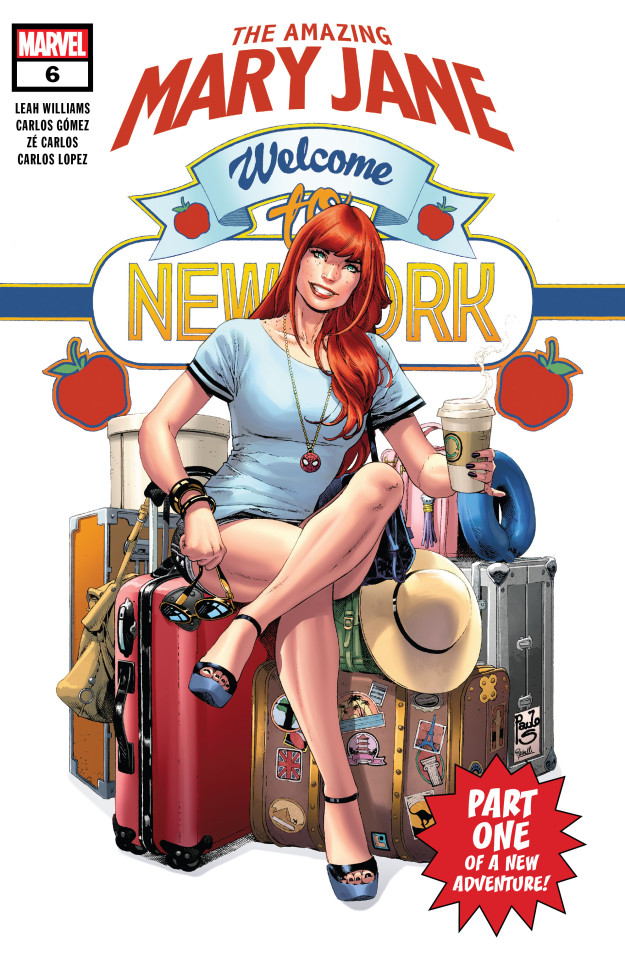
Previous Part
Next Part
Master Post
You know I considered ending this series after the initial arc. I may well discontinue it after awhile. But for now at least I am going to press on. Thus begins the second of what I and dead certain will be a shitty arc of AMJ. Pray for me.
Before we dive into the issue I want to quote for you the solicit for this issue:
WELCOME TO NY, MJ! After the CAN’T-MISS events of AMAZING MARY JANE #5, your favorite redhead is back home! First stop: Spider-Man! But has her relationship with Mysterio changed things with the love of her life? Next stop: a press tour! Complete with iconic New York guest-starring gigs, and OH NO WHAT’S THAT?!?
We spent over 10 years of seeing Peter and MJ separated in the 616 universe.
Thanks to Nick Spencer they blessedly got back together.
Across 25 issues we got to see Peter and MJ interact and 99% of the time it was awesome and helped some old and open wounds get a little better.
It wasn’t every issue, but that was good. Don’t want to get indulgent right?
Then this series came along and Peter/MJ interactions got limited again due to the nature of the story.
That was a shame but at least we were going to get a great MJ story right?
Except we didn’t. We got a story that paradoxically simultaneously celebrated MJ whilst also inadvertently character assassinating her and just being a disgusting fucking mess in general.
But here we have MJ back in New York where Spider-Man is. This issue is even promising us an interaction between them.
Sounds good right?
Let’s see if it will deliver.
As always here we get the recap.

And once more it gives us the full title of the movie in spite of the comic yet to have done that.
As for the ‘strength of his vision blah blah blah’, you know the drill by now. That’s all bullshit, Mary Jane would never connect to Beck over that or allow him to walk free because of that.
There is also a passage in the recap claiming that MJ connected to Beck over familiarity with his situation. The idea of this being their last chance to make it big. I’ve already talked about how that’s bullshit, see part 12.
Finally, the recap confirms that MJ has still failed to tell Peter the truth. Nice to know MJ will continue to be hardcore out of character moving forward into this new arc.
As the issue starts we see MJ introduced as a guest on some kind of chat show.

As has been the case throughout the series, the art is (stylistically at least) gorgeous.
Beyond that there is little to about this page. Except of course the fact that Mary Jane has thought captions.
Let me repeat that.
For the first time in six issues the readers are being given an insight into the thoughts of title character!
You know, if this were a brand new run, a re-launch or even say the beginning of an outright new era for a series maybe that’d be okay.
But it isn’t. It’s the same run, the same volume, the same story, merely the next arc. This is like if Nick Spencer hadn’t used thought captions throughout the first five issues of his ASM run but then randomly did for the Trivia Night storyline with Boomerang.
Thought captions are perhaps one of the single most potent weapons in the arsenal of a comic book writer. It allows for immense development of characters and enables writers to combine the strength of prose stories with those of more visual mediums.
Now, it’s not that it’s bad to simply not use them. But be consistent. Thought captions would’ve gone a long way in helping us understand Mary Jane better in the first arc along with elaborating upon her asinine decisions there.
Not to mention for a character so often written off as shallow or just eye candy wouldn’t an insight into her thoughts have helped dispel such accusations? Jed Mackay has been doing that pretty consistently since the first issue of his Black Cat run. There it has done wonders for Felicia and fleshed her out more.
It’s especially bad when we consider we got more of an insight into MJ’s thoughts and feelings in one issue of Nick Spencer’s ASM run than in the entire five prior issues of her solo title.
Anyway, as her interview with Reilly Redding begins there is some quips and verbal jousting going on. Reilly asks if the movie has wrapped but MJ explains that McKnight and the crew are still shooting in L.A. Reilly asks if MJ is sure about that.

This isn’t a positive, more a general observation. I’m not overly familiar with chat shows, let alone American ones, but to my eyes the host seems influenced by Ellen DeGeneres.
Anyway, let me dispense with the pettiest of gripes first. I hate Reilly’s hairstyle. I hate that hairstyle in general. To me it looks really stupid, like you went for a haircut but gave up halfway through. That’s not in anyway shape or form a fair criticism. I totally own that. It is just a tiny point that really bothers me personally.
On the more positive side, Williams continues her frustrating tendency to nail MJ’s personality traits within a problematic context. MJ’s social skills are one of her greatest powers and here her charisma and ability to play verbal tennis with Reilly is executed superlatively. When Williams does stuff like this she delivers some of the best Mary Jane writing in a long time. Which is why I hate saying and believing that she shouldn’t work on the character over all. She makes traits of MJ shine whilst nevertheless damaging the character over all.
Case in point, the movie is still filming right? And the Vulture (and probably the other members of the Savage Six) are still out there. Let’s be kind and presume they are in a new secret location. That means Vulture will still want to find out where they are, so all the people (and their families) from issue #4 are still going to be harassed by the Vulture’s paparazzi gang and potentially threatened by the six themselves.
Oh well, MJ still DGAF I guess.
Guess she doesn’t care that she’s appearing in public (in NYC of all places!) in spite of six villains now holding a very direct grudge against her.
Also, we FINALLY get the full name of the movie in the story itself, not the recap pages.
As the interview continues, MJ takes questions from the audience. One man asks what it’s like for her to play a real hero for the first time considering she’s played normal female roles before.
MJ responds that they are all heroes to her. She doesn’t really make the female role distinction quite the same way either. It’s more like she plays a hero who is also a woman.
The next question is about the weird press speculation about Cage McKnight’s conduct. The woman asking the question wants to know what he’s really like. MJ responds that he’s great, just dedicated to the craft and protective of his crew. She points out the paparazzi didn’t take kindly to him because he in turn didn’t take kindly to them hounding the movie.
Reilly then reveals McKnight is here for the interview.
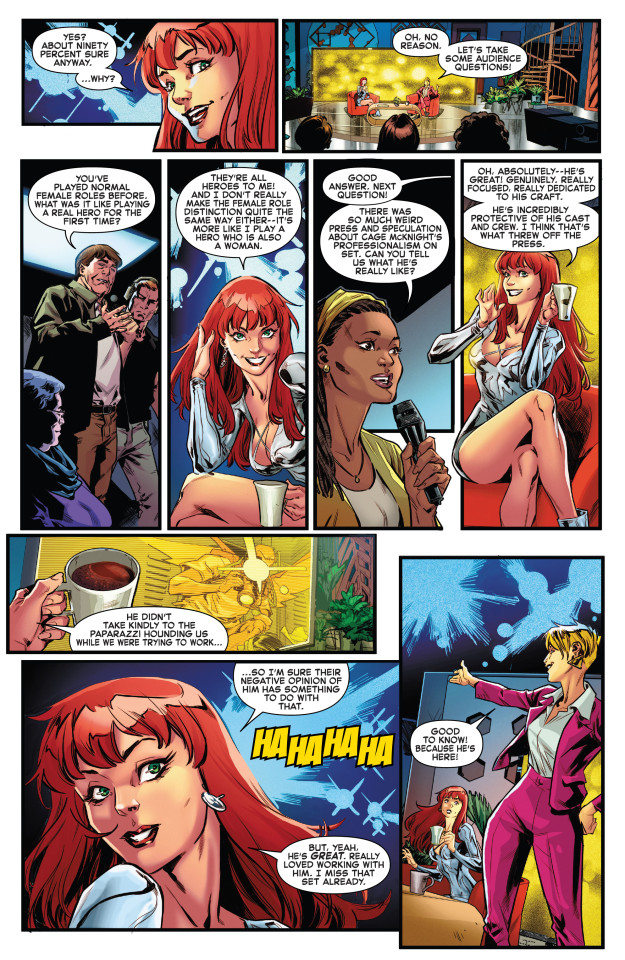
Once more, Williams (with a huge help from Gomez’s art) conveys the charisma and social savvy of MJ here. Gomez’s body language demands particular praise. He conveys MJ’s beauty, flirtation, charm, etc. And he does it on multiple levels. The subtle genius of this page is how Gomez captures MJ putting on a performance for the public, to convince them she’s being utterly genuine and casual.
As for the dialogue, the best faith interpretation of the man’s question, he meant MJ has never played a super hero before, just normal non-powered women. He didn’t mean stereotypical female roles. That interpretation makes MJ’s response make more sense than if the former was the intent. So I’ll give Williams a pass and presume that was in fact her intent.
As for the second question it further highlights the unethical nature of allowing Mysterio to impersonate McKnight. The real McKnight has a lot of gossip and a new public image that was not of his own making. It wasn’t even an unfair fabrication by the press, it existed specifically because someone else was using his name, face and reputation for personal gain.
Also the audacity of Williams to directly reference issue #4 where Ken was harassed by the Vulture’s paparazzi squad but just ignore the fact that that should still be going on.
To MJ’s confusion Cage McKnight joins the interview. However, he doesn’t seem to know anything about the movie at all. He says the first he heard of the movie was when he was contacted for the interview. Meanwhile MJ frantically contacts Beck on her phone. Reilly notices and calls MJ out just before Beck confirms he’s still in L.A.
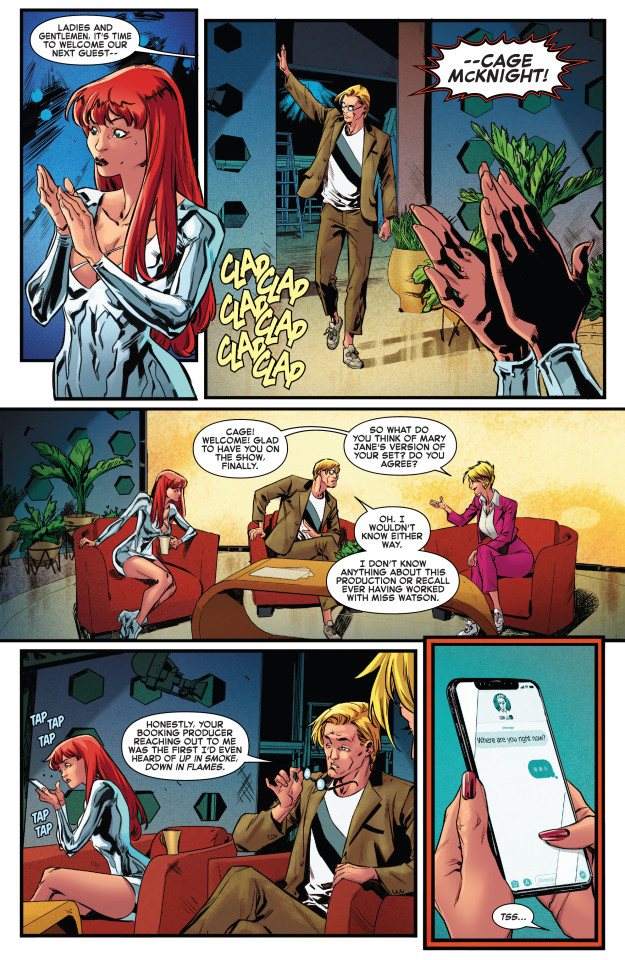
To MJ’s horror she realizes she’s sitting next to the real Cage McKnight who’s returned from his penguin expedition. Reilly asks why he came on the show if he doesn’t remember movie. Cage responds that just because he doesn’t remember making the movie doesn’t mean he didn’t. he explains that in the past he’s made movies in ‘artistic fugues’ and presumes this is just one such time.
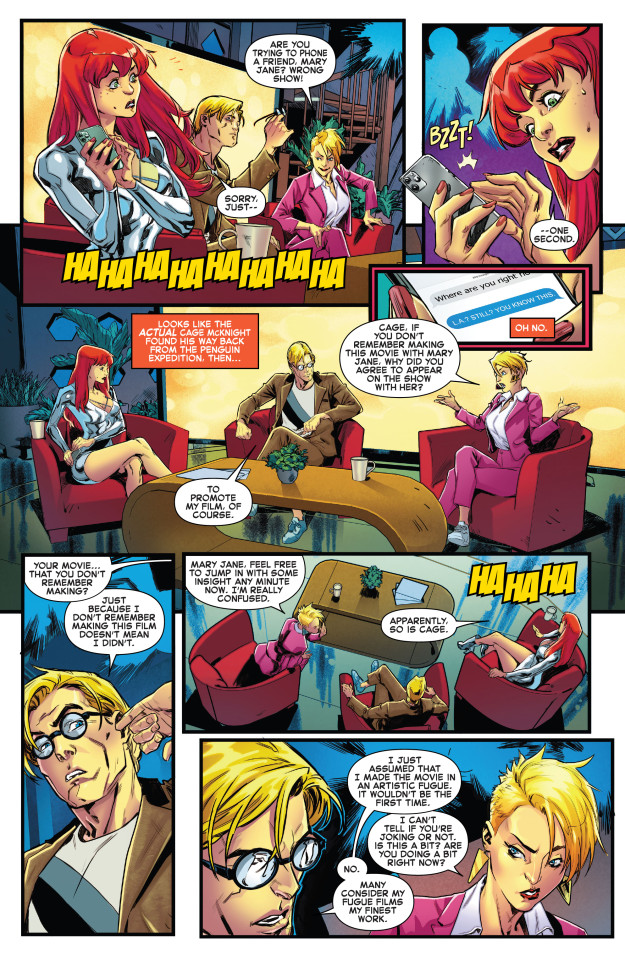
*pinches bridge of nose*
Oh my Gooooooooood this is so dumb.
I get the desire to have humour in a story for the sake of levity. But the world of Spider-Man is not even remotely a borderline Deadpool or Harley Quinn or Lobo comic book. The humour doesn’t come from absurdity or a cartoonlike breaking of logic and reality.
And make no mistake, this is absurd. Scratch that, it’s contrived to the nth degree.
First of all I’m not that well read up on fugue states so I briefly consulted Wikipedia who had this to say:
Dissociative fugue, formerly fugue state or psychogenic fugue, is a dissociative disorder[1] and a rare psychiatric disorder characterized by reversible amnesia for personal identity, including the memories, personality, and other identifying characteristics of individuality. The state can last days, months or longer. Dissociative fugue usually involves unplanned travel or wandering and is sometimes accompanied by the establishment of a new identity. It is a facet of dissociative amnesia, according to the fifth edition of the Diagnostic and Statistical Manual of Mental Disorders (DSM-5).
-Wikipedia
Basically a fugue state is a sort of similar condition to Dissociative Identity Disorder, more commonly known as having a split personality. Only instead of an individual’s psyche fracturing into different personalities that take dominance, it’s someone’s mind running away with itself and becoming someone else. The individual forgets aspects of who they are and becomes someone else.
A very good example within fiction can be found in the Doctor Who episode ‘The Next Doctor’. In it a man named Jackson Lake suffers a traumatic experience and in the midst of it (through a sci-fi gizmo) absorbs a lot of information on the character of the Doctor. His traumatized mind consequently decides to imitate what it regards as the Doctor.
youtube
What I’m saying is McKnight’s dialogue about his fugues are very probably bullshit unless someone can cite evidence to the contrary.
Using the above description though McKnight has gotten this rare psychiatric disorder multiple times and specifically in conjunction with his job as a filmmaker. Yeah, no. Not buying it and neither should you.
Being a film director isn’t a muscle memory skill you can’t forget no matter what. People with amnesia or Alzheimer’s disease do not forget how to play the piano or how to drive. But directing a movie? There are so many moving pieces to that job that rely upon you knowing how equipment and more importantly individual people operate. You have to bear a shitton of theory in mind too. It is physically impossible to repeatedly have fugues and then maintain that job.
And even if it was, oh my lord, that is the single most contrived thing in this series yet. Are you SERIOUSLY telling me that Mary Jane and Beck and the entire production got this lucky. The guy who’s reputation is what the movie is riding on happens to be someone who repeatedly deals with this incredibly rare mental condition?
Holy shit. That’s Superior Spider-Man levels of contrived.
And yet if you still swallowed all of that it still wouldn’t make sense!
McKnight presumes he made this Mysterio movie in a fugue state right? But he wasn’t, so he would remember his life during that period of time. Meaning that there are lots of public records and personal accounts testifying that he was making the movie at the same time that he knows he was observing penguins.
If you suffer amnesia or blackouts or DID then there are obviously gaps in time you cannot account for. The overwhelming majority of people who deal with those conditions make a point of keeping track of those gaps, for practical reasons if nothing else. So McKnight would know that there isn’t a gap in time he can’t account for and certainly not for the time period the Mysterio movie has been going for.
Shit, the movie is still filming! How the Hell does he believe he is still making this movie in a fugue state if he’s consciously aware of lacking any knowledge about it?
Not to mention if he’s been in the Falkland Islands this whole time. A quick Google search informed me that by plane it’d take over 14 hours to travel between the islands and Los Angeles. How the fuck is anyone supposed to ever commute that distance, let alone regularly. And McKnight sincerely believes he was doing both at the same goddam time?
You couldn’t even argue that McKnight believes he made the Mysterio movie before his penguin expedition. Because the movie is still being made and all his other ‘artistic fugues’ would have a movie as proof of what he was doing during the fugues.
This is just mind-numbingly stupid and lazy writing. It smacks so hard of Williams trying to desperately paper over the holes in her initial story.
More importantly, how fucking stupid is Mary Jane or Beck to never considered this possibility? I don’t mean the fugue bullshit, I mean the idea of McKnight just coming back from his penguin adventure.
Was Mysterio honestly so incompetent as to have never accounted for that? He seriously never had anything in place to make sure McKnight wouldn’t just decide to cut his journey short? Jesus, and I was dumb enough to buy his line about McKnight spending a year with the penguins.
Even putting that aside, what the flying fuck was MJ and Beck’s plan for when he eventually came back in the first place? Say he really did spend a year with the penguins then came back to the USA. Suddenly he has a movie with his name attached to it and lots of controversy. Let’s say McKnight’s fugue bullshit added up, there is no indication MJ or beck knew about them. So how the Hell were they planning on getting away with the obvious questions he or his friends or family would have had?
And if they did know about the fugues, why didn’t Williams address that before? That was kind of a lingering question hanging over the story until now wasn’t it?
God I can’t believe I paid for this!
On the next page MJ spots a guy in an Oni Mask backstage. She presumes he’s there to scare her as part of the show. However, she notices that the P.A.s haven’t seen him. Meanwhile Reilly set up a stupid game for them to play.
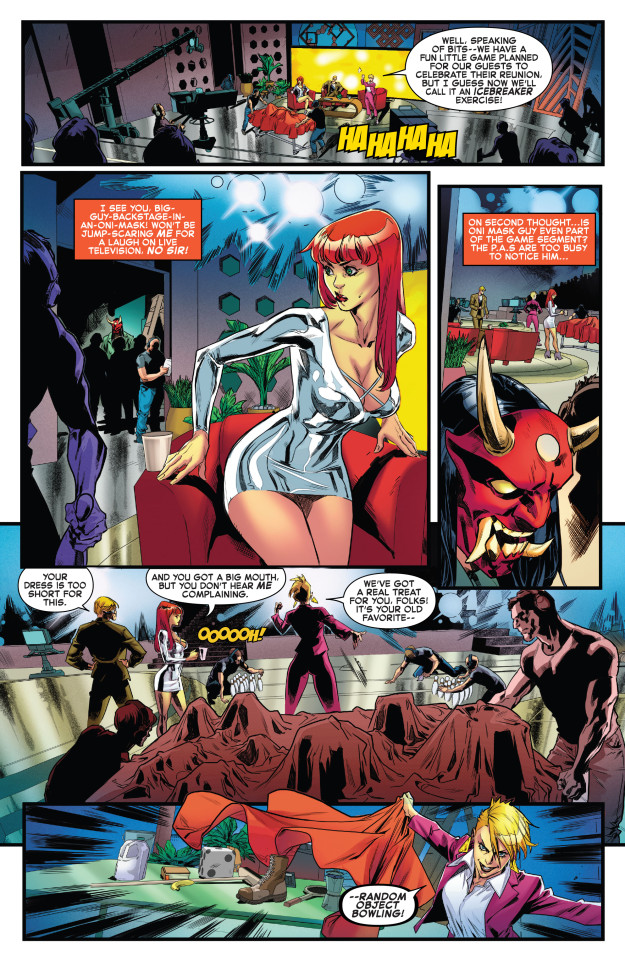
I got nothing to say about this page beyond McKnight’s dialogue. Williams is clearly trying to frame the real McKnight in a less than sympathetic manner. There could be many reasons why. I suspect one of the reasons is to incline us more towards Beck’s version of McKnight and to make us not feel as bad about Beck (and MJ) exploiting his identity.
Because being vaguely and lightly sexist means you deserve to have your career, public image, sense of self and life violated and damaged I guess?????????????
As Reilly brings in people from the audience to compete against McKnight and MJ, the latter thinks that there is something weirdly familiar about the Oni-masked man.

I have little to say about this page too.
Reilly’s attitude and facial expressions make me dislike her, even beyond her stupid haircut.
And as for the Oni-Masked man (I’ll just call him Oni for now) my only guess is that he’s affiliated with Mister Negative somehow. He had his goons wear Oni masks at times. And MJ interacted with them and Mister Negative himself in the popular 2018 Spider-Man video game by Insomniac; and it’s adapted comic book City at War. As such perhaps Williams is trying to tie-in or capitalize upon audience familiarity with that.
As MJ plays the dumb game he ponders if Oni could be a lesser member of Peter’s rogue’s gallery. Observing him again she notices him murder a civilian.

The dumb game annoyed me, but that’s just me.
Beyond that all I can say is that MJ’s dialogue about Peter’s rogue’s gallery is interesting. It proves that MJ has at least a working knowledge of Peter’s major foes. Which just further proves she would have been familiar with Mysterio and his crimes, just in case anyone was still clinging to the idea that she wouldn’t.
Also, the art and especially that splash page were beautiful.
Unfortunately for MJ, Oni notices she witnessed his crime. MJ is nervous and backs away in fear, annoying McKnight when she bumps into him. Meanwhile Spider-Man swings across town yelling for to hold on as he is on the way.

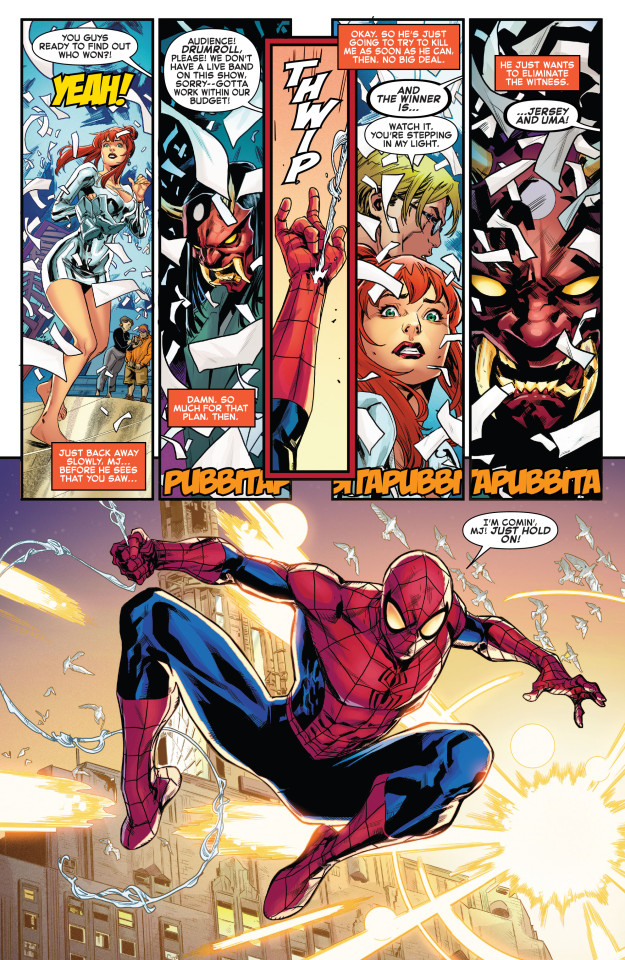
Gomez draws a nice Spider-Man.
Anyway, more of Williams making us dislike McKnight, see above for more on that.
MJ backing away in fear has me apprehensive. I don’t know if that’s in character for her. I guess the shock and surprise could’ve thrown her for a loop. And if Oni doesn’t notice her then it gives her a better chance of raising the alarm and capturing him.
I must say, I do like MJ being on the backfoot here after issues #1-5 made her often overconfident and over capable at times (see her nonchalance over the Savage Six in issue #5).
Also, isn’t MJ going to give Oni the benefit of the doubt? Maybe he’s sorry for murdering that guy just now. Maybe he wants to make amends by creating a movie about his life. So why is MJ so scared?
Sure, he just murdered someone, but what is that next to the laundry list of Beck’s crimes?
As it turns out, Spidey wasn’t on his way to save MJ. He was in fact en route to a French restaurant to have dinner with her. He is actually before MJ for a change.

I know Gomez isn’t the only artist on this issue and this doesn’t look like his work. Who ever is drawing it though is doing a very bland depiction of Peter with a overly wrinkly forehead.
The joke about him arriving first for a change was funny though.
Back at the studio, the show wraps up. McKnight insults Reilly’s profession just in case you’ve not realised he is a jerk yet. MJ thinks about persuading everyone to evacuate and searches for her phone. She notices Oni leaving and decides to leave her phone behind.
I already know MJ is going to pursue Oni herself. The stupidity of that aside why the fuck wouldn’t you grab your phone before doing that? You could use it no matter where you wind up and it wasn’t so far away that he’d get that much of a head start.
In fact, if Oni knows MJ is a witness why did he bother hanging around in the first place.
And why didn’t MJ raise the alarm immediately, the worst that would happen is the guy would run away. He’s just stealthily murdered someone and is in a mask. He obviously isn’t going to take the audience hostage, so if her priority is protecting innocents then raising the alarm immediately (or in fact earlier would’ve been her best bet. Yes that’d probably mean he’d have escaped but unlike with say Peter’s origin, getting him the Hell out of there would’ve reduced the immediate threat to the civilians present.
And on top of that if she figures he’s targeting her because she was a witness to his crime then by alerting everyone to his actions she’d have removed his need (at least for the moment) of sticking around to eliminate her, thus getting him away from the audience.
If he’s leaving anyway, MJ could also just grab her phone and put a call in to Peter, her super hero chums or the police and get them on the case immediately. If she was really so determined to go after this guy herself she still could but would’ve had a back up just in case he escapes or kills her. If she fails then she’s insured someone will still pursue him.
And as I copiously detailed in parts 19-22, MJ is not a super hero (and she knows that). She has no idea what this guy’s skills, weapons or powers might be, nor does she know what resources or assistance will be nearby to enable her to survive or subdue him. This isn’t like an armed cop, a martial artist or a super powered person going after a regular crook. She really doesn’t know what she is in for. Even if he is just a normal man, he clearly has a height and weight advantage over her, is obviously willing and capable of chocking a man to death and is armed. MJ meanwhile has little self-defence training, no weapons and hasn’t got the weight or muscle capable of taking him on if she’s backed into a corner. And she’s pursuing him back stage where presumably there is a fair chance of encountering many corners!
I understand that she doesn’t want to endanger innocent people, but there is no point in risking her life there is a much more practical and likely to succeed option available to her. Live to fight another day and all that. Yes the guy might hurt people during or after his escape but that’s a lesser evil vs. going after him herself when she is very unlikely to subdue him, far more likely to die and then the guy will get away without her having passed on any valuable intel on him to someone more qualified to pursue him.
Also once she sees the guy leaving she could just tell everyone the situation and ask the audience to stay put.
Basically if raises the alarm right there on stage and/or calls Peter or the authorities she is over all putting less people in danger and increasing the chances of the guy being apprehended in the long run. But no, instead she is going to gamble on the far slimmer odds that she can capture the guy.
Not to mention, why would the guy even give a shit that MJ saw him? Why would MJ give a shit that she is a witness to his crime? He is wearing a mask! She couldn’t identify him even if she went to the police. It is literally part of the reason her goddam boyfriend wears a mask!
And by the way, are there no security cameras backstage? Wouldn’t MJ consider that or Oni himself?
McKnight apologises to Reilly (so not that much of a jerk I guess) as MJ pursues Oni (barefooted) backstage. As she does this she rehearses what she will say to Peter in her head. This entails telling him that she had to get away from the killer. As she is thinking about this the body of Oni’s victim is discovered. Backstage she comes face to face with Oni who refers to her by name.
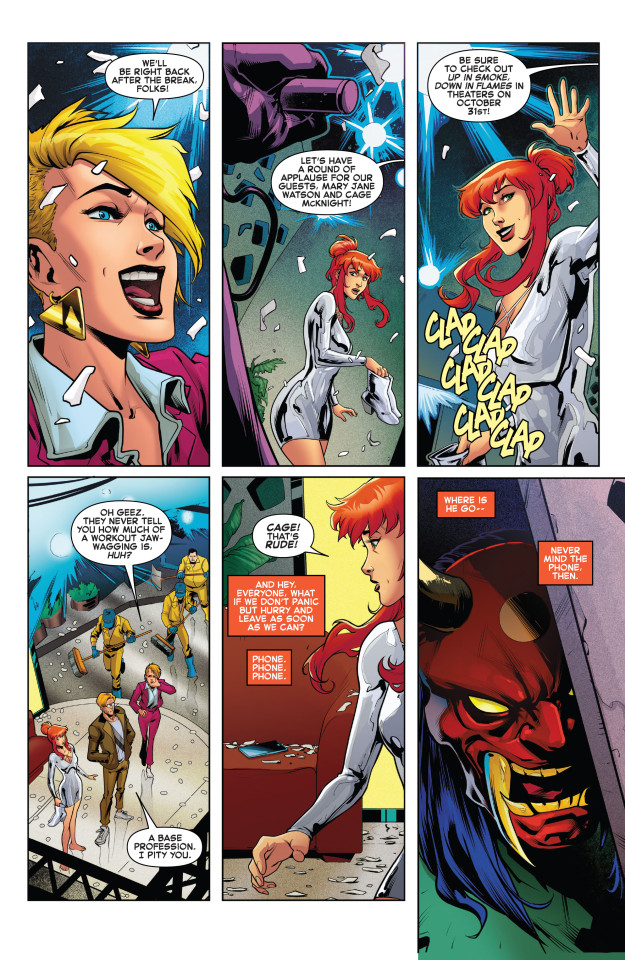

Yay. MJ deliberately planning on lying to Peter again. It’s so awesome that Williams understands why this isn’t a really bad idea for the reasons I pointed out in part 17.
By the way, I suspect Oni knows MJ personally rather than just recognizing her work.
I’m actually going to leave it there for now as the next part of the story has a shitton to unpack.
Previous Part
Next Part
Master Post
#Leah Williams#Amazing Mary Jane#Mysterio#Quentin beck#Spider-Man#mary jane watson#Mary Jane Watson Parker#mjwatsonedit#MJ Watson#peter parker#Doctor Who
15 notes
·
View notes
Text
The Chibnall Masterplan
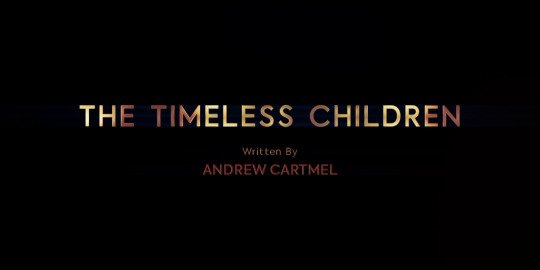
Back in 2018 when the episode "The Ghost Monument," aired, we got our first mention of "The Timeless Child," as uttered by bog rolls floating above the Doctor’s head. My initial reaction to this was dread. In fact, I can even quote my reaction from the review I wrote- "I’ll be honest, I have zero interest in that storyline. It’s called Doctor Who, not Doctor Who was Once a Little Kid Known as the Timeless Child." I got all of that from a single line of seemingly throwaway dialogue. Two years later, it would appear that my first guess was the truth. It turns out that when the Master said "Everything you think you know is a lie," was a lie. Evidently, I knew all along.
If you follow this blog closely, you’ll know that my reaction to the Timeless Child storyline has softened over time. I went from not giving a damn, to being fairly excited. That is until last week’s episode sent me spiralling back into that initial sense of dread. Sadly, this is the energy I brought into tonight’s episode. As opposed to bracing for excitement, I was bracing for disappointment. This is unfortunate as I always try and temper my expectations. I, like the rest of you, would love to be surprised. Even if I am worried about the trajectory of an episode, I always try and keep an open mind. After all, Doctor Who is pretty great.
After last week’s episode, I expected this one to be jam-packed with exposition. Oddly though, this one suffered from its own heaping dose of fluff as well. Once again, the companions spend most of their time on the sidelines. Right away they kill off that Rose Tyler looking girl, so I guess she wasn’t important. Which is a lot of how the episode treats our human characters. We’re given a scene wherein Yaz and Graham have a heart to heart, leading us to believe one of them may be departing at the end of the episode. However, this expectation is subverted by instead having nothing happen. Like last week, Chibnall has opted toward writing hollow character development in place of plot. Because of this, the scenes with the companions felt more like distractions from the actual story.

We get more of this when Ryan, Ethan, and Ko Sharmus are fighting off Cybermen with the power of busywork. Ryan’s attitude toward weapons has shifted since "The Ghost Monument." His interaction with the Doctor has turned him into a bit of a pacifist. Much like Chibnall’s writing, Ko Sharmus muddies this philosophy for Ryan by convincing him to take up arms against the Cybermen. I expected this to play into Yaz and Graham’s conversation, which felt like a foreshadowing of death. Ryan might shoot one of them as they are dressed in their Cybermen disguises, leading him to regret breaking his pacifism. But none of that happens. While it would have been a bit cliched and overly dark to do such a thing, at least it would have been something.

The Master takes the Doctor into the portal to Gallifrey where they stand within the Time Lord citadel. The Master traps the Doctor in a device which may as well be named the Agency Stripper™, as that’s what it, and this episode does to her throughout most of its run. Using the Time Lord Matrix, he illustrates the story of the Time Lord’s origins. All the while in the real world, he invites Ashad, the Lone Cyberman to set up shop on Gallifrey.

The Master tells the Doctor the story about a Shobogan scientist named Tecteun. She was the first of her kind to achieve space flight, which is incredible when you consider the thousands of people that were necessary just to get humans to the moon. During her travels through space, she discovers an odd gateway containing a little girl. She takes this girl home and raises her as her own. During a freak accident, much like Brendan from last week, she falls off a cliff. Damn kids, always playing by rocky cliffsides. However, instead of dying, she regenerates.
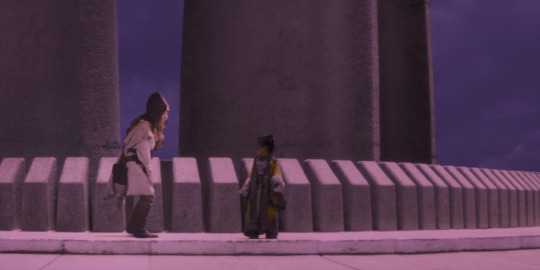
Tecteun goes a bit mad scientist trying to unlock the secrets behind regeneration, leading her to do experiments on this timeless child. She even appears to force regenerations on her as well. Eventually, she unlocks the secret of regenerations and successfully uses it on herself. This establishes what would become Time Lord society. At this point, we’re now waiting for the Master to tell the Doctor exactly what we all know- that the Timeless Child is the Doctor. However, there was a moment when it almost seemed like the Master was going to say he was the Timeless Child, which honestly, I would have found far more compelling. It would have informed so much of the Master’s past actions, and his recent relapse in character development after Missy’s change of hearts.
Instead, I found myself rolling my eyes at this "big reveal." It really was that simple. The story I wrote in my head after a single line of dialogue is exactly what we got. We learn that the number of regenerations was placed upon future Time Lords, which is weird because Clara had to plead for the Time Lords to give the Eleventh Doctor more. I guess along with unlocking the secret to the Timeless Child’s regenerations, they were also able to limit their number. That or Chibnall didn’t even think about it.
When considering the wanton destruction of Gallifrey by the Master’s hand, you suspect whatever it was the Time Lords did to this child was heinous. And while, yes, forcing regenerations upon the kid is a bit cruel, they always looked serene (see: bored) while sitting there in Tecteun’s lab. I expected it to be something like Rassilon and Omega destroyed a child to harness her time travelling ability to create the first TARDIS. Turns out, that the thing that really pissed off the Master was knowing that he had a little bit of the Doctor inside of him. While the Master has always been a bit of a maniac, even this felt like a bit excessive.

Back on the Cybership, the humans have stowed themselves away in Cyberman armour. I rather liked this bit as it reminded me of the very first Dalek story where Ian hides away inside a Dalek carapace. While I feel like they could have done more with this, at least they were having a bit of fun. After saving Ryan, Ethan, and Ko Sharmus from the Cybermen, the humans make their way into the portal to Gallifrey. The Cybermen land above the Time Lord citadel where they hover above, ready to make Gallifrey their new home.

The Master does the Doctor dirty and leaves her inside the Matrix to fend for herself, while he goes off to broker a deal with Ashad. We find out that Ashad, with the guidance of the Cyberium coursing through his mind, has created a death particle capable of undoing all organic life in the universe. His big plan is to basically turn the Cybermen into robots, which much like the Master, I found boring. Thankfully the Master is always up to his dirty tricks as he kills Ashad and uses the Cyberium to create a race of Cyberman/Time Lords known as Cyber-Masters. I was a bit disappointed they weren’t called Cyber Lords. However, I suppose the Master naming them after himself is on-brand at least. After all, he did once make an entire planet’s population into himself.

The Doctor is now forced to deal with the new information she’s been given by the Master. She rejects it at first, but the imagery of Brendan in her mind keeps giving her cause to doubt. It’s then that she sees the Ruth Doctor who helps her through her identity crisis long enough to help her escape the Matrix. Her plan to escape is to basically run through every life in her mind until it shorts out and forces the Matrix to release her. This entire sequence is rather silly when you consider the Matrix holds the entire lives of countless other Time Lords. No matter how many lives she had before the First Doctor, it’s not more than the Matrix can handle. What’s even sillier is the way in which they shot it, which was basically by having Jodie Whittaker squeeze her eyes shut and wince while holding her head. I was reminded of hacking scenes in movies where they throw a montage of symbols over the scene to make up for the fact that we’re basically watching some guy on a computer.

The montage is what is really worth mentioning, as it touched upon quite a few things from the Doctor’s past. Some of these things have been mysteries from as far back as the Tom Baker era. I’m speaking of course about the Morbius Doctors. For those of you not in the know, the Morbius Doctors were a series of images projected from the Doctor’s mind during a battle of wits between the Fourth Doctor and an evil Time Lord named Morbius. I had always assumed they were Morbius’ previous regenerations, but many have speculated that they were versions of the Doctor from before William Hartnell. Well, it would appear that this age-old debate can now be put to rest- those were definitely images of the Doctor.

I’d be lying if the nerd in me doesn’t kind of love this. Like I said, I try and keep an open mind. It’s even easier when the concept of Doctors existing before the First Doctor has been around for rather a long time. Andrew Cartmel’s "masterplan," was to introduce the idea of "the Other," which would be a Time Lord on par with Rassilon and Omega that was eventually "cloned," in a genetic loom into the First Doctor. However, the idea was paired back as it was decided the doing such a thing would reveal too much about the Doctor’s past, thus answering too much of the show’s central question- "Doctor Who?"
Was it too much? That’s really hard for me to say at this point. It’s a bit early to know for sure. It does certainly complicate things a bit. To paraphrase something Andrew Cartmel once said at a public appearance- these story elements are like barnacles on a ship. Each one of them attaches to the hull over time. They seem small at first, but they eventually begin to slow the ship down. Take the aforementioned regeneration limitation placed upon Time Lords back in 1976’s "The Deadly Assassin." While it worked for the story at the time, it gave Steven Moffat the unruly task of finding new ways for the Doctor to keep on regenerating. You’ll forgive the guy for not doing the Valeyard.
While the nerd in me does love that they touched upon some deep Doctor Who lore, part of me was also lamenting the introduction of so many new versions of the Doctor. I’ve got a special love for each incarnation of the Doctor. This is why I love the Eighth Doctor audios so much, as it gives us an even deeper understanding of his character, despite his limited screentime. Even the War Doctor was given the chance to develop. Where will the Ruth Doctor play into all of this? Why did she have a police box if she is pre-Hartnell? Is this “Division,” an actual division of the Timeless Child into multiple entities? Will we get to experience her Doctor in a deeper way that feels as fulfilling as the first Doctor of colour deserves? While I hold out some hope for her, what about the montage of children in Tecteun’s lab? Are we going to get comics and Big Finish audios starring some kid you saw for two seconds? (I kid, you know they will) On one hand, we see the first Asian Doctor, on the other hand, they don’t even get a speaking role. Even with so much being added to the Doctor’s history, I can’t help but feel slightly short-changed.
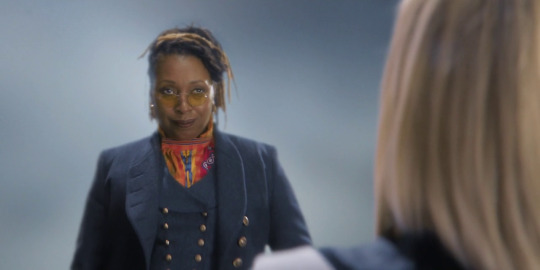
Speaking of short-changed, let’s talk about that ending. The Doctor’s plan actually works, releasing her from the Matrix’s hold, which oddly also releases her from the Agency Stripper™. Convenient! Her companions find her as she’s lying there unconscious. They managed to find her rather quickly considering the city is in ruins. Convenient! The Doctor finds Ashad’s death particle, which has been shrunk down by the Master’s tissue compression device. I’m not sure, but I think this is the reason the death particle is no longer a threat to the entire universe. It now only seems to pose a threat to the organic life on Gallifrey. Maybe this is because Gallifrey is still in its own pocket universe? Either way, it wasn’t very clear. The Doctor makes contact with the Master and pinpoints his location. Convenient! She calls him to the citadel like it was Friday Night Wrestling and they have their little showdown. I swear if they’d have started making out, I wouldn’t have batted an eye, those two.
After forcing her companions to stay behind on a TARDIS set for Earth, the Doctor heads back to have a final showdown with the Master. With the tiny Cyberman attached to an explosive device resembling a torch, the Doctor decides she must kill the Master and this new race of Cyber-Masters before they can kill all of humanity. Having the ability to regenerate, the only way to take these mechanoids down is with the death particle. This is a far cry from the Doctor we’ve seen in "Genesis of the Daleks," or even "Daleks Take Manhattan," where the Doctor would consider such things "genocide." However, the Doctor gets a total cop-out moment as Ko Sharmus shows up long enough to detonate the device himself. After very little prompting, the Doctor allows him to sacrifice himself as she flees.
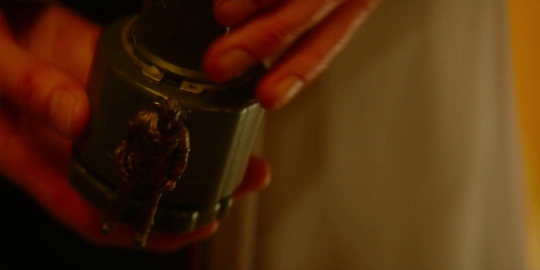
This, for me at least, is a longstanding problem with Chris Chibnall’s morality. It’s the Thirteenth Doctor’s weird relationship with guns all over again. As if to prove Davros’ point from "Journey’s End," this Doctor feels all too comfortable with allowing others to do her dirty work. Imagine the scene from "The Day of the Doctor," when Clara is standing there looking of the Doctors about to collectively blow up Gallifrey. It’s as if when she said "I never pictured you doing it," instead of changing his mind, the Doctor would say "You know, you’re right. You do it!” There’s a kind of mean spirited morality lurking beneath Chibnall’s writing. Or as my friend Adro jokingly put it- "I would not want to be his S&M partner."
The Doctor sends her companions and the last humans in the galaxy back to the 21st century. Surely no bootstrap paradoxes will come from Yedlarmi or Ethan making future generations of their own ancestors. Time Lords have bigger things to worry about than time anomalies. Right? Oh right. Graham and Ravio still seem perfectly capable of continuing their relationship, so that’s at least something. I also highly doubt either of them are likely to sire any paradoxical offspring any time soon. Though they are still fully capable of raising the sheep that go on to start the Wooly Rebellion. After finding herself pleasantly surprised to be alive, the Doctor finds her way back to her own TARDIS. However, before she can scoop up her companions, she’s intercepted by an angry Judoon who arrests her and throws her into space jail. I imagine this has something to do with why the Ruth Doctor was a "Fugitive of the Judoon."

After all is said and done, it’s really hard to pin down exactly how I feel about this episode. I do applaud the bold move of expanding the Doctor’s canon to include previous regenerations. I’ve always said that Doctor Who does occasionally need a showrunner willing to put their neck on the line. For better or worse, John Nathan-Turner was great for doing exactly that. Sometimes it’s a good thing to shake things up, and really dust off the cobwebs. Though strangely, a lot of tonight’s episode was very non-committal. The Master could very well have been lying. Gallifrey could also still very easily be restored by using the Matrix’s memory. I personally would appreciate that as I love both Romana and Leela. The idea of the two of them dead and eaten away by the death particle is rather distressing. While I liked watching Jodie get a bit snippy and knocking the Master to the ground, I feel like a she never got a moment to be the Doctor. Her “Aha!” moment was short-lived and not very clever. She spends most of the episode either locked up or feeling helpless.
Also, where the hell was Captain Jack? What the hell Chibnall? How are they going to just give us five minutes of John Barrowman? It seems weird to introduce him only to put it off until the next series. However, the most egregious of sins for "The Timeless Children," is how utterly predictable it all was. As I illustrated above, I was able to imagine the entire concept of the Timeless Child the very first time I heard it mentioned. I put no deep effort into it either. It seemed like the most obvious storyline. The same could be said about people’s Ruth theories. Some of which were even better. The only way in which the episode could have surprised me was by making the Master the Timeless Child. It was the one point where I really perked up and began to feel a real interest in the plot. But alas, no, they went the incredibly obvious route. This isn’t to say they won’t be able to do interesting things with this in the future. The issue I’m having is that if I am able to figure out the plot just by hearing a single line of dialogue, did I even need to watch it?
#Doctor Who#the timeless children#Jodie Whittaker#Thirteenth Doctor#sacha dhawan#the master#Graham O'Brien#Bradley Walsh#Yaz#yasmine khan#tosin cole#Ryan Sinclair#mandip gill#chris chibnall#TARDIS#bbc#cybermen#cybermaster#cyberium#the lone cyberman#ashad#judoon#Time and Time Again
22 notes
·
View notes
Note
I honestly would love to see Black Cat and MJ just hang out more. Because of the love triangle I’ve always heard about how much they ‘must’ hate each other, but honestly I could picture Pete waking up one day, finding MJ and Felicia in the living room having coffee and asking what she’s doing here and MJ just says, “Dude we meet up like twice a week to hang. We’re going bowling tonight.” or something.
They’re relationship is actually more complicated than simply being catty rivals or some such.
The harsh truth is, for better or worse, writers pitted the pair against one another lightly in the 1980s, famously the first instance of this was in the iconic ASM #258, the issue both immediately after MJ reveals she knows who Peter is and where Peter learns the truth about the black costume.

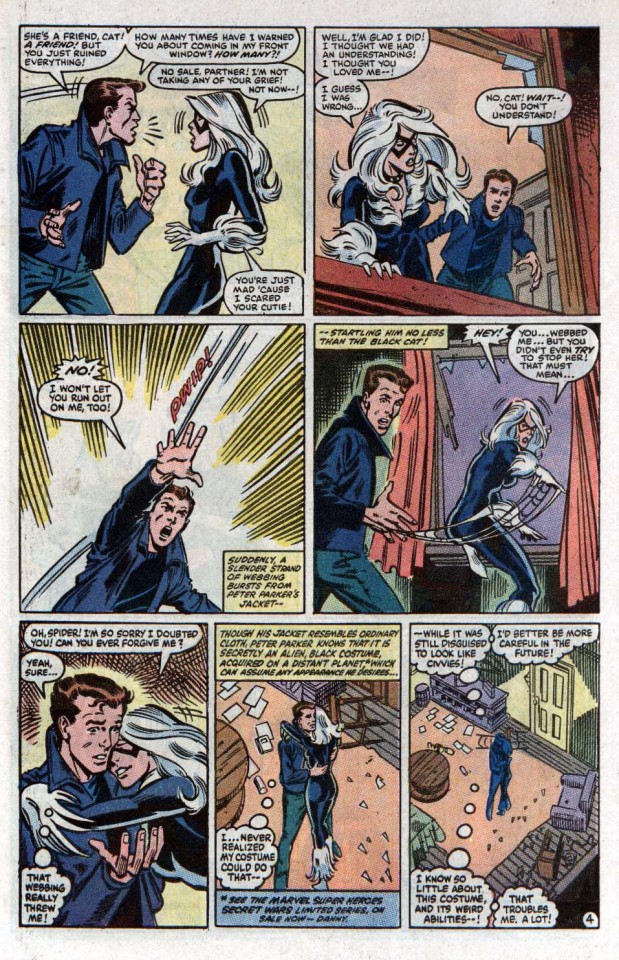
Initially the animosity was more on Felicia’s end than MJ’s, whether she meant it or not, she briefly felt Peter was better suited to Black Cat.
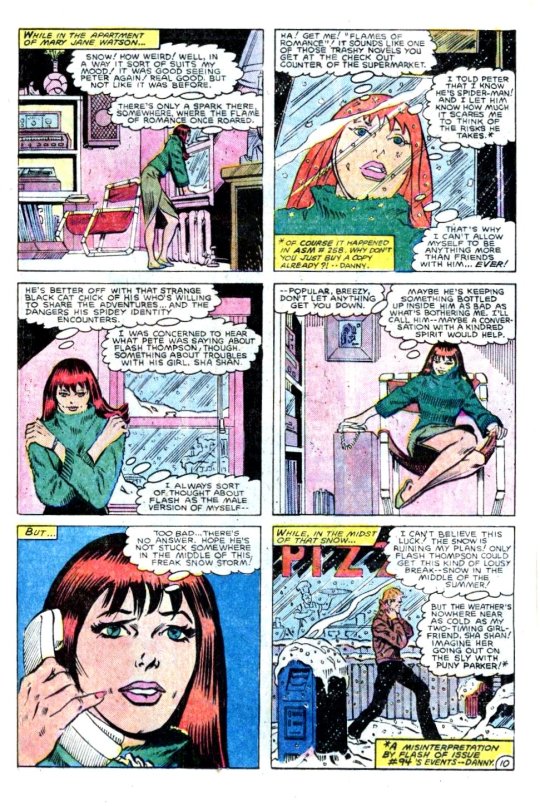
MJ became Peter’s confidant not too long before he and Felicia broke up and when she was later reintroduced into the titles MJ became more clearly down on her. This is epitomized in Spec #119 (a great Felicia story).

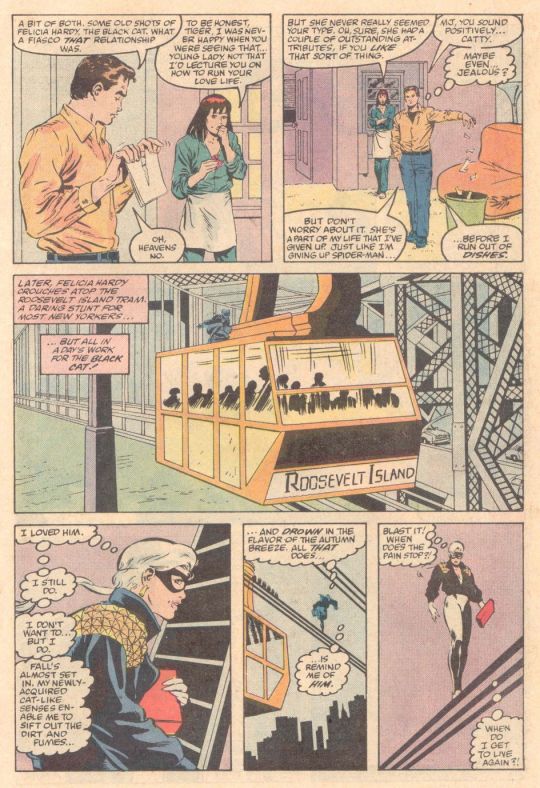
That issue also ends though with MJ admitting she has complicated conflicting feelings towards Felicia, the complications of which are wrapped up in her complicated feelings for Peter. In the story Felicia single handily takes down Sabertooth.* In a sense she defended civilians and Peter in doing so and thus MJ is caught between admiration and jealousy.

Their romantic rivalry becomes more out and out mean in Spec #123 and ASM #288 which follows up on that subplot. In the issues MJ resolves to set her and Peter’s ‘will they won’t they’ thing straight only find Felicia in Peter’s apartment (he saved her earlier that day and she needed somewhere to regroup). At the end of that adventure though Felicia basically forcibly stayed in Peter’s apartment so MJ was none too pleased to find her there when she showed up to make Peter breakfast in bed.**
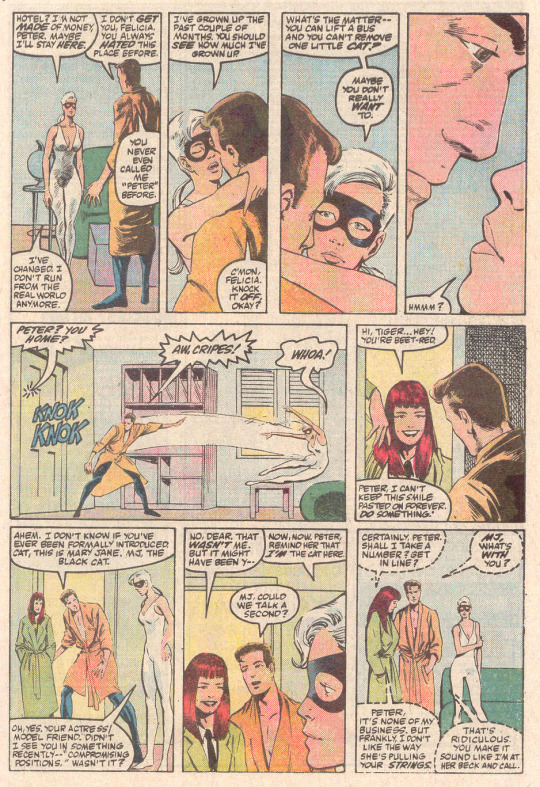


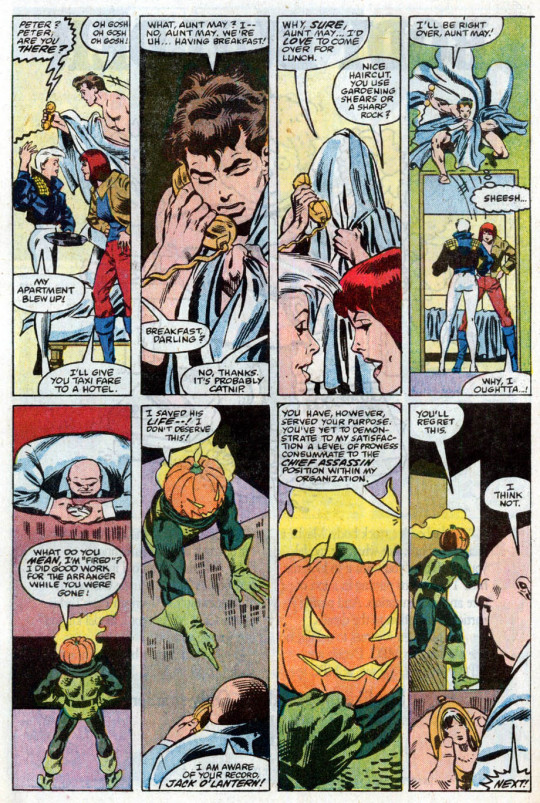
The pair remained in disdain of one another after this but also didn’t interact face to face again until after Pete and MJ got married and more specifically after Peter lost his cosmic powers defeating Tri-Sentinel. Felicia had learned Peter had gotten married and as revenge began dating Flash with the intention of breaking his heart to hurt Peter by proxy. She also delighted in makig him and MJ uncomfortable though.


When MJ and Felicia interacted one-on-one Felicia was shockingly straight up assaulting MJ!



At this point MJ obviously didn’t like Felicia but she was not giving as good as she got. Things began to shift not too long after in a storyline that saw Peter give up his powers and Felicia begin to develop genuine feelings for Flash. During this storyline Felicia stepped up and began acting as the muscle for the powerless Peter. MJ still didn’t like Peter was starting to reluctantly recognize her as more of an ally than an enemy. In particular the story ended with Felicia powerless and deciding to temporarily retire and date Flash sincerely.
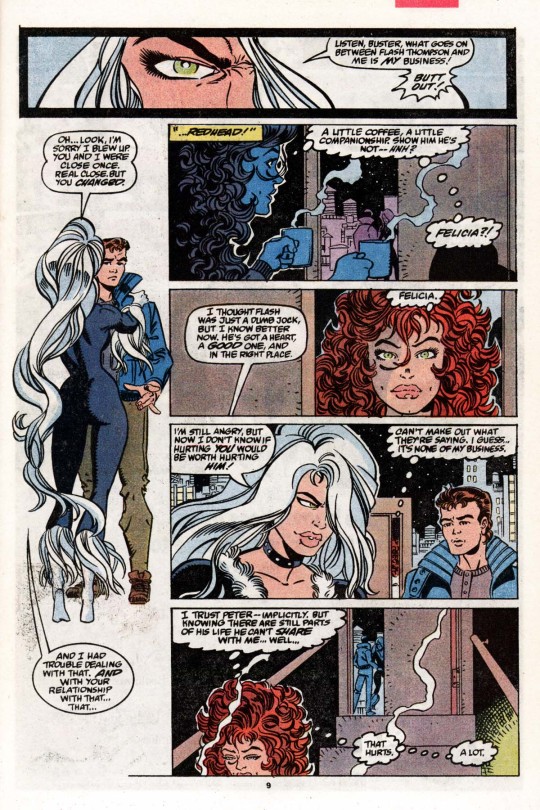
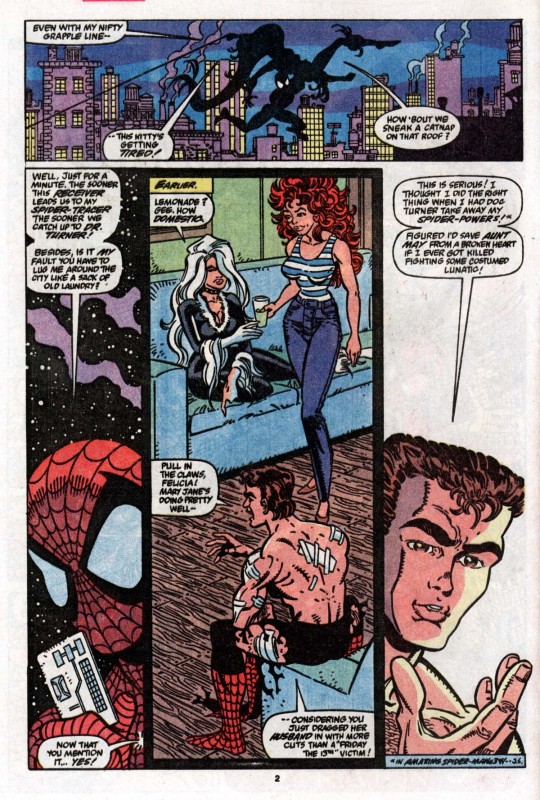

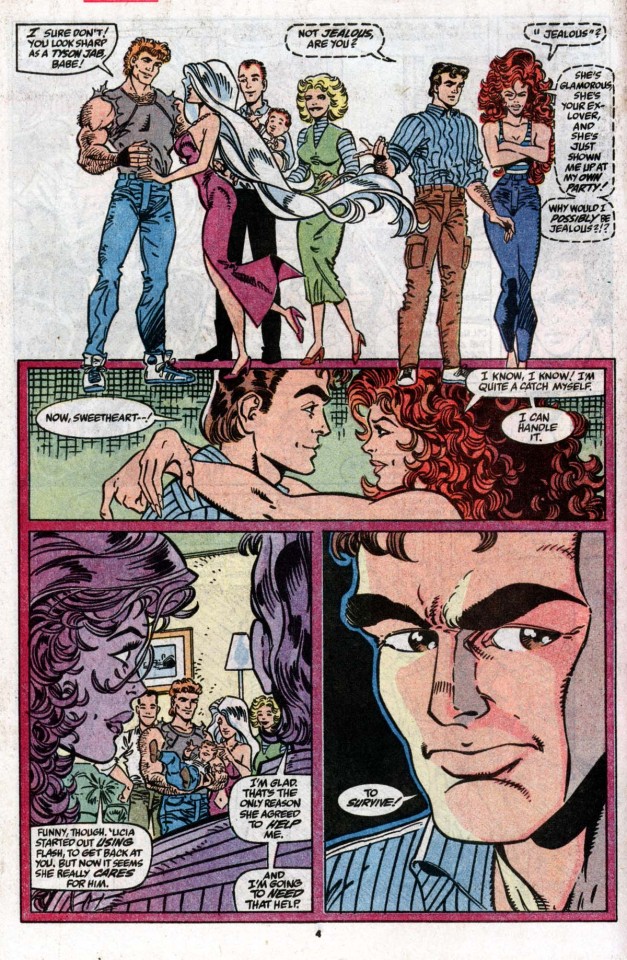
Whilst they weren’t exactly friends it did get to a point where MJ was okay with going on double dates with Flash and Felicia, considering the latter was no longer out to get her/hurt Flash/steal Peter away.

However a significant turning point occurred in Web of Spider-Man #80. The story short is that Peter/Spidey is missing after he and Mj got attacked. MJ turns to Felicia for help, citing the fact she still cares for Peter and that’s common ground for them to work with for the moment. She gives her a tracking device Peter made to zero in on him. She even admits she’s out of her league on this front and it’s up to Felicia. Felicia of course helps save Spidey and whilst initially claims her locating him was due to their ‘connection’ (meaning their romantic history) she admits MJhelped witht he tracking device. The issue ends though with Felicia admitting that MJ’s device actually didn’t work, meaning Felicia simply let the Parker couple think it did out of kindness to MJ. This didn’t turn the pair into friends, but it showed they were clearly mellowing towards one another.


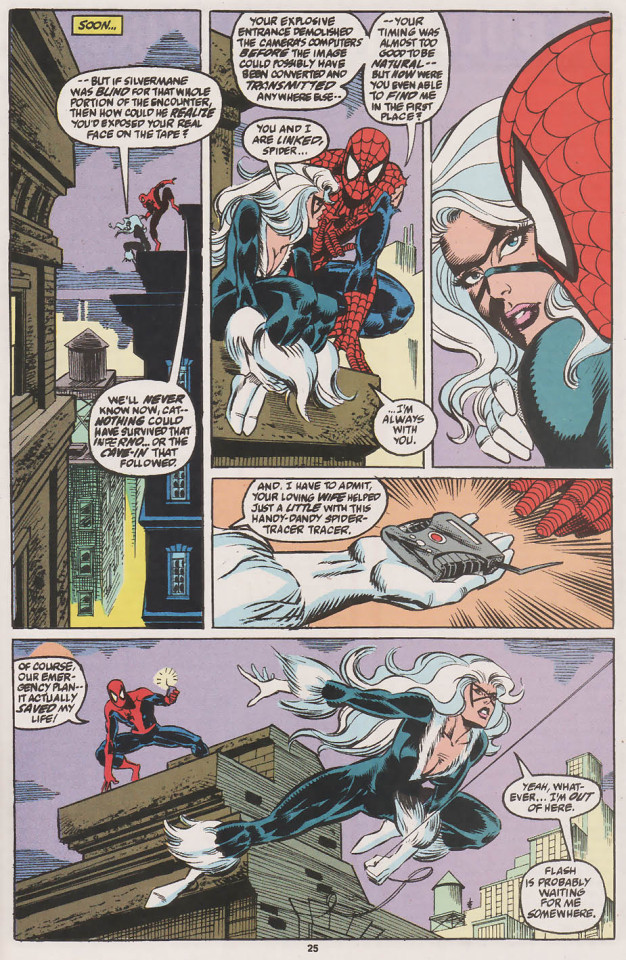

This didn’t make them chummy as catty remarks still occurred during later interactions (noticably from MJ). I’m skipping over stuff to get to some highlights, the next of which is a big one.
In Felicia’s first ever solo mini-seires MJ not only appears int he first issue but they are actually hanging out...together...as friends!
Or at least as frenemies. It’s clear there is still some underlying jealousy or jousting to be had, but they’re very open about it and Felicia is actively confiding in MJ, even talking about how she feels regarding Peter. And not just Peter in general, his then current state of being. This was back when Peter was unravelling due to the aftermath of the Robot Parents crap and becoming more anti-social and obsessive about his Spider-Man life, spending less time out of the costume. It got Felicia and MJ concerned. A very significant line of dialogue in this scene is MJ saying she’ll call Felicia later. It implies that they have hung out together before or are at least okay with doing do again in the near future.
Also this was at Felicia’s home, so for MJ to have voluntarily gone to the home of the woman who once assaulted her says a lot about how things have changed.
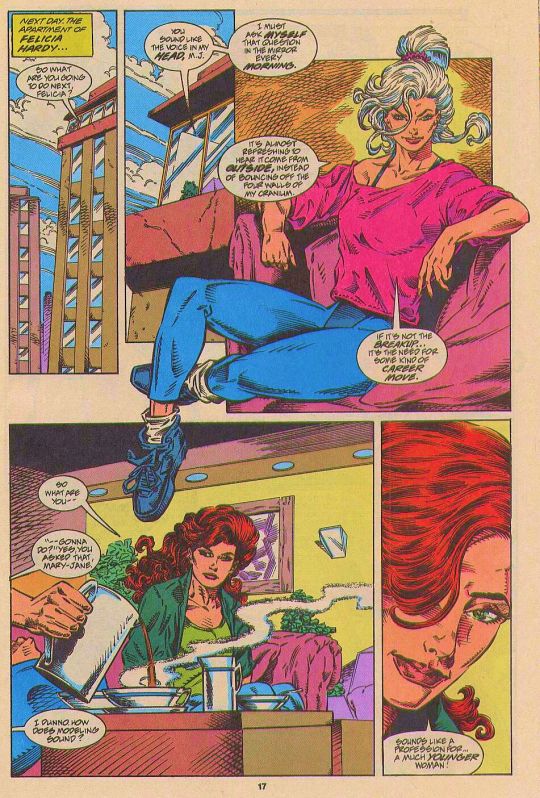
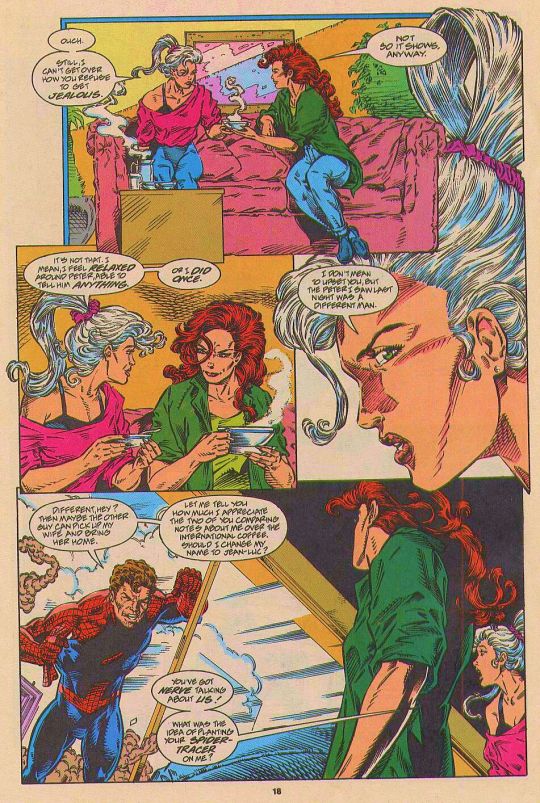

Again skipping over some stuff but the next big moment for MJ and Felicia came in Web of Spider-Man #125 where MJ once again calls upon Felicia’s aid to find Peter (though he’s not in trouble, she just needs him present). The circumstances are decidedly different from Web #80. There is no jousting going on. Partially this is due to their relationship having grown deeper but it’s also due to MJ being pregnant and amidst the chaos of the time (Peter was on trial for murder, Aunt May had just died and MJ had been recently abducted by Kaine) she was clearly feeling very vulnerable.
Vulnerable enough in fact that Felicia can clearly tell MJ is upset and outright hugs her, offering some support and comfort.
This time Felicia isn’t seeking out Peter less because she cares for him and more because she wants to help MJ and the baby. If ever there was a moment clearly demarking the pair had fully transitioned into real friendship, this was it.


Whilst MJ and Felicia don’t directly interact in Web #128 Peter makes a reference to MJ and Felicia talking on the phone for hours.
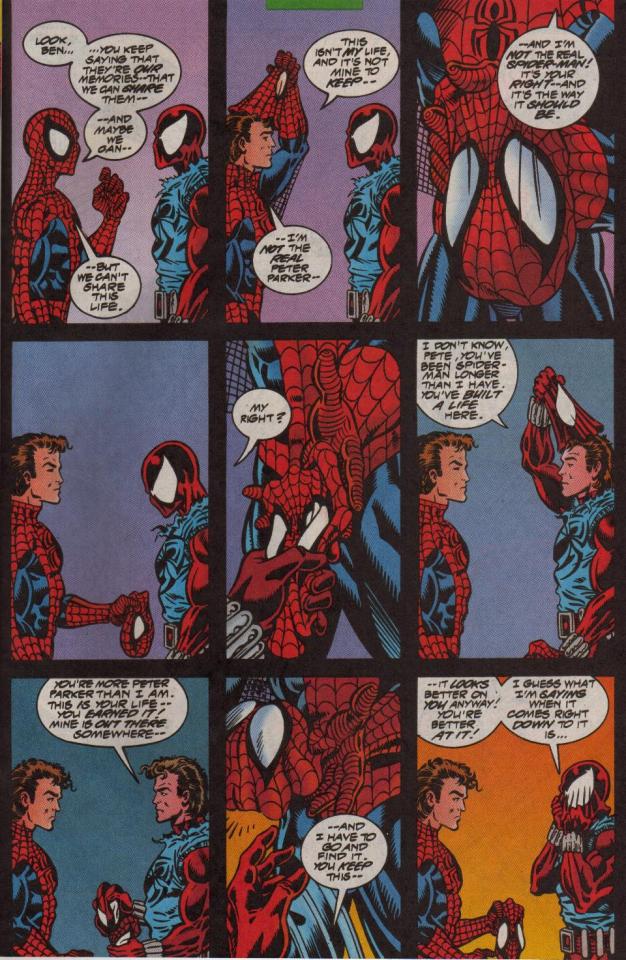
Skipping waaaaaaaaaaaaaaaaaaaaaaaaaaaaaay ahead now. The tl:dr is that Felicia clearly began to develop some feelings for Peter again during Howard Mackie’s run. This became more significantly a factor in the Evil that Men Do Limited Series where Felicia is putting the movies on Peter and also refers to MJ derogatorily.


Something to note about Evil that Men do is that it gets a lot of details wrong and it’s continuity is wonky. the first half came out when Peter and MJ were seperated, but the second half came out years later and used then contemporary continuity from when Peter and MJ would’ve been back together. The important thing to note is Felicia went back to having the hots for Spider-Man and also being down on MJ
To my recollection the next time I recall MJ and Felicia having a significant interaction was in Marvel Knights: Spider-Man #5. In the issue Felicia has rescued Peter from the Vulture and is helping him investigate Aunt may’s recent kidnapping. Peter was badly beat up so Felicia and Mj were nursing him back to health. The scene where Peter wakes up clearly conveys that there is some tension and competitivness going on between MJ and Felicia even though they are talking in a friendly manner to one another. When Felicia leaves MJ looked really bummed out, which might’e been due to some insecurities regarding Felicia or because of their financial troubles at the time (she was keeping them from Peter).



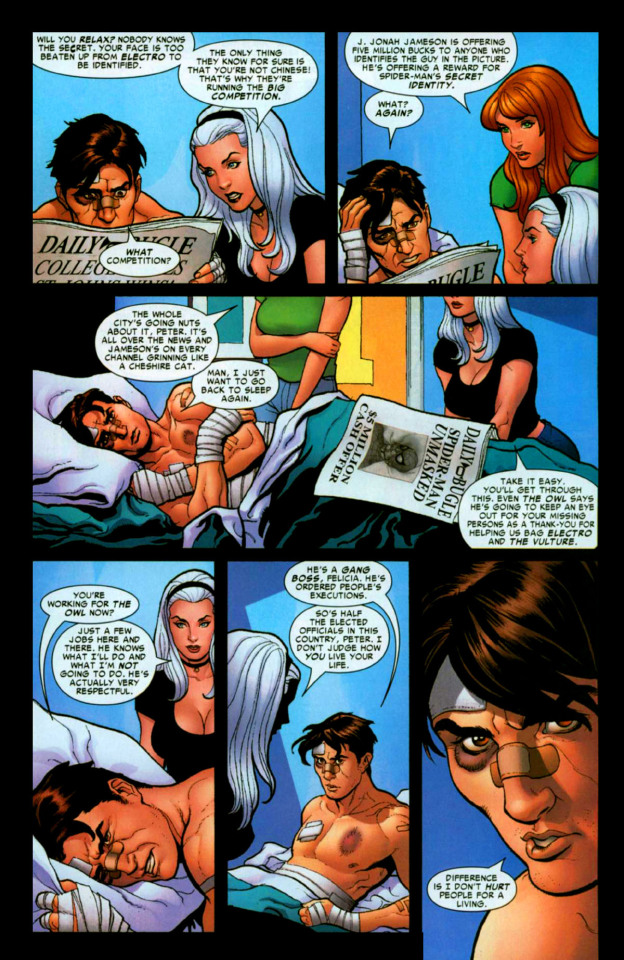

Later on in Marvel Knights #10, when Peter has resolved to break Norman Osborn out of jail in order to save Aunt May, Felicia going along with him for this, MJ blows up at Felicia and basically tells her to back off from Peter.


In defence of MJ here, Norman Osborn has pushed them to the edge big time so I think she’s having a major wobble regarding Black Cat.
Anyway, she’s not wrong about Felicia as the remaining issues of the arc make it clear that Felicia is absolutely in love with Peter again if Evil that Men Do didn’t make that clear enough.
Next up in Spider-Man: Breakout #2, MJ is similarly pissed off about Peter contacting Felicia for help tracking down the U-Foes.
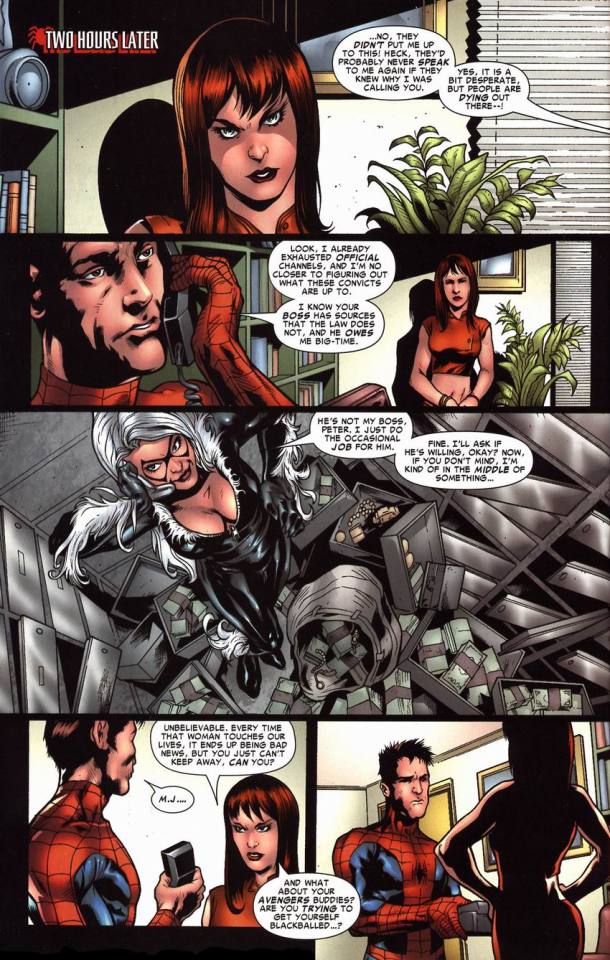
Frankly...I find this instance rather out of character but I thought I might as well mention it.
Then we have Spider-Man Unlimited volume 3 #14. In this issue, as payback for helping him bust out Norman Osborn, Felicia demands Spider-Man help her steal something from Doctor Doom. Peter isn’t happy about this until it turns out that the item in question was a spider tracer with his finger prints on it, meaning Felicia was trying to once again protect Peter. MJ wasn’t happy to find out Peter was hanging out with Felicia but acknwoeldged she helped protect them.

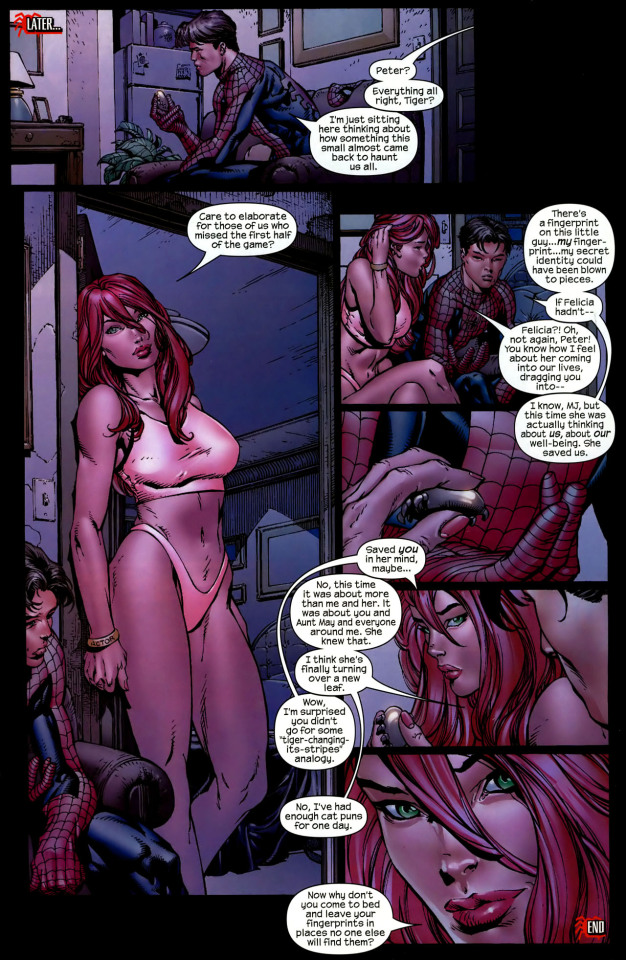
The next notable interaction was during Civil War when Peter was unmasked, the Parkers were fugitives and Peter was half dead from a beating via the Rhino. Felicia upon learning of this sought out the Parkers and volunteered to even the score with Rhino. When all is said and done, MJ asks Felicia if she wants to give Peter a message from her.


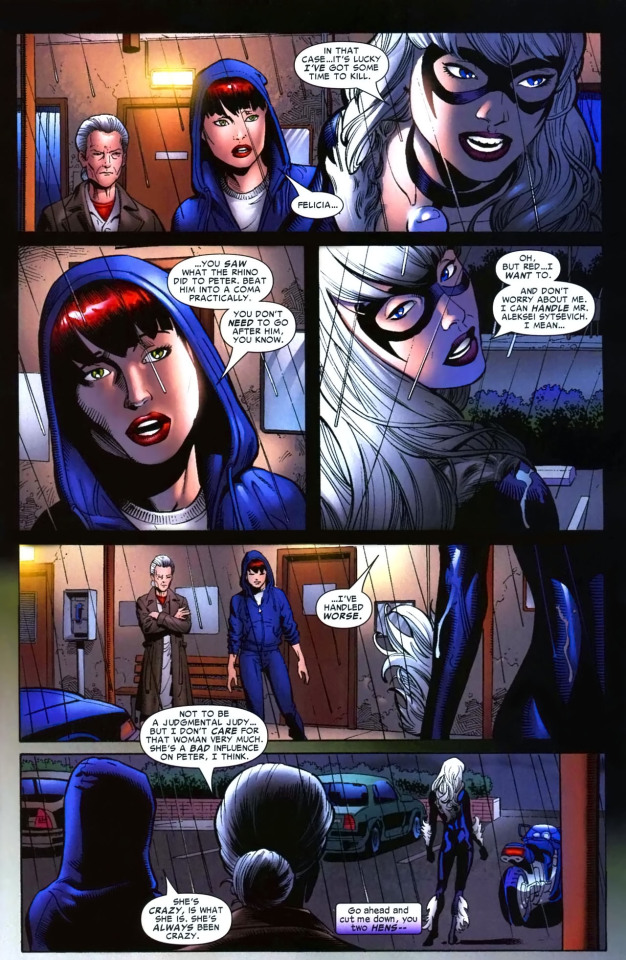

We then transition into shitty post-OMD continuity and frankly I’m not touching 90% of that sans one notable story (Web of Spider-Man volume 2 #11-12) in which Felicia, who has totally forgotten who MJ and Peter Parker are, nevertheless befriends MJ after an adventure to save Peter.


I bring up this story simply because your original question was regarding MJ and Felicia friendship.
This story’s canonicity can be debated for a few reasons, it doesn’t make sense in general because the mindwipe was asinine shit and it has 0 follow up. In fact it doesn’t even really jive with later appearances of MJ or Felicia. It is amusing though that it completes a sort of trilogy wherein MJ and Felicia become more friendly in Web of Spider-Man.
Anyway, that brings you pretty much up to date.
Essentially there are two distinct eras for MJ and Felicia’s relationship. The 1980s-1990s where they have a clear arc transitioning from acquaintances who’re not that fond of one another to rivals to frenemies to outright friends.
Then you have the 2000s and beyond which pits the two against one another again but in a very different dynamic to before as MJ is Peter’s wife and recognizes Felicia’s as an ally.
It’s not impossible to reconcile the two narratively but I’m not going to do that here.
I think the second era might’ve been done in order to inject more tension into the Spider Marriage and in fairness, it did work. It was dramatic.
But I personally prefer the second era much more as it portrays a clear character arc. As a bonus I should mention that, since it diverged from Spider-Man continuity in the late 1990s, in Spider-Girl MJ and Felicia’s relationship continued to develop in a friendly manner to the point where Felicia would pay Mj a visit in her office and the pair would chat about their daughters and their mutual problems. In MJ’s case a difficult pregnancy and in Felicia’s her rebellious daughter who wasn’t fond of her same sex partner.

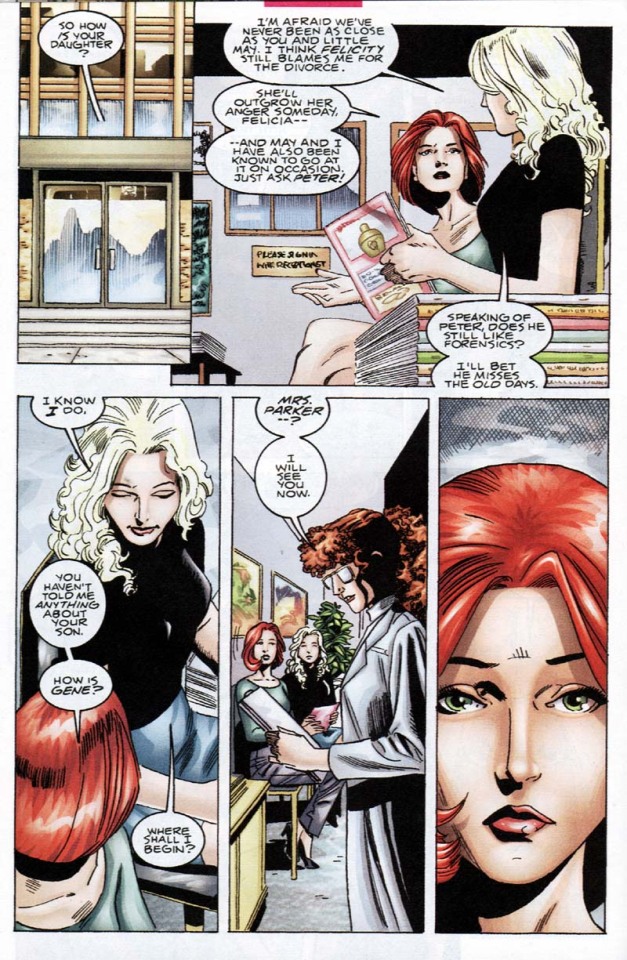

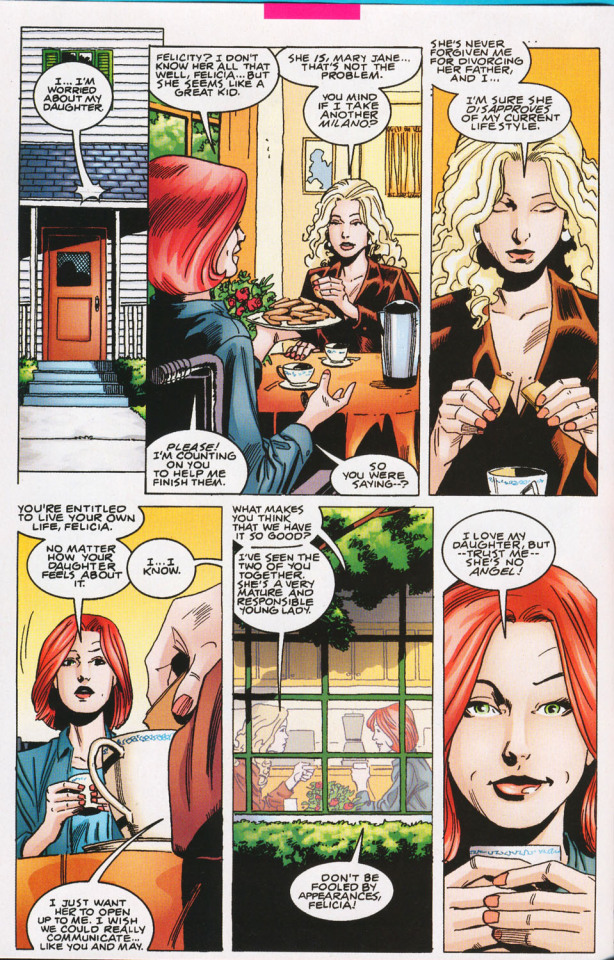
To bring this right around to your OP, the scenes of friendship have more or less happened in canon and in stories that are pseudo canon.
*Bear in mind this was the same decade where Sabertooth participated in the infamous Mutant Massacre storyline where he and his peers mass slaughtered a bunch of defenceless mutants. Readers knew he was no pushover.
**Because you see according to Joe Quesada, Steve Wacker, Dan Slott et al Mary Jane was clearly not dating Peter at this time and I think we’ve all brought groceries to our ex’s apartment (that we own a key to) in order to make them breakfast in bed. It’s the single most platonic gesture possible.
50 notes
·
View notes
Text
2019 August Update
"Shoot for the moon. Even if you miss, you'll land among the clouds." That's a quote ... that I think succinctly captures what transpired these past 2 months. A lot of progress... but the game is still not done >_<
(extra note: actual quote is land among the "stars", but stars seems like a higher goal was achieved, so I modified the quote).
Anywho, here are some of the things we have accomplished in the past 2 months.
--- ALBUM ART ---
With the sound track essentially done, Will requested some album art. So Pirate and I compiled a bunch of album art that we liked from other games, and from that Pirate made a bunch of concepts - and then we narrowed it down from there, with the 3 of us interjecting our opinions throughout the process, and Pirate doing all the heavy lifting. The album art will be revealed later. For now, here's a teaser of our initial brainstorm process.
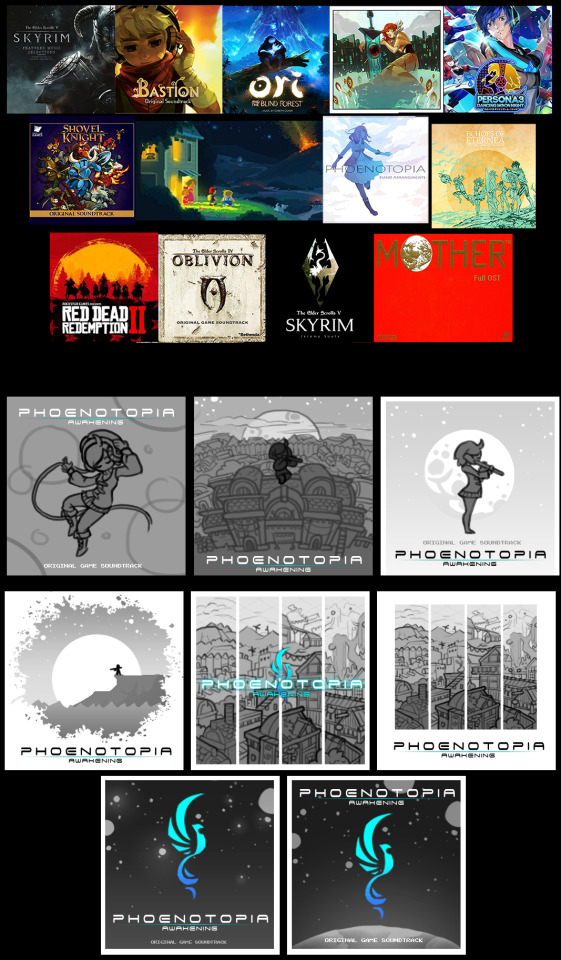
(round 1 : brainstorming and concepts)
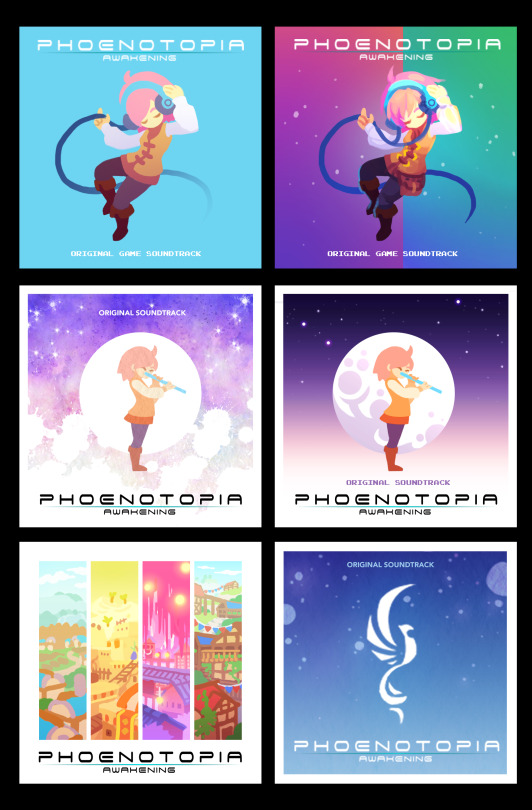
(round 2 : Survivors from round 1 progress a little more)
--- NEW BOSS ENCOUNTER ---
I thought the scope of what needed to be done for the game was settled, but while writing out the new ending sequence, one part started to drag. There was too much exposition, so after brainstorming a bunch of ways for how this new ending sequence could flow better, it became clear... There needs to be another boss encounter! This boss would really help the pacing of the scene, and it made nice thematic sense and tied up the game's whole story arc in a more satisfying manner. To avoid spoilers, I won't talk it too much, but here's a little silhouette teaser.
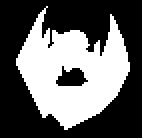
(hint: it's not a bat)
--- WRITING ---
Writing doesn't happen linearly since I'll skip around fairly often. It's a delicate balancing act - if I force myself to stick in one area before I move on, progress will grind to a halt, snagged on those last few unscripted lines due to writer's block. But if I skip around too much, the context switch takes some time in itself, and the game can't be enjoyed by playtesters. So for that reason, the beginning and ending sequences are now finished (excluding the credits roll...). But there's still a lot of middle parts to fill in and plenty of side quests still.
For example, there are ~90 NPCs in just Atai town. And each one will talk about 4 text boxes of dialogue (some more, some less). A bunch of NPC dialogue will also change when a big event occurs in the story. So there needs to be a healthy mix of NPCs that push the important story bits, NPCs that push side quest hints, NPCs that talk about geography or history, NPCs that are just for fun, etc. So there's a lot of variables to keep track of.
I've started thinking of better ways to manage it all. One of my new workflows is to use a spreadsheet.

Topics to cover exist in a column on the left. Lines to be spoken by NPCs are stacked to the right. A cursory glance at the spreadsheet lets me see which conversational topics could use more coverage, and so on.
I even took on new writing help in a young Mr. Cody. Taking on a new writer has been a process because it is not as simple as tossing them some NPCs and letting them run loose. There has to be a ramp-up period for the writer to become familiar with the lore and writing style. There are also unspoken rules about Phoenotopia's universe I implicitly understood and never had to think about. But now that I'm cooperating with someone, I've had to think about verbalizing what those rules are. It takes up more time, but in a weird way, having an outside perspective also helps me understand Phoenotopia more. I also find that I can push through my writer's block more easily when coming from a corrective angle.
I've been quite the strict taskmaster to the new writer, but he's been very resilient and teachable. He's also a great ideas guy. So look forward to Cody's contributions in the finished game!
--- PLAYTESTING ---
The long road of playtesting begins! As mentioned in my previous blog, my goal was to have my brother playtest the finished game during our trip. He didn't get to playtest the *finished* game, but he did get to playtest through a good 40% of it. The game is pretty complete in a linear fashion up until the 40% mark - after that, the rest of the game world exists but the NPCs have placeholder dialogue, and the cutscenes to connect the story events together are still unscripted.
But that wasn't too big a limitation because my brother only reached the 40% mark during the tailend of our trip. My brother preferred to play in 1-2 hour chunks throughout the trip (no marathon session on the plane as originally planned). I think it took him about ~15 hours to get through the game's first 2 chapters and a little extra - unfortunately, the game's timer bugged out so I don't have an exact figure.
Tons of useful information came out from his play test. I wrote down *127* things to fix based on his playthrough - some were small things, like adding more signposting. Others were big issues - a boss stage needed to be redesigned, a needed change to the control scheme, item dupe bugs, etc. I'll speak on some of the ones I've fixed so far here:
A. Warehouse Visibility Low
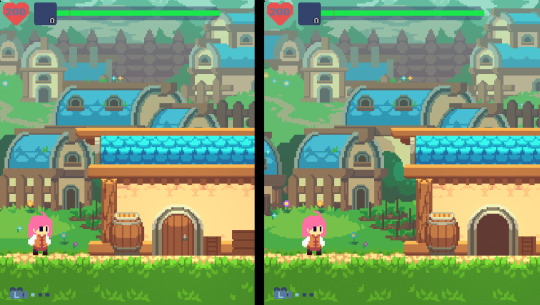
For some reason, when starting out my brother completely missed the warehouse where you'd find the starter weapon. He ran past it a few times. Upon inquiring him about it, he said he didn't think it was interactive. Sure enough, all the doors on the left start open, so I see how the misconception could form. When players experience a game for the first time, they're developing a mental image of the game's rules - what's interactive and what isn't. And this early on, the language for doors is still unclear. Per his suggestions, I made this door start open, and moved the camera's edge left a bit to make it less likely to be missed.
B. Eating instructions unclear
Another thing that didn't go as planned was the food eating tutorial. Early in the game, an NPC gifts the player a potato and asks the player to eat it there. After doing so, the NPC gives the player additional tips regarding food. But my brother actually just ran away with the potato so the rest of the tutorial didn't occur. But now with an additional subtle dialogue box, the player is more likely to behave as desired.
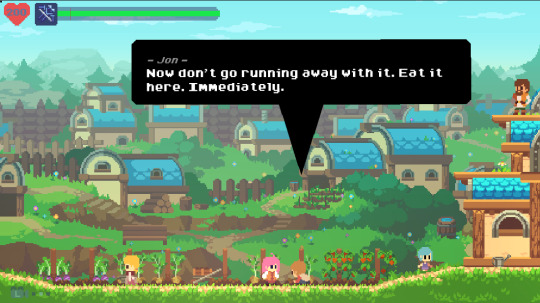
(If you design it right, the player won't know you're holding their hand at all)
C. Gear Ring Too Sensitive
youtube
One of the game's new features is what I now call the "Gear Ring". The player can equip 8 items to it and quick-access items/tools with a flick of the right control stick. My brother HATED this feature since it was too easy to flick it accidentally when reaching for the regular face buttons. I've now guarded the quick-equip behind an addition RIGHT-CLICK press. Add in a few more FX, and it now works and feels better!
D. Wrecker Too Hard

(In the old boss arena - the 3D printer on the ceiling just made the fight more confusing)
The game's difficulty to players is a big blind spot for me. My brother's no slouch when it comes to gaming. He's beaten all the Dark Souls games and he loves a challenge! So to see him get pulverized in 10 seconds (literally) was a clear sign that the boss was too hard. The boss is able to easily corner the player and there’s no clear opportunity to escape. So I've decided to rearrange the arena - get rid of the 3D printer above and add 2 platforms to the battlefield's edges. This makes the fight more manageable (for the first encounter).
E. Aerial Attacks Too Hard

(Each hit fills the meter at the bottom. Hit the speed bag 10 times in quick succession to win a prize!)
I love the current aerial attack system but there's a steep learning curve to it. Gail takes time to wind up her aerial swing so the player has to time it so that Gail's jump trajectory and swing coincide with the target. Swinging the bat too close to the ground will result in Gail not only failing to attack, she'll be punished with a short "landing lag" recovery state. So aerial attacks are hard it seems. Instead of revamping the system, which I'm still fond of, I've introduced an aerial training course disguised as a mini-game.
So that's a small snippet of some issues I'll sort through with playtesting. Once the game is further scripted, my plan is to do another round of playtesting, followed by fixing. Then rinse and repeat until the whole game is all polished. It seems there's still a long road ahead... So I apologize if I've gotten your hopes up!
--- FANART ---
Three new fan arts popped up in the last 2 months.

The first one is thanks to Cody. G, who's made many fanart submissions before. He continues to improve - really interesting choice of angle and great water effects!
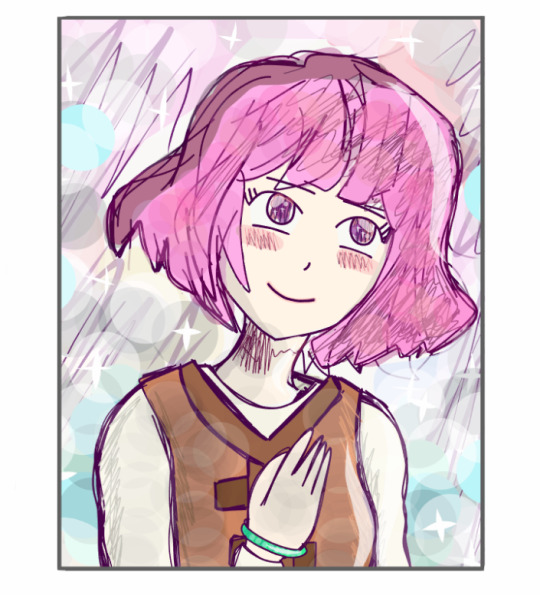
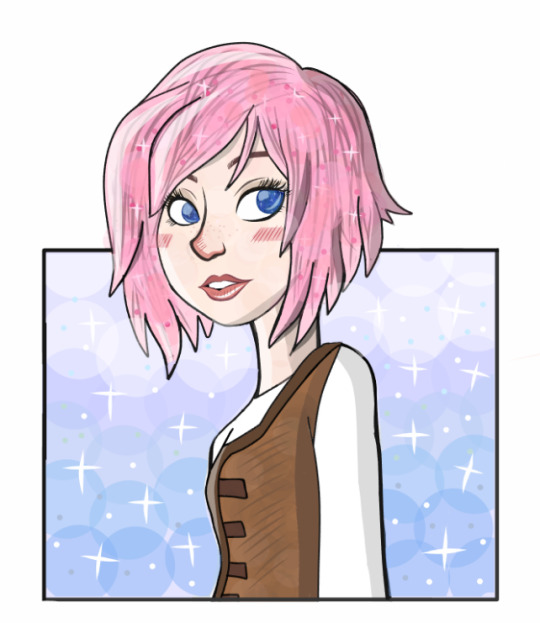
The next two are thanks to Shafiyahh on reddit. Both depictions are of Gale in 2 different art styles and angles. I really like the sparkling effects! Gale also has 2 different eye colors. Which do you think is more fitting?
That's all for now. We'll continue working diligently, and be back with another update come end of September.
51 notes
·
View notes
Note
Did you finish reading that KH3: A Conclusion without a story article? If so, what did you think of it?
I loved reading it. It was a fantastic take on KH3. There was pretty much nothing that I disagreed with.
By the time you leave Olympus, Sora hasn’t learnt how to restore his powers; and the frustrating part is that he never explicitly does.
I completely agreed with this. Sora’s journey in KH3 should have been about learning the power of waking. But even in the scene where he finally does learn it, there’s no real reason why. He didn’t seem to learn anything on his journey.
Even the villains are given no progress – a subplot about Pete and Maleficent looking for a mysterious black box goes nowhere, and Organisation XIII (the primary antagonists) only put in a brief appearance, spouting their usual brand of vaguely ominous dialogue. To compound these issues, the protagonists are ultimately left not knowing where to go or what to do next. Only two hours into the game, and the plot has no sense of momentum or direction.
Yep. The black box thing annoyed me so much. The Organization was also a huge letdown. We don’t get to learn the real reason why Marluxia, Larxene, Demyx, and Luxord joined until KH4!? Something went very, VERY wrong in the Dark Seeker Saga for that to happen.
By comparison, Kingdom Hearts II’s opening was significantly slower paced – to the point that it was a detriment to some players. However, so much more was achieved in a similar space of time; II’s initial hours establish the game’s tone and major themes, as well as introduce a large cast of brand new characters (while simultaneously reintroducing old ones in new contexts).
Yep. I liked KH2′s opening, slow as it was. The prologue of KH2 felt like it had more plot than almost all of KH3.
And this is one of the core problems with Kingdom Hearts III; even if you look past a threadbare narrative for Sora and company while they adventure through the self-contained Disney worlds, there is nothing going on outside of that either. In Kingdom Hearts II, both Riku and Mickey were operating behind the scenes, aiding Sora from the shadows and setting key events in motion. In III, however, these same characters spend most of their time expositing plot points and passively waiting for the big battle at the end of the game – and that can be said for almost all of our heroes.
I also agree. This problem would have been mitigated if every character got their own time to shine using the power of waking. Riku and Mickey could have had a subplot together, showing how Riku got his new Keyblade. They should have saved each other from the darkness.
If there’s a job to do, it’s up to Sora to do it. With a couple of key exceptions, every character apart from Sora, Donald, and Goofy is presented as almost comically useless – yet our protagonist remains the butt of every joke.
Yep. Everyone other than Sora was useless. Aqua needed to save Ven, but all she did was get knocked out in the battle with Vanitas. Ven needed to save Terra, but he didn’t really do anything. Sora did all the work. Lea needed to save Isa, but he did nothing in his fight. He got shoved to the side while Roxas and Xion took over. Kairi saving Sora should have gotten more focus.
The villains reveal that the only way Sora can release Roxas is by giving into the darkness, and sacrificing his own heart. Self-sacrifice is nothing new for Sora (he did the same thing in Kingdom Hearts I to save his love interest Kairi), but this had the potential to be an interesting plot point, as it gives him a selfless reason to be tempted by, and potentially give into, the darkness. But it’s never brought up again.
Yep. Early scenes in KH3 make it seem like the game did originally have an actual plot at one point. Xigbar was luring Sora into a trap, so he’d fall to darkness. But it’s never brought up again, LOL. It’s crazy.
In fact, ‘saving Roxas’ is scarcely discussed until the end of the game (King Mickey telling Sora to “let the rest of us worry about Roxas and Naminé for now”, essentially dropping the subject after only the second Disney world). Ultimately, Roxas’ heart just leaves Sora’s body of its own volition in the final act, making the player’s time here, once again, feel largely pointless.
And yes, saving Roxas was handled very badly. This is because, IMO, saving Roxas and saving Ventus was supposed to be one and the same. There shouldn’t have been a separate “saving Roxas” subplot.
In interviews, Nomura discussed the struggle of dealing with so many characters – even citing the cast size as one of the main reasons that Final Fantasy cameos were omitted[2]. The real problem, though, is that nothing is done to mitigate this challenge.
Yes, exactly. And treating Roxas and Ventus as separate characters only exacerbated this problem.
Upon leaving Twilight Town, the player finally begins their true journey – travelling to various worlds based on Disney properties and beating back the forces of darkness. But there’s no real set up for this; no distinct reason *why* we’re visiting these worlds.
Mm-hm. I think the issue was that we were supposed to learn more about Ansem the Wise’s data in KH0.5. That was supposed to give Sora a quest in KH3: search for the “Key to Return Hearts”. Once that game got cancelled, Nomura had no idea how to write KH3′s story any longer.
So around 3-4 hours into Kingdom Hearts III, the story still lacks a clear sense of direction and purpose, and hasn’t yet established any clear themes or deeper meaning.
Yeah, it’s sad because there was an underlying theme in the Disney worlds: the power of love and its ability to restore what was lost.
Kingdom Hearts III cleverly tries to frame its story through the lens of a chess match between two Keyblade Masters, Eraqus and Xehanort, when they were young. The game even opens on this scene, highlighting its importance. But chess has rules; logic; a clear sense of direction. Kingdom Hearts III’s narrative is akin to two people who don’t know how to play chess. They understand that they have to defeat their opponent’s king, but the rules of how to move their pieces, how to actually reach that coveted checkmate, are completely unknown to them. The characters in this game feel like pieces on a chess board with no rules; aimlessly moving back and forth across a limited space, until both players finally decide enough is enough and agree to bring their match to an end.
LOL. Yep. The fact that Xehanort had “reserve members” showed he had no idea what he was doing.
Stick to your guns – don’t be afraid to explore a good idea, or to develop the plot outside of your main protagonist. When so many previously proactive characters are in play, the story shouldn’t feel so static, or entirely dependent on the protagonist’s actions. The way your protagonist reacts to events and changing circumstances is just as important as the ones they play an active role in creating.
That’s why I liked the spin-offs. KH3 suffered from forcing you into only Sora’s perspective. Even Nomura said that the Keyblade Graveyard should have had everyone fighting their own battles.
Simply put, the Disney worlds in Kingdom Hearts III have no tangible impact on the game’s core narrative.
Sad, but true.
“In the end, although I had a hand in it as well, the flow of the dialogue and the stories of each world were largely handled by the level design team.” While I very much appreciate this standpoint of ‘gameplay first’, as well as the act of involving multiple teams in the execution of the story, these statements do prove my point. Set-pieces and events are one thing, but if there was a specific story to tell – with outlined themes to be explored, character conflicts to evolve, and goals to be achieved; all developed evenly throughout the entire game (Disney worlds included) - you would imagine the scenario would be built around balancing those narrative elements with the individual tales of each level.
Very interesting. The story in the Disney worlds was largely decided by the level design team? Wow.
Despite major villains such as Young Xehanort, Vanitas, and Marluxia making multiple appearances in their respective worlds, they generally just spout off trite exposition and then either disappear or summon a boss fight. Some villains don’t even know why they’re there, while others introduce plot points (such as the Black Box or the new Princesses of Heart) that are never utilised or expanded upon. As the game features at least thirteen main antagonists, these early appearances should have been integral in establishing their personalities, motivations, and the threat they pose to the player (as well as our heroes). In execution, though, they seem like little more than after-thoughts that offer hints of personality, but never go beyond the superficial – and certainly contribute nothing to the main narrative. This, I believe, is because Kingdom Hearts III doesn’t have a story to tell, but was instead content with treading water until its grand conclusion.
Yep. I had no idea why Marluxia, Larxene, and Luxord were running around in the worlds. Why are they back? Other characters, like Saix, were given flimsy “motivation”. All in all, the organization members were supposed to be vessels by the time you fight them in the KG. Hollowed out containers for Xehanort’s heart. Victims of mind control who you are supposed to have pity for. But they never felt like it.
Kingdom Hearts III’s meandering and vapid progression during ‘the Disney loop’ supports my argument that the game lacks a complete narrative and was merely concerned with reaching its final act. I believe this is most evident by the way in which the player is made to jump from world to world without any direction or purpose. Consequently, the majority of Kingdom Hearts III feels content to aimlessly ‘go through the motions’, setting a repetitive, humdrum pace and ultimately lacking the sense of narrative depth and genuine value that is integral to a great RPG.
Yeah, I believe there was–at one point–an actual plot for KH3. But after BBSV2 was cancelled, a huge portion of KH3′s plot was pretty much scrapped along with it and rewritten.
Everyone’s heard of the three-act structure; a model that forms the foundation of popular culture’s favourite stories. Act 1 features the setup and exposition; an ‘inciting incident’ to get the narrative moving. Act 2 is the confrontation; a midpoint which challenges the protagonist, pushing them to their limits. And finally, Act 3 is the resolution; concluding the plot, along with any character arcs introduced in the previous acts. While this structure doesn’t necessarily need to be adhered to, I believe it possesses something that Kingdom Hearts III sorely lacked – a midpoint.
Yep. KH3 had no mid-point. Scala ad Caelum could have worked as the mid-point. And it could have been another hub world like Radiant Garden. KH3 probably originally had this, but it was scrapped.
This is especially a shame, as Aqua’s fall into darkness – resulting in a twisted form that externalises all of her loneliest thoughts – is one of the most dramatically compelling aspects of the game. And that’s despite lasting for all of 10 minutes (a decade of solitude and suffering are seemingly erased by a few whacks from Sora’s Keyblade).
This is true for all of the characters that needed to be saved. Nobody really used the power of waking on anyone. It’s was just whack, whack, okay you’re saved.
And this is ultimately the problem with the lack of a true Act 2 – the characters aren’t explored or challenged when they need to be. The narrative refuses to escalate until its final act, at which point it feels like going from zero to sixty in a matter of moments. But during the heat of battle – at such a late stage, and with so many heroes and villains in play (more than twenty) – it’s hard to develop your characters in a way that feels natural. Kingdom Hearts III’s solution is bizarre soliloquies that are completely disconnected from the events around them. Is Sora in the middle of a boss fight with three villains? Well, the other two will disappear while you spend several minutes casually chatting with the third. And while this is partly due to the challenge of giving such a large cast an appropriate send-off, it’s also a direct consequence of the lack of time given to exploring characters and their relationships in the previous 20-25 hours of playtime.
So true. So many characters who had so much development over the series. That’s why they needed another game before KH3. It was probably too much to ask for KH3 to be the epic conclusion as well as dive into everyone’s backstory.
On that note, having some sort of hub – a place, like Traverse Town or Hollow Bastion in the first two Kingdom Hearts games, that the player regularly returns to – can be an effective way to centre your story. It provides a home base, and a recurring cast of characters that can be revisited at any time. This kind of location helps players to feel a deeper and more personal attachment to your world.
Yeah, the game would have been so much better if you could visit RG and interact with the plot-important NPCs.
Put in Kingdom Hearts terms, we might say that the body and soul are here; it’s just missing its heart.
I’ve had the exact same thought.
This essay began with the assertion that Kingdom Hearts III is a conclusion in search of a story; a game without a tale of its own to tell. So far, we’ve examined the material impact; the effect this has on the game’s pacing, its sense of player progression, engagement, and character development. So in this topic, I want to consider the conceptual side of things; the motivations that drive our heroes and villains, the purpose of the events that take place, and finally the meaning intended to be conveyed by the story. Put simply, does the narrative of Kingdom Hearts III have something to say?
Sadly, no. I can tell it was supposed to, though. KH3′s story was supposed to be about the power of love. It was really that simple.
By the time of Kingdom Hearts III, Riku has overcome all of these challenges and been granted the title of Keyblade Master, so it was important to present him as a more mature, capable character, having regained his confidence and developed a clear identity. But ultimately, he just feels bland and stoic in this game. He has no new narrative arc, relatively few interactions with Sora, predominantly serves as a mouthpiece for exposition, and is more devoid of a distinct personality than ever. And for a game which serves as a conclusion to the story so far, it’s essential that our core group of characters, such as Riku and Kairi, reach a satisfying crescendo. The narrative should organically involve them in significant ways, and the challenges they face should provide natural opportunities for growth and exploration.
Sad, since Riku seemed like he did originally have a narrative arc. He got a new Keyblade! But the way he got it was laughably random and meaningless and contributed nothing to his overall growth or development.
As much as I’ve tried to understand it, I cannot summarise Master Xehanort’s motivation in that same, concise way. His initial speech in Kingdom Hearts III implies idle curiosity; he speculates that “If ruin brings about creation, what, then, would another Keyblade War bring?” followed by statements that he wants to re-enact the conflict and simply see what happens. He also wonders if they will “…be found worthy of the precious light the legend speaks of”, implying that his goal is to test humanity; or at least the current generation of Keyblade wielders. But that’s a pretty flimsy motivation, and it’s lacking any context or logic.
Yep. Xehanort was supposed to have another game to explore his motivations. When you get rid of that, his character just doesn’t work anymore.
And it’s not just the heroes that have this problem. During their death scenes, several of the Organisation’s members (Luxord, Marluxia, Larxene, Xigbar, Xion, Saix, and Ansem) either encourage Sora or imply that they didn’t care about the outcome; or didn’t even want to battle in the first place. Some have their reasons, but if even one of them had chosen not to fight, Xehanort’s re-enactment could have failed. Much like I described earlier, it doesn’t feel satisfying to overcome a foe who didn’t want to fight, and a war with the potential to destroy the universe should be motivated by much more powerful convictions.
I don’t disagree. But I honestly think this is because none of these characters actually wanted to fight in the Keyblade War. They were supposed to be possessed puppets. Mind-controlled vessels with no will of their own.
Let’s use Saix as an example. What makes a more engaging battle? In canon, Saix had flimsy motivations to be fighting, anyways. He wanted to atone so he was acting as a double agent in order to procure some Replicas. And he wanted look for Subject X. That’s why he joined Xehanort. That’s all the reason he had to fight.
Compare that to a potential backstory with him as a vessel, lacking free will. Isa was a human test subject who was possessed as a teen. His best friend Lea has to fight him unwillingly. Saix is berserk and nearly kills Lea without even being aware of it. But all Lea wants is to save his best friend. I know which one I find more engaging.
Ever since that first game, I’ve been trying to identify what it is that unified these two styles of storytelling – the Disney fairytale with the SquareSoft RPG. And in writing this essay, I finally realised; the secret ingredient, the unifying thread that both franchises had in common, was love. Romance is at the core of almost every classic Disney film, and every Final Fantasy from IV to X was in some way a love story. Seemingly the developers of the original Kingdom Hearts realised this too.
I’m pretty neutral about the Sora/Kairi romance. I mainly wanted Kairi to not feel like a damsel-in-distress yet again. And KH3 definitely screwed that up.
In a way, my problem was the same as that of Kingdom Hearts III’s story. We both spent so much time looking to the horizon, imagining what the future may hold, that we missed out on what was already right in front of us. I will always love and support this series, and its creativity and charm will no doubt continue to inspire my own stories for the rest of my life. But despite not being the conclusion I hoped for, Kingdom Hearts III has freed me from my own obsession with the series’ future. I no longer feel like I’m waiting for something that may never come. Of course, I hope the series gets its story back on track, and rises to new heights greater than ever before! But it turns out that I already got my ending in 2006; and now that I’ve finally realised that, I can finally, honestly say that, as a Kingdom Hearts fan, I am satisfied.
It’s sad that KH2’s ending felt more satisfying. Because KH3 should have been even better than KH2′s ending. KH2 had a happy ending. But in KH3, everyone was there on the beach. Terra, Aqua, and Ven were saved. In KH2, Axel was dead. He had a sad ending. But in KH3, he was human again and even had his childhood best friend back, too. Even Hayner, Pence, and Olette were there. Sora should have been there, too. By all accounts, I should have liked KH3′s ending the best out of any game. But they ruined it with the horrible character development and the cheap cliffhanger.
4 notes
·
View notes
Text
The Judge Of All The Earth - Watchmen blog
(SPOILER WARNING: The following is an in-depth critical analysis. if you haven’t read this comic yet, you may want to before reading this review)

It’s time we turned our attention to Doctor Manhattan. Considering it’s his very existence that has created this divergent timeline in the first place, we’ve heard surprisingly little about him. We don’t even know where he comes from. While The Judge Of All The Earth doesn’t let us in on Doctor Manhattan’s origins (that’s saved for the next issue), this chapter of Watchmen places him front and centre of the action.
First it has got to be said that I really like Watchmen’s composition. It must have been severely tempting for Alan Moore and Dave Gibbons to reveal everything about Manhattan right out of the gate. Instead they drip feed us the information issue by issue, keeping us intrigued while also making an important point about the character.
See, what makes Doctor Manhattan such an important character is less to do with who he is and where he comes from, and more to do with the effect he has on the world around him. In my previous review of Absent Friends, I talked about how America having superheroes on their side has drastically shifted the global power dynamic. America is virtually untouchable thanks to Manhattan. They’ve won the Vietnam War, developed electric cars and become the most powerful nation on Earth. It’s also by using Manhattan that Richard Nixon has been able to stay elected for a third term as President. The Judge Of All The Earth expands on this, exploring some of Manhattan’s interpersonal relationships.

First we see Manhattan with Laurie. It was hinted in At Midnight, All The Agents that Laurie was unhappy with her relationship with Manhattan, hence why she reached out to Dan, and The Judge Of All The Earth exposes why. Because of his powers, Manhattan seems to be operating on a different wavelength to other people. He clearly no longer views sex with Laurie as a romantic act of intimacy, but rather as a mere biological need she requires. So, unbeknownst to her, he creates two clones of himself to pleasure her while he gets on with more ‘important’ work. It’s shockingly inconsiderate and Laurie understandably gets angry and leaves, but I never felt any anger toward Manhattan for his behaviour. Even when he made a pathetic attempt to appease her by saying ‘if you think there’s a problem with my attitude, I’m prepared to discuss it.’ It’s not that he’s being cold and uncaring. He does clearly care for Laurie, as evidenced by his reaction afterwards when we see him sitting on the bed looking forlornly at her discarded bra, but he’s clearly thinking and acting in a different plain of reality to ours. So things that would be obvious to you or I don’t come as easily to him.
Which leads to the issue’s central question. Is it possible for a godlike superhuman to care for other people? To which the answer seems to be... eh, kind of.
We see him give an interview on live TV where a journalist drops the bombshell that people he has been associated with, including his ex girlfriend, have died from or are currently suffering from cancer, heavily implying that Manhattan is the cause. It’s here where we see him display the most emotion he has ever shown so far, screaming at the mob of journalists and photographers to leave him alone before teleporting everyone to the roof. He’s clearly very upset by the idea that he might have given his ex and his best friend cancer and you do feel sorry for him to a degree... but then he leaves for Mars.

My feelings toward Manhattan have always been complicated. Out of all the characters in Watchmen, he’s always seemed the most well meaning to me. The only one I personally would call a true superhero. While undoubtedly as flawed as the others, he’s also, I feel, the one with the best intentions. He wanted to do right by his country, using his powers for the common good. Having said that, it’s hard to really square that with his cold and distant behaviour. The next issue focuses heavily on Manhattan’s past as we see his transformation from well meaning hero to emotionless deity, so I’ll try not to get into too many specifics here, but seeing how he thinks and behaves around other people is very disconcerting because you get the sense that while he may have had good intentions before, his reasons for his superheroics now are less than ideal. Just as he felt obliged to have sex with Laurie because that’s what she needed, Manhattan feels obliged to be a superhero because that’s what America needs. But in truth, Manhattan doesn’t need either. Because of his powers and his very nature, Manhattan is now above everyone around him. He doesn’t see a need for sex or intimacy and he doesn’t feel a duty to help his country or protect other people. He’s become detached from our world, and while the cancer reveal is upsetting for him, it also reinforces his view that the needs of the world are no longer important, especially considering he may have inadvertently been having a negative effect on the people around him, both emotionally and physically.
At the end we see him retrieve a photo of himself and his ex before departing to Mars, which could indicate that somewhere deep down he still cares, but I personally think it’s more of a memento to his past life as Jon Osterman. If Manhattan truly cared, he wouldn’t have left in the first place. His smile as he looks up at the stars before teleporting away speaks volumes. He’s happy that he’s pursuing his own goals and looking out for his own interests rather than other people’s, but this comes at a cost as we see shortly after that Russia, sensing America’s weakness, has invaded Afghanistan.

While the issue focuses mostly on Manhattan, we get other plot points too. We see romantic tension between Dan and Laurie build as they beat up a gang of muggers. I really like how this fight inter-cuts with Manhattan’s interview, where the dialogue ironically alludes to the two characters being sexually aroused by their actions. This sort of ironic, thematic paralleling is something Alan Moore has always been very good at throughout his career, and this is no exception as it reveals a bit more about the characters, particularly Dan. We know he’s attracted to Laurie and we know that part of the reasoning behind their costumed identities is to indulge in a power fantasy. The idea that there’s a sexual element to it as well doesn’t surprise me, and we’ll see that developed upon in future issues.
I also really liked the inclusion of the news-vendor and the kid reading Tales Of The Black Freighter.

These two characters reoccur throughout the series and some might argue that they could easily be cut out because they don’t really contribute much to the narrative, but I personally find their inclusion really important. Having focused exclusively on superheroes up until now, warped, misguided and uncaring as they are, it’s important that we see how the existence of superheroes affects normal people. We get to see the news vendor’s social attitudes change over the course of the issue, initially treating the kid with disdain and brushing off Cold War concerns altogether until Doctor Manhattan leaves and he reads the news that Russia has invaded Afghanistan, at which point we see him grow more considerate, realising the world could actually end after all, and letting the kid have his comic for free, saying ‘life is too short.’
Tales Of The Black Freighter, the comic the kid is reading and the narrative of which is interspersed with Watchmen’s at key moments, is also important because it foreshadows the looming sense of dread that’s approaching as well as giving us some extra historical context about this world. Of course superhero comics would go out of fashion if real life superheroes turned up. And I love the irony that it’s pirates that have become the new fad when pirates are also morally dubious individuals that get heavily romanticised by modern culture. It’s a small detail that adds colour and depth to the world of Watchmen.
The Judge Of All The Earth is a great issue that expertly raises the stakes and builds up the tension as we slowly venture into the story’s second act. Very enjoyable :)
6 notes
·
View notes
Text
My Good Neighbor, an Inko x Rei Neo-Noir AU
After her divorce and once she’s solely an out-patient, Rei becomes a Private Investigator Jessica Jones-style out of her new apartment in Musutafu. Her reason for this is in part to reclaim her independence, but also to help save others as she wished she could have saved her children. A Shiketsu graduate, she was only a sidekick for a brief time before she was married off to Endeavor and begins the lengthy process to re-acquire a hero license to then function as an underground hero. She finds that she needs assistance and finds it in none other than her neighbor, Midoriya Inko, who is a crime lab technician.
Inko introduced herself once Rei moved in next door but didn’t reveal her occupation until she wound up outside Rei’s office/living room when a disgruntled client started a fight in the apartment. Inko initially hesitates before going out and witnesses a man crash through the glass window of the door with a yell. The man recovers quickly and moves threateningly toward her but Inko whips out a beanbag shotgun she was hiding behind her skirt and tells him to back down. Rei emerges, a katana in hand, and the situation is diffused by the man’s departure via police car.
Rei didn’t have her license to use her quirk in the beginnings, and makes use of a “decorative” katana that came with her dowry so long ago. Enji had it hung up on a wall in a locked, clear case that only he had the key to, preserving family heirlooms he’d told her parents the last time she saw them, is a duty the Todoroki take with utmost responsibility. A lie to ensure her family’s legacy remained apart from their children-- another familial obligation to burden her heroic spirit with. Free of him, she’s taken it up again sans quirk and it is her main means of protection. Shouto is fascinated and awed by the sight of her wielding the blade so elegantly even all these years out of practice, and they bond over developing her ancestral style into something new, better suited to the modern era, and just theirs.
Rei’s feelings toward her relatives are mixed as they essentially sold her off, but her lessons in kenjutsu were some of the fondest memories of her adolescence and were what she had built her short-lived heroic persona around. Older and out-of-practice, she treats physical violence as a last resort, all the while honing her skills in the event of a throw-down. She leans into vintage-styled dress reminiscent of the classic trench-coat-and-fedora detectives of old-- and not so old, in Naomasa’s case-- but casual enough in appearance that she isn’t written off as a PI at a glance. Once she gets her hero license, a company creates several armored variants of her outfits-- proper costumes for undercover/underground hero work.
She investigates villains sure, but also heroes who are accused or suspected of corruption. Her ex-husband, regrettably, is still the Number One in the wake of All Might’s retirement and it’s a constant source of consternation and turmoil. Rei cannot put her own abuser away as it would threaten the tenuous balance between law and anarchy in their shaken society, and as much as she wants justice for her children if not herself, she knows that now is not the time. Shouto reassures her that once his class has graduated, they’ll oust Endeavor and carry the system on their shoulders better than their predecessors. She’s waited over 20 years-- she can persevere a while longer.
Rei realizes she needs to get forensic assistance from a new lab after spotting members of the Endeavor Agency at the usual place and only just escapes unnoticed. Rather than risk her ex-husbands’ possible spies she’ll have to take matters into her own hands so to speak. She registers her apartment as the headquarters for her own underground agency so she can set up a connected crime lab, but she struggles with what to call it. She’s foregone a proper hero name for much the same reason as her old name isn’t indicative of who or what she is anymore or what her goals are now. Up until now she’s been introducing herself as Rei-san, Private Investigator, hiding her re-earned hero status by omission, but with an agency she’ll need a name.
Shouto often comes by to discuss his life and the current bit of youth culture he’s adapting to, which it so happens to be video games that week. He’s intrigued by interactive visual stories he can alter on a whim and loves to delve into rich background lore because of the mysteries he can spend hours solving. Her family wasn’t so traditional that she never had the opportunity to partake herself, but its an area of interest long forgotten to her at present. Nonetheless, she likes listening to Shouto as he describes the plots and make decisions he instantly regrets only to yelp and hopelessly try to salvage the situation due to misinterpreted dialogue options, spends hours on menial low-reward tasks for the accomplishment alone, takes out aggression on enemies with silly exaggerated weapons and giggle at the absurd physics while doing so-- as he acts like a typical teenage boy.
He especially enjoys playing heroic characters, doing good because it’s what you should do and not because you are forced into the profession. She hopes she can be a hero idol for him where she failed as a mother, even if she’s making up for it now. They’re both surprised upon finding out that there is a hero who looks like her in the game! Shouto spent quite a while designing his character to look like him- as always- with long white hair, and in the costume provided looks astonishingly like Rei in her Media Appearance outfit: The Silver Shroud, operating out of the Memory Den. When she makes a quick change into her own outfit and stands beside the television, her adorable son can’t keep his head still as he notes all the similarities with stars in his eyes, and the decision is made for her. She’s the Silver Shroud and this is their Memory Den.
The decal on the glass of her door is changed from “Rei’s Investigations” to “The Memory Den” and she’s on her way. It’s soon after this that a man who was displeased to find that his lover was not cheating so he could force them to break up with him over the resulting confrontation barges in and threatens her for “ruining everything.” She tries to talk him down, but he is incensed, and they struggle briefly before she sends him flying out the glass with a measured application of her quirk and a kick to the chest. She’s surprised by the arrival of her next-door neighbor- a kind, small woman whose name is familiar though she can’t quite place it- leveling a shotgun at the man like she knows what she’s doing. The former client is forced to wait as Rei calls for a patrol car to take him away, leaving the two women alone.
Inko was recognized by the officers which initially led Rei to believe she was a cop herself before she properly introduced herself as a crime lab technician.
***
“Oh, I’m sorry for interfering with your work. If I’d known you were a hero I wouldn’t have gotten in your way! I just heard what sounded like a fight and a man’s voice and I know you live alone and I’m not an officer or a hero, but I have weapons’ training, so I thought—"
“No, no. It’s perfectly understandable. Rei smiled assuredly. Most people wouldn’t have tried to help, whatever the case, so that you did is admirable. You shouldn’t apologize for it regardless of my position.”
Flustered, Inko replied. “O-oh, well, I am sorry, I know most heroes would feel disrupted… but, um, at least let me say I’m glad you’re alright, then.”
“Likewise.” Rei gestured toward the shotgun, concern tilting her mouth into a frown. “Are you used to handling yourself? I had thought this area was safe.”
“Yes, I am. It’s, ah, not live munition- it’s loaded with beanbag rounds. I’ve only fired it once, though!” Inko sighed. “Honestly? It was safer when I first moved in, but that isn’t why I have Clem, here.”
“Clem?”
Inko flushed and jostled the shotgun pointedly. “Clementine. See, erm, there were… killings a few years ago. The victims were crime scene lab techs. My colleagues.”
Rei’s eyes widened.
“The villain thought it would damage public opinion of the police more than targeting the officers themselves, especially since most murders occurred within precinct walls during the day shift. We were protected, but the attacks stopped before a suspect could be apprehended.” Inko’s shoulder’s tensed. “I… I live alone, lived alone with only my young son, my quirk is nothing flashy and without knowing for sure…” Her eyes took on a hard edge as she met Rei’s slate stare. “Given the circumstances a judge gave me approval for a weapon for strictly defensive purposes, and hero patrols were increased for a while. Since All Might’s retirement, though, I… I- I can’t take any chances. I’ve seen less of the heroes which makes sense with the rise in crime, not to mention my shift increases. I’ve been getting home when it’s dark out in a neighborhood with fewer hero patrols in a poorer part of the prefecture. I know the statistics, and after the talking-to I gave my son about safety- I’m taking her everywhere with me.”
“I… I understand.” Rei replied. “I can wait for you if you like and escort you to your door. I tend to work at night anyway.”
“I wouldn’t want to be a bother! Its like I said, I can handle myself just fine.”
“You’re concerned for your safety and I am a hero.” Rei couldn’t let her go on like this after hearing her tale. “Please, I insist. …think of it as me returning the favor for your help today.”
“Well… alright. That’s fair. A relief knowing you’re right next door and everything.”
“Say…” Rei said pensively. “Would you happen to know if your facilities are partnered with the Endeavor Agency?”
Inko blinked once, twice. “I don’t believe we are. His office has their own lab and when they do cooperate with third-party investigators or the police its usually labs in Tokyo proper, nothing as far from the agency as Musutafu.”
Rei clapped her hands together before her, pleased. “Would you mind speaking more with me inside? I’m in need of a consultation- ah, if it isn’t an imposition, of course.”
“Sure.” Inko grinned. “We should probably get to know each other if we’re going to be seeing more of one another, too.”
“Can I offer you a coffee?” Rei said, stepping around the shattered glass to her apartment. “I, um, don’t have any tea.”
“I’m fine with anything, but a coffee would help my nerves right now.” Inko sighed shakily. She turned toward a source of noise in the living room. “Oh, is that Saving Face? I do enjoy a good love story.”
Rei carefully shut her door behind them and hurried to prepare her guest a drink with smile. The old film was a favorite from her time in the hospital. “As do I.”
***
Rei relies heavily on espionage, leveraging her good looks to coerce criminals into talking to her under the guise of flirting or gossiping with the out-of-place-bombshell at the dive bar. She wears her armored clothing, heels that contain data drives, and hides the katana inside her coats. She curls her hair and wears a hat to hide comms devices, and “smokes” from a cigarette holder that’s really a recording device. The cigarette is fake and shrinks to sell the image, as she would rather not associate with fire. When there’s a change in plans, she blows on it and the cigarette bursts like a smoke bomb for a quick getaway.
She meets with Naomasa in cafes while it’s raining, passes information disguised as a reporter during media blitzes, plants tracking devices on villains while playing the frazzled-and-late-for-carpool stay-at-home mom rushing by, etc. She tries not to rely too heavily on her quirk because it’s a distinct give away but isn’t afraid to overwhelm her opponents if pressed.
At home, most of the apartment has been converted into work space. Only the guest room where the children sleep when they visit is free of materials. Inko stops by every morning and afternoon to be briefed and transport evidence to or from her lab for processing. The two are fast friends, and Rei cherishes the closeness they’ve cultivated in the weeks since their encounter on her door step and they’re only growing closer-- which she's got butterflies about. The glass window is continuously destroyed by people sent flying through it to the point that they keep several replacements on hand.
Rei and Inko go out on day while their sons are waiting at the Memory Den and enter to find a quiet apartment. They find them in the guest room. Shouto is wearing Rei’s largest coat, her hat, and her blue ugg boots she got specifically for relief after long days in heels, standing over Izuku who is prone on the floor with ketchup over his body in several places, tongue out, clearly playing dead. The boys recreated one of her evidence boards and while Shouto reviews the clues out loud, Izuku intermittently offers his thoughts before ‘dying’ once more in dramatic fashion. Rei whips out her camera just in time to catch her son’s flustered waffling when Izuku calls him Shoushou- he has a nickname! - and Izuku hiding his face in his arms at being called ‘zukun’ in return. They watch for a few minutes and almost reveal themselves when Shouto chasing Izuku- now the criminal- around the room makes them laugh.
They finally do when Shouto proclaims, “Mama is the best hero this town has ever seen! She won’t let you hurt anyone else, villain.”
Rei pushes the door open, tears in her eyes. “You really think so?”
She hugs him so close and they have a good long cry about what could have been.
Rei’s most prominent case becomes the search for the serial killer burning their victims alive. It’s not a high-profile case, minimal media coverage to prevent inciting a panic, and the other investigators are a few underground heroes in coordination with the police. It comes to a head when a lead mentions a homeless man going simply by ‘Touya’ arriving in Musutafu around the time of Stain’s prominence and the continuation of the League of Villains’ recruitment schemes.
The investigation takes a darker note when they discover that quirkless people are disappearing in areas of suspected League of Villains activity likely to serve as the ‘base’ of new Noumu experiments.
Rei presses everyone for any information about a man named ‘Touya’ and when asked why she reveals, “My oldest son, it’s his name. He left home a long time ago and hasn’t spoken to me since. He fits the profile.”
“..the killer’s profile?” Naomasa nearly dropped his pen in shock.
“No.” Rei denied. “He couldn’t have burned those people. Not my boy.”
“Silver Shroud… Rei-san… if he has a fire quirk and matches the description—”
“That’s what I mean. It couldn’t have been him. Touya was born quirkless. He fits the profile for the Noumu experiments. That’s why I have to find him.”
Rei’s journey of self-actualization is embroiled in the search for her missing son, capturing villains, hunting a serial killer, confronting and abiding by the society which allowed her spirit to be broken, learning to forgive herself, and discover what it is to find love in the least expected places, and allow herself to be loved.
***
(Don’t make a new Inko x Rei AU when you haven’t published the first one. Don’t do it, bitch-
We’re here, I guess. I wrote this listening to My Love by Kovacs. This is super fun and occurred to me while playing Fallout 4 which is why she’s the Silver Shroud. Shouto having a grand old time being a hero in the wasteland in a Minuteman/Railroad run brings me joy to think about. It’s not like I also planned a Fallout AU or anyth-
Inksignia, Beyond Alteo is about half-done. I keep pushing it back to work on other things, but it’s coming along and will be published a thousand years before this one because I’m terrible.
Inko’s deal here is a subplot I haven’t fully thought through, I just really like tiny ladies with big guns and needed a suitable explanation. She recovers shells and beanbags with her quirk don’t tell no body. She doesn’t back up Rei on scene because Inko is not a hero and as someone who works with law enforcement, knows better than to interfere most of the time. Rei comes over to sleep at the Midoriya apartment because her own bed is usually a mess of paperwork and lordknowswhat that’ll take too long to organize. Rei shares Inko’s bed. snuggles
I spent an embarrassing amount of time looking into some of Rei’s outfits. She has several pairs of casual heels for spying under the guise of public outings and practical boots when she knows it’ll be a fight, or her patrols require them. She wears the kind of wool winter coats that are trench-coat-ish but ultimately fashionable, except in her Media Appearance outfit which is basically the Silver Shroud costume. Two hundred years later shit is up for free-use or whatever it doesn’t matter. The hat she favors is a black Bellady hat with a silver bow. I can provide links to anyone who wants a to see the stuff I picked. Keeping them out of the post so it doesn’t get flagged for links or whatever. Honestly, this should just be called the Aesthetic AU.
Quirkless Touya? From moi??? whatever do i mean hohohohohon
Slight todomido/izushou, mostly background. Inko x Rei endgame. Toshinori? Maybe??? Seriously can we create ship names for them. Inkrei. Reinko. Toshinkrei??? )
#bnha#neo noir au#inko x rei#silver shroud!rei#hero!rei#pi!rei#fo4#midoriya inko#todoroki rei#let rei be a midoriya#tododeku#todomido#izushou#todoroki shouto#let shouto be a midoriya#midoriya shouto#toshinkrei#inkrei#reinko#rei x success#midoriya izuku#long post#im only a little sorry
34 notes
·
View notes
Text
Jaku-Chara Tomozaki-kun – 01 (First Impressions) – Don’t Blame the Game

“You cannot lose if you do not play.”—Marla Daniels, The Wire
“I’m not fucking crazy … I’m just goal-oriented.”—Annie Landsberg, Maniac
Our protagonist Tomozaki Fumiya (handle nanashi) is teen with a dearth of social skills and friends and seeks solace and contentment in the world of gaming. In the first of a veritable festival of metaphors this show dishes out, he’s a god-tier player of the popular fighting game Tackfam, but a bottom-tier player in the Game of Life. As such, even though he splashes the popular Nakamura Shuuji in Tackfam, it’s Shuuji who leaves school flanked by two pretty girls.
This leads Fumiya—who is not a refugee from a war-torn nation—to declare “The game of life is garbage”, followed immediately by an establishing shot of his family’s above average-sized detached home in a quiet neighborhood, thence to his spacious bedroom with hardwood floors, a Mr. Slim, and his own entertainment center.
I actually laughed out loud at this juxtaposition, even if it wasn’t quite the show’s intention. Then I couldn’t help but think: This guy is a whiny loser and I don’t like him. But hey, that’s the point: I’m not supposed to! In stories like this, something or someone becomes a catalyst for positive change.

In this case, it’s a someone—a fellow gamer (handle NO NAME) who is second only to Fumiya in the Tackfam national rankings. Fumiya respects NO NAME a great deal, and when he plays him he can tell how much effort and dedication he puts into training. When NO NAME suggests they meet up IRL, Fumiya doesn’t hesitate.
Little does Fumiya know that not only is NO NAME not a guy, but she’s someone he already interacted with at school prior to their meet-up, as she extended him some obligatory class-rep friendliness upon learning he and Shuuji played. NO NAME is Hinami Aoi, the “it” girl at his school: top grades, top athletes, loved by all. He considers Aoi a god-tier player of the game of life, like Shuuji.
Thankfully, Aoi’s reaction to Fumiya being nanashi is spot-on: “This sucks,” she declares, quickly losing her interest in further interaction. Her reason is plain: just as Fumiya is in awe of her as a player of life, she was in awe of nanashi as a player of Tackfam. To learn the real nanashi is a “rock-bottom loser” who has “given up on life” is deflating, and in turn reflects poorly on her, since she pegged nanashi to be a better person IRL.

Voiced by the wonderful Kanemoto Hisako, in with a feminine strictness that had me wondering if Aoi was really Nakiri Erina with dyed hair and contacts, Aoi brings legitimacy to “polite rudeness”—a term I may have just made up—in her takedown of Fumiya. She also has just the right response when Fumiya protests that the game of life is unbalanced, and her “high initial stats” imbue her and those like her with baseless confidence.
What’s so satisfying about her response, and can be tied to the tightness and cleverness of the dialogue throughout the episode, is that she repeats to Fumiya the very same words Fumiya said to Shuuji when he called Tackfam trash: There’s nothing more shameful than blaming the game, especially when you’d barely played. Fumiya goes on to argue that you can’t change characters IRL…and that’s when Aoi takes his hand, and before he knows it, he’s sitting in her bedroom.
It’s at this point in the ep when I began to develop a measure of concern about the emergence of a somewhat unpleasant subtext: Aoi seemed to be going extremely out of her way to be this dude’s archetypal “guardian angel”. After all, what does she get out of helping him? You can say she’s simply being every bit the “good person” and “perfect heroine” Fumiya saw her as to this point: helping those in need help themselves.
But there’s more to it than that, which justifies the extent of her effort vis-a-vis Fumiya, which we learn when she invites him to her room…her very similarly-sized and appointed room:

They’re practically mirror images of each other! Whether this was intentional or the creator/producers simply drew up some normal high school kid rooms, I appreciated the symbolism. There’s common ground between Aoi and Fumiya: their passion for the games at which they excel. Aoi happens to be good at both Tackfam and life, but she shows Fumiya the latter success isn’t due to high base stats.
She does this simply by being who she is—someone Fumiya didn’t know—by appearing before him in cozier clothes and without makeup. She assures him he can attain normie-level looks just fine by practicing better expressions and proper posture. When Aoi watched Fumiya play as nanashi, she saw the same serious effort she applied IRL—in fact, she thought him more capable of effort than she!
So yeah, from where Aoi stands and how hard she’s worked, Fumiya doesn’t get to say the game of life is unbalanced garbage. He just needs to start applying the same effort of which he’s already proven more than capable in Tackfam. She’ll prove he can—and validate her ideals—by helping him out. Fumiya is initially dubious because he assumes Aoi ranks life higher than Tackfam, but when she reveals her belief that life is tied for first with Tackfam, he’s moved.
He’s moved because while he’s always gotten online recognition for his online efforts, those same efforts have netted him precisely zero friends and recognition…until he met NO NAME, who bridged the divide between games. In Aoi he finally has someone IRL who recognizes and moreover values his efforts.

As flawed as Fumiya is, he still recognizes his own hypocrisy and has a sense of honor, and is thus motivated to put more effort into “playing” life as Aoi suggests, so he can find out for himself if the game is actually good. This, along with Aoi using the Fumiya Reclamation Project as a means of continuing to grow herself, goes a long way towards making their budding relationship both balanced and compelling.
As for what form Fumiya’s training will take, well here’s where we must suspend disbelief in Aoi having a half-hour to spare in her clearly packed academic, athletic, and social schedule. They meet at the school’s deserted sewing room (where I thought for a moment she’d teach him how to make better clothes, LOL) and Aoi lays out an aggressive plan composed of large, medium, and small goals. The primary goal is “to be as satisfied with offline life” as she is.
Fumiya can see by the structure of the plan that it’s not all that different from how he trains for Tackfam, a realization Aoi was both counting on and appreciates as it will save some explanation time. She’s already given him a facemask behind which he must constantly smile behind in order to improve his expression (this leads to an awkward scene with his imouto, who asks him not to be more creepy than he already is).
But like Nakiri Erina, Aoi has no intention of going easy on Fumiya; considering she knows the effort he’s capable of online. He must acquire a girlfriend before starting his third year. Before that, he must get a third party to notice his appearance/vibe has improved, which has already started with the smiling training, but also means he must actually talk to at least three girls at school.
That’s no mean feat for a bottom-tier character in a game he’s barely played to this point, but part of improving one’s character involves occasional stumbling and ass-kicking (figuratively, of course). I notice there are four girls in the middle ground of the promo art, so I imagine Fumiya will start with one of them. So begins a long, fraught, but hopefully rewarding journey towards not thinking life is a garbage game. And as you can tell by how many words I’ve written about it, I’m game!

By: sesameacrylic
0 notes
Text
STRUGGLING TO COMMUNICATE

Struggling with communication ranks in the top of every relationship survey as the thing couple most need to improve.
Communication to a relationship is like oxygen to life. Without it…it dies. – Tony Gaskins In the ancient story of the Tower of Babel, when God wanted to separate people because of their growing pride, he didn’t pick them up physically and scatter them. He simply confused their language so that they no longer could communicate and they subsequently scattered. Confusion and the inability to communicate will likewise divide a couple so that they will continue to grow apart until they become strangers to one another…until their relationship dies. Before you read further, you might take a moment and watch this humorous clip of Sheldon and Amy from The Big Bang Theory television show. Pay attention to how each of them communicates and the reactions that they each have. https://www.youtube.com/watch?v=P563Z-hCdd8 Although the scene is funny, it depicts fairly accurately the communication process in far too many relationships. You can feel the frustration rising in Amy as she asks over and over for the butter. You can see how excited Sheldon gets when Amy begins to empathize with him as a way to get what she wants – the butter, and more.
THE DIFFERENCE BETWEEN MEN AND WOMEN
In a couple relationship, one of the greatest obstacles to communication is simply the different ways that men’s and women’s brains work. They are not

the same! The Female Brain by Louann Brizendine (2006) estimates that women speak about 20,000 words per day compared to 7,000 for men. A Family Life survey identified that on average men have 6,000 to 12,000 words to use per day. Women have 12,000 to 25,000 words to use per day. This disparity in number of words alone can cause conflict. One partner may feel overwhelmed and withdraw or shut down. The other partner then feels hurt, neglected, not heard, etc. COMMUNICATION BASICS Healthy communication should be a DIALOGUE, not a monologue. A daily dialogue is extremely important to keep the lines of communication open in your marriage. To ensure that you do this, agree that you will spend a minimum of 15 minutes per day talking with one another. To do this, you will need to agree upon the best time to communicate and then each commit to make it happen. We suggest that you have a “Daily Dyad.” A dyad is when two people sit face to face and look each other in the eye and communicate. Open body position is important as it signals your desire to connect with your spouse. Communication involves both verbal and non-verbal components. Verbal communication involves spoken words, written words and voice tone. What we say matters but how we say it really matters more. What we don’t say also matters – This can be passive aggressive behavior. Holding thoughts hostage until a ransom is paid. In other words, “I’m not telling him/her this as a way of punishing them.” Non-verbal communication is just as important as verbal. Remember this from speech class? Communication is 7% Spoken Words; 38% – Tone of Voice; 55% - Body Language Are you making eye contact? Are your arms open or folded? How close are you to each other when you are talking? Does your body language say that you are relaxed or tense? What does your facial expression convey? Are you fidgeting, or worse, checking your cell phone? “Hearing” and “listening” are two different things. Hearing is passive and requires little mental effort and no personal investment. Listening is active and demands personal investment. In the book ‘The Facilitator’s and Trainers Toolkit‘ a business book by Artie Mahal, he provides a basic technique that might help improve your listening skills as a couple. It is called the LADDER method. It has been changed slightly to apply to couple communication. L ook at the speaker-make eye contact A sk questions when appropriate D on’t interrupt the speaker D on’t change the subject E mpathize-even if you don’t agree R espond -verbally and nonverbally. Listening, really listening, to each other makes each of you feel of value and worth. It’s one of the best gifts that you can give your mate and it doesn’t cost anything except a little of your time.
Five Levels of Communication
There are five levels of communication according to Gary Smalley in his book, Secrets to Lasting Love, Clichés /Surface – Typical, routine, oft repeated comments, questions and answers given out of habit and with no real forethought or genuine intent. “How are you?” “Fine.” “How was the weekend?” “Great, and yours?” Facts – Information/statistics about the weather, the office, friends, the news, personal activities, etc. Requires no in depth thinking or feeling. Opinions – Includes concerns, expectations, and personal goals, dreams and desires. Due to differences of opinion that naturally arise between two people, especially between men and women, this is typically the level at which we engage in conflict. Many couples do not make it past this level. Feelings – Sharing deep emotions. Sharing deep emotions can be frightening or confusing to some. For those who grew up in an environment where feelings were not expressed may have a harder time initially identifying and sharing them. But don’t be concerned, it is a skill that can be learned with a little effort. Needs – The deepest, intimate level of communication where you feel completely safe to be transparent and reveal your deepest needs to each other. In most cases, couples desire to meet each other’s needs. However, sadly, very few couples reach this level of communication. We want our spouse to just “know” what we need. It is extremely unfair to expect our spouse meet our needs if we are unwilling or unable to express them As you read through the five levels of communication, which seemed to describe the most common level of communication between you and your mate? Sadly, many couples don’t make it past the level of “Opinions”. It is too difficult, or too scary, to open up and share feelings or to be vulnerable enough to share what you need with your partner. Enemies of Communication Distractions – These can be the computer, TV, text messages, children or pets, work related interruptions. It is important that you make eye contact to help overcome distractions. In other words, learn to listen with your eyes. It shows great respect to your spouse when you look at them when they are talking. Habit – We can develop habits in communication that can lead to surface conversations and sharing facts. “How did you sleep last night?” “Just fine, you?” “Well, my back was hurting, so I couldn’t get comfortable” “Did you feed the dogs? “Yeah, I did. Will you pick up the dry-cleaning on your way home from work?” “Sure, no problem, if you’ll start dinner.” “Okay. See you tonight.” “Bye.” Timing – There’s a right and wrong time for conversation. Be aware of your environment. Don’t have private conversations in public. Don’t open unresolved conflicts when you’re celebrating something. Be mindful of fatigue …or the big game! Try to address one topic at a time…don’t overwhelm your listener! HALT: Hungry, angry, lonely or tired? Halt the conversation if these emotions are present. You will both be glad that you did. Impatience – “I already know what he/she is going to say, so let’s just get to the end of this conversation. Why do I have to go through the entire process?” Defensiveness – Instead of hearing what your spouse is saying, and trying to hear what they are really trying to communicate, you’re thinking of what you’re going to say in response to what they’re saying. It’s okay to pause after they’re done with their statement to gather your thoughts before speaking…or even to schedule a time to respond later if there’s just too much to process at that moment. When your spouse is speaking, make it all about them! To Think About: On a scale of 1 (low) to 10 (high), rate your communication in the areas of frequency and intimacy. At which of the 5 levels of communication are most of your conversations with your spouse? How confident are you in your skills in resolving the conflicts that arise after expressing differing opinions? Are you comfortable sharing your emotions and needs with your spouse or fiancé? What can you do to foster a safe environment for sharing emotions and needs? What one aspect of your communication as a couple would you like to change? Why? Which of the enemies to communication do you struggle with the most? If you struggle with communication, don’t think that it will get better on its own. You must be intentional and take action to improve your communication with your mate. LoveRecon seminars and ReconCoaching are two good options to explore in seeking marriage help. Let us know if we can help! Read the full article
0 notes